
CSA BOX CONTENTS WEEK OF JULY 3RD
07/04/17 — Scott
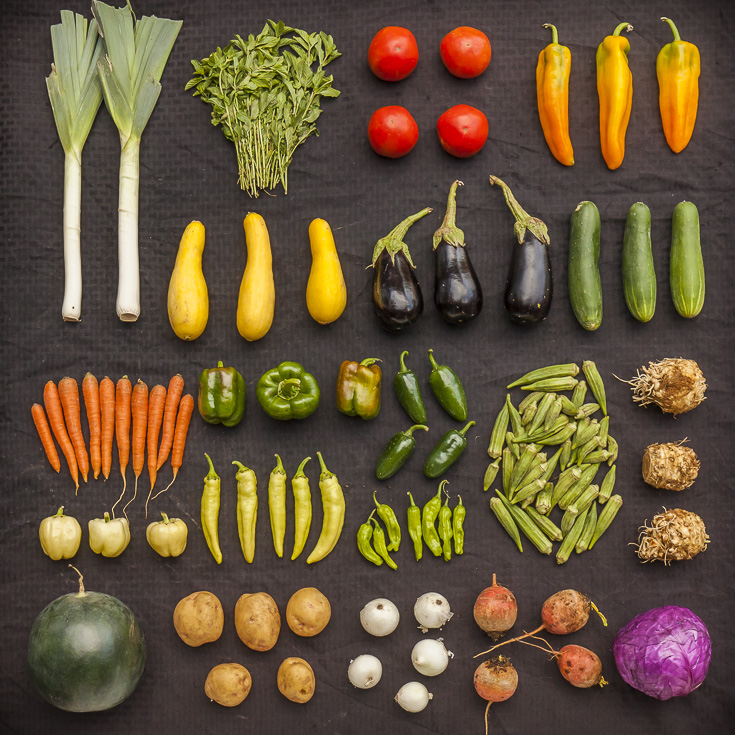 CSA Box Contents Week of July 3rd
CSA Box Contents Week of July 3rd
Large Box
Carrot, Rainbow
Cucumber
Eggplant , Black
Greens, Sweet Potato
Leek
Melon, Farmers Choice
Okra
Onion, Yellow
Pepper, Sweet Medley
Potato, Yukon Gold
Squash, Butternut
Squash, Zucchini
Tomato
Carrot, Rainbow
Cucumber
Eggplant , Black
Greens, Sweet Potato
Leek
Melon, Farmers Choice
Okra
Onion, Yellow
Pepper, Sweet Medley
Potato, Yukon Gold
Squash, Butternut
Squash, Zucchini
Tomato
Medium Box
Carrot, Rainbow
Cucumber
Eggplant , Black
Melon, Farmers Choice
Okra
Onion, Yellow
Pepper, Sweet Medley
Potato, Yukon Gold
Squash, Zucchini
Tomato
Carrot, Rainbow
Cucumber
Eggplant , Black
Melon, Farmers Choice
Okra
Onion, Yellow
Pepper, Sweet Medley
Potato, Yukon Gold
Squash, Zucchini
Tomato
Small Box
Beet, Red
Eggplant , Black
Leek
Melon, Farmers Choice
Pepper, Sweet Medley
Potato, Yukon Gold
Squash, Zucchini
Tomato
Beet, Red
Eggplant , Black
Leek
Melon, Farmers Choice
Pepper, Sweet Medley
Potato, Yukon Gold
Squash, Zucchini
Tomato
Individual Box
Melon, Farmers Choice
Onion, Yellow
Pepper, Sweet Medley
Squash, Butternut
Squash, Zucchini
Tomato
Melon, Farmers Choice
Onion, Yellow
Pepper, Sweet Medley
Squash, Butternut
Squash, Zucchini
Tomato
CSA BOX CONTENTS WEEK OF JULY 3RD
07/04/17 — Scott
 CSA Box Contents Week of July 3rd
CSA Box Contents Week of July 3rd
Medium Box
Beet, Golden
Cucumber, Slicing
Eggplant , Black
Leek
Melon, Farmers Choice
Onion, White
Pepper, Sweet Medley
Potato, Red
Squash, Yellow
Tomato
HONEYDEW AND GREEN TOMATO GIMLET
07/05/17 — Heydon Hatcher
Recipe by Nadia Tamby
This twist on a classic gimlet is the epitome of summer - the sweet juicy honeydew is a perfect contrast to tart -- almost grassy -- green tomatoes. Gins are distilled with various botanicals such as juniper berries, so using a fresh herb like basil is the perfect complement to those earthy spices. This is a great cocktail to make for a small crowd - you can prep all the ingredients the day before and serve it out of a pitcher. Save some of that tomato water - it's refreshing on it's own and makes for a great hangover cure!
![Photo by Rick Cortez]() Photo by Rick Cortez
Photo by Rick Cortez
Ingredients:
Honeydew melon - green tomato water: Puree half a honeydew melon with the same volume of quartered green tomatoes (add a small amount of water to get your blender going, if needed)
Strain through a fine mesh sieve and chill until ready to use
![Photo by Rick Cortez]() Photo by Rick Cortez
Photo by Rick Cortez
Basil simple syrup: Combine 1 cup of sugar and 1 cup of water and bring to boil
Remove from heat and add 1 cup of basil leaves (packed in tight) and cover for 10 minutes to let basil leaves steep
Pour syrup through a sieve to remove leaves
Instructions: Place all ingredients in shaker with ice and shake until frothy
Pour into glasses and garnish with basil
![5J9A5904]() Photo by Rick Cortez
Photo by Rick Cortez
This twist on a classic gimlet is the epitome of summer - the sweet juicy honeydew is a perfect contrast to tart -- almost grassy -- green tomatoes. Gins are distilled with various botanicals such as juniper berries, so using a fresh herb like basil is the perfect complement to those earthy spices. This is a great cocktail to make for a small crowd - you can prep all the ingredients the day before and serve it out of a pitcher. Save some of that tomato water - it's refreshing on it's own and makes for a great hangover cure!
 Photo by Rick Cortez
Photo by Rick Cortez
Ingredients:
- 3 oz honeydew melon - green tomato water*
- 2 oz fresh lime juice
- 5 oz gin (The Botanist is what I used)
- 2 oz basil simple syrup*
- Fresh torn basil to garnish
Honeydew melon - green tomato water: Puree half a honeydew melon with the same volume of quartered green tomatoes (add a small amount of water to get your blender going, if needed)
Strain through a fine mesh sieve and chill until ready to use
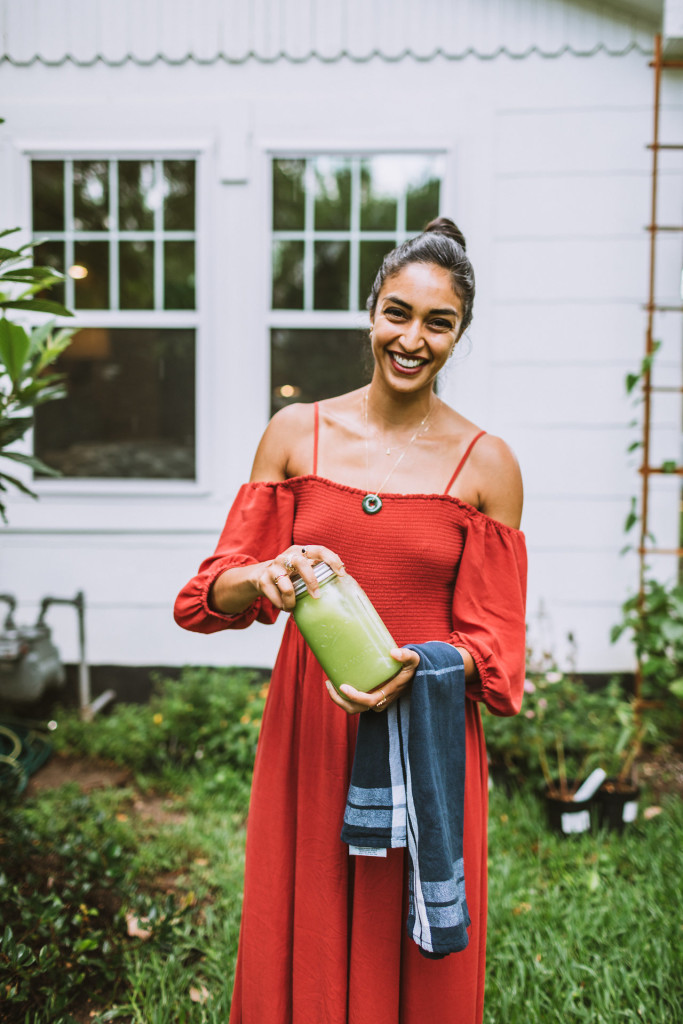 Photo by Rick Cortez
Photo by Rick Cortez
Basil simple syrup: Combine 1 cup of sugar and 1 cup of water and bring to boil
Remove from heat and add 1 cup of basil leaves (packed in tight) and cover for 10 minutes to let basil leaves steep
Pour syrup through a sieve to remove leaves
Instructions: Place all ingredients in shaker with ice and shake until frothy
Pour into glasses and garnish with basil
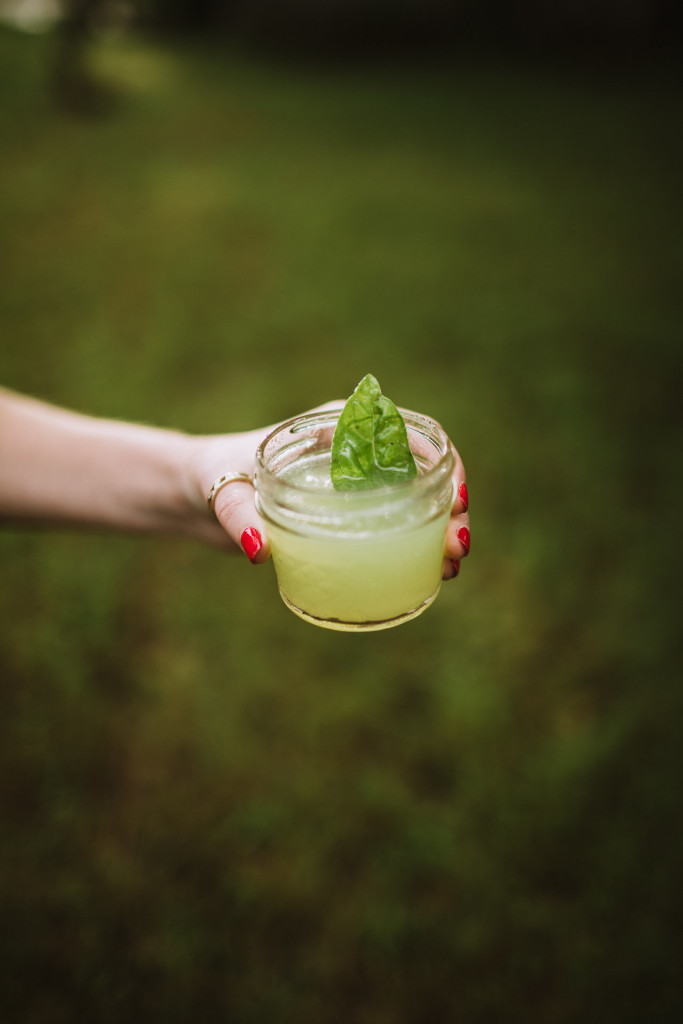 Photo by Rick Cortez
Photo by Rick CortezTWO TAKES ON BASIC TOMATO SAUCE
07/06/17 — Heydon Hatcher
This recipe can easily be made with our Large Homegrown Tomatoes, Red Roma Tomatoes, San Marazanos, or Inglorious Slicers. Make your order here before our bulk sale is long gone!
![Photo by Rick Cortez.]() Photo by Rick Cortez.
Photo by Rick Cortez.
Recipe by Elaine DiRico
Thirty seven years ago today, a friend brought me a bushel of VERY ripe tomatoes. It is easy to remember the date because my son, Tony, was born the next day. Last week, I flashed back to spending the night canning when I picked up my 25 lbs of tomatoes from Johnson’s Backyard Garden. In 1980, I was in Tennessee, had no air conditioning, and oh yeah, the pregnancy thing. This time was going to be a breeze.
While my ex-grandmother-in-law peeled and seeded her tomatoes for sauce, I didn’t even core mine. As with many fruits and vegetables, the skins and seeds carry a lot of the nutrition. I halved them, then quartered them, as these were large, and packed into my Instant Pot. I used a potato masher to crush them down, and pressure cooked them for 6 minutes. I crushed them again, left the lid off and slow cooked them for 7-8 hours. When they cooled a bit, I used an immersion blender to break them down further, then a food mill to get a smooth sauce. Back into the slow cooker for another four hours, watching carefully so it cooked down without burning. I ended up with two quarts of intense sauce.
Since it is just the two of us, I packaged it in small zip lock bags. A trick I learned to make this easier: use a pint measuring cup, place the plastic bag in it, like a liner, and ladle in the sauce. Labeled and stacked, this keeps 6-9 months frozen, but is usually used up well before then.
Now we can get fancier… I am busily writing a series of articles on cooking gadgets, and how well they can simplify preparing healthy and nutritious food. Because of this, I have a ton of gadgets, including a dehydrator. Great Grandma DiRico was reputed to make a sun-dried sheet of ‘tomato leather’ so I decided give it a try. Because the tomatoes are low in pectin, for every eight tomatoes I added a Granny Smith apple, but otherwise it was prepared the same way.
There are special sheets available for making fruit leather with a dehydrator, or a piece of parchment paper cut to fit works just as well. Brush olive oil on the paper, then spread a ¼” layer of tomato paste across it and place in the dehydrator tray. Mine took 8 hours to dry, so overnight. While it can be stored at room temperature in a sealed container to protect it from bugs, it went easily into a bag and into the freezer. I know Grandma used it to make her sauce, but I am really liking it cut in strips in a salad as well.
![Photo by Rick Cortez.]() Photo by Rick Cortez.
Photo by Rick Cortez.
In a 6 quart stew pot, warm the olive oil over medium heat. Add in the onion, garlic, basil, oregano and salt and pepper. Stir and cook just until you can smell the garlic, about one minute then add the remaining ingredients. Crush the tomatoes with your hands as you add them. Cook over medium heat until it boils, then drop to a simmer and cook over low until reduced by half, perhaps 45 minutes.
Let cool; taste for seasoning. This freezes well, but is not acid enough to can in a water bath. I have heard that a spoonful of citric acid can help, but I am too lazy, and stick with freezing. I like my sauce with pieces of tomato intact, but it can also go through a blender or food processor and/or food mill.
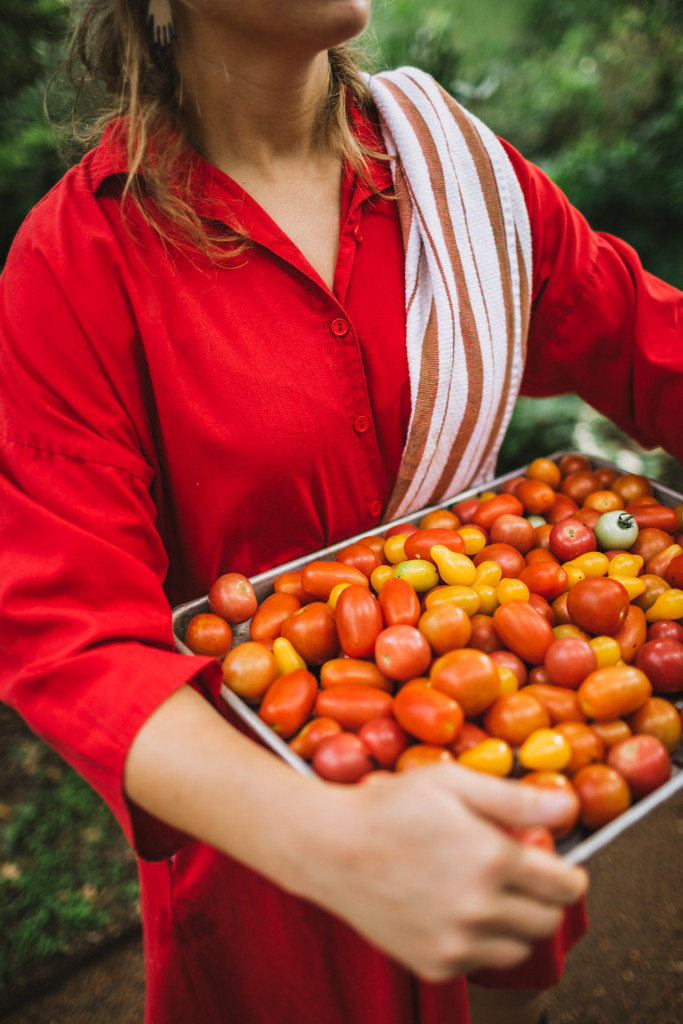 Photo by Rick Cortez.
Photo by Rick Cortez.
Recipe by Elaine DiRico
Thirty seven years ago today, a friend brought me a bushel of VERY ripe tomatoes. It is easy to remember the date because my son, Tony, was born the next day. Last week, I flashed back to spending the night canning when I picked up my 25 lbs of tomatoes from Johnson’s Backyard Garden. In 1980, I was in Tennessee, had no air conditioning, and oh yeah, the pregnancy thing. This time was going to be a breeze.
Basic Tomato Sauce
- 12 lb of tomatoes, washed
While my ex-grandmother-in-law peeled and seeded her tomatoes for sauce, I didn’t even core mine. As with many fruits and vegetables, the skins and seeds carry a lot of the nutrition. I halved them, then quartered them, as these were large, and packed into my Instant Pot. I used a potato masher to crush them down, and pressure cooked them for 6 minutes. I crushed them again, left the lid off and slow cooked them for 7-8 hours. When they cooled a bit, I used an immersion blender to break them down further, then a food mill to get a smooth sauce. Back into the slow cooker for another four hours, watching carefully so it cooked down without burning. I ended up with two quarts of intense sauce.
Since it is just the two of us, I packaged it in small zip lock bags. A trick I learned to make this easier: use a pint measuring cup, place the plastic bag in it, like a liner, and ladle in the sauce. Labeled and stacked, this keeps 6-9 months frozen, but is usually used up well before then.
Now we can get fancier… I am busily writing a series of articles on cooking gadgets, and how well they can simplify preparing healthy and nutritious food. Because of this, I have a ton of gadgets, including a dehydrator. Great Grandma DiRico was reputed to make a sun-dried sheet of ‘tomato leather’ so I decided give it a try. Because the tomatoes are low in pectin, for every eight tomatoes I added a Granny Smith apple, but otherwise it was prepared the same way.
There are special sheets available for making fruit leather with a dehydrator, or a piece of parchment paper cut to fit works just as well. Brush olive oil on the paper, then spread a ¼” layer of tomato paste across it and place in the dehydrator tray. Mine took 8 hours to dry, so overnight. While it can be stored at room temperature in a sealed container to protect it from bugs, it went easily into a bag and into the freezer. I know Grandma used it to make her sauce, but I am really liking it cut in strips in a salad as well.
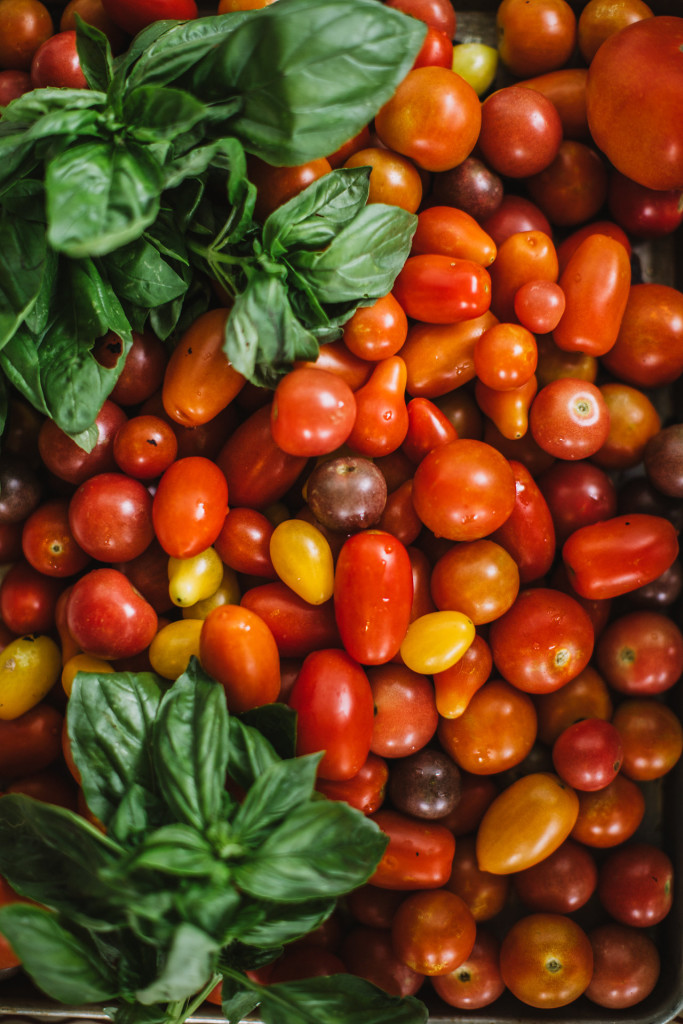 Photo by Rick Cortez.
Photo by Rick Cortez.
Tomato Sauce 2
- 10 large cloves garlic, coarsely chopped
- 1/2 cup fresh basil leaves, torn
- 1 medium onion, coarsely chopped
- 1 teaspoon dried oregano or 1 Tablespoon chopped fresh leaves
- 1/2 teaspoon each salt and freshly ground black pepper
- 1/4 cup extra-virgin olive oil
- 12# mixed ripe tomatoes, quartered and peeled if the skin is thick
- 1 ½ teaspoons Worcestershire sauce
In a 6 quart stew pot, warm the olive oil over medium heat. Add in the onion, garlic, basil, oregano and salt and pepper. Stir and cook just until you can smell the garlic, about one minute then add the remaining ingredients. Crush the tomatoes with your hands as you add them. Cook over medium heat until it boils, then drop to a simmer and cook over low until reduced by half, perhaps 45 minutes.
Let cool; taste for seasoning. This freezes well, but is not acid enough to can in a water bath. I have heard that a spoonful of citric acid can help, but I am too lazy, and stick with freezing. I like my sauce with pieces of tomato intact, but it can also go through a blender or food processor and/or food mill.
WEEK 27 IN PHOTOS
07/07/17 — Heydon Hatcher
 Photo by Scott David Gordon.
Photo by Scott David Gordon.
Week 27 and melons are flying out of the field (illustrated above). The heat is ceaseless, but the farm work must trudge on as per usual. Our field crew is the toughest in the business, and we are so grateful every day for their hard work. Hop over to the markets this weekend for a beautiful array of melons! Read more about all our different varieties here.
 Malabar. Photo by Scott David Gordon.
Malabar. Photo by Scott David Gordon.
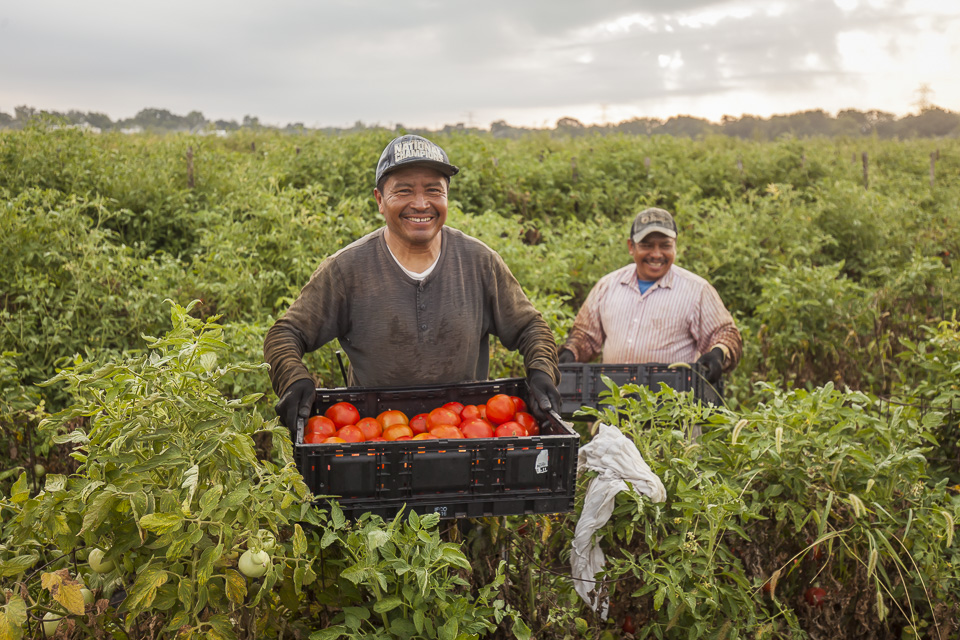 Smiles for the 'maters. Photo by Scott David Gordon.
Smiles for the 'maters. Photo by Scott David Gordon.
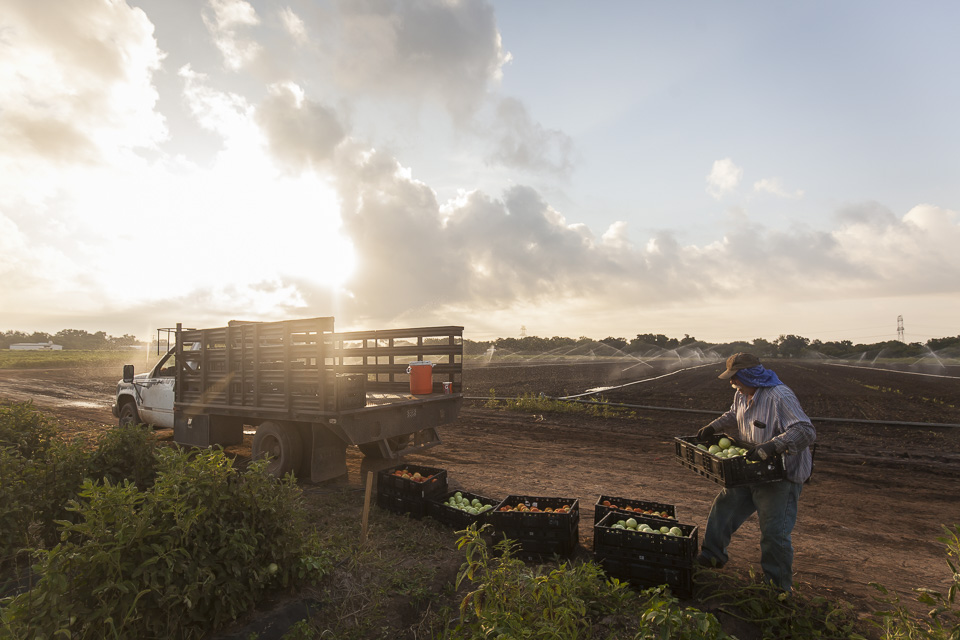 Photo by Scott David Gordon.
Photo by Scott David Gordon.
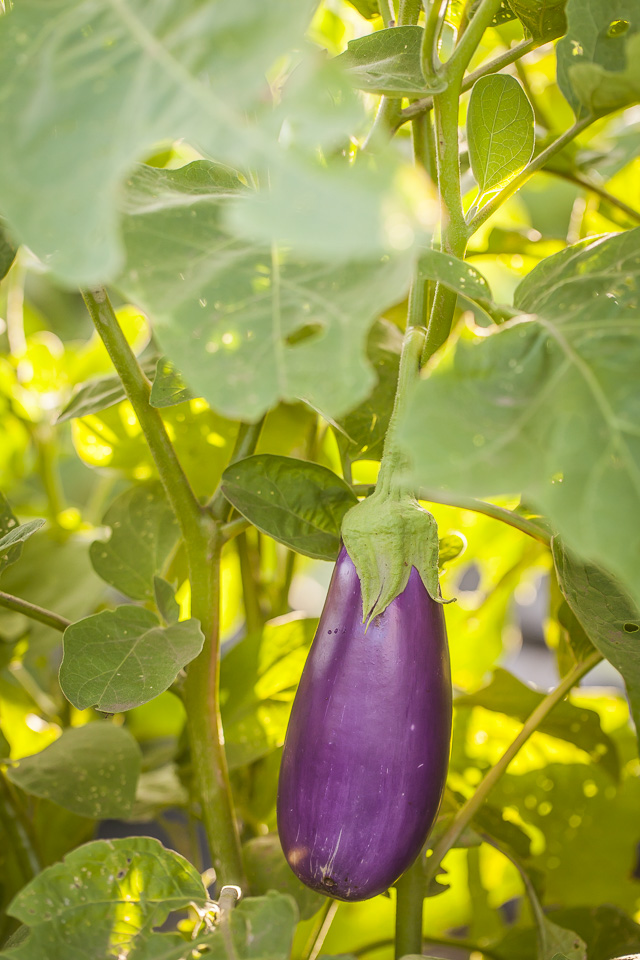 Purple eggplant. Photo by Scott David Gordon.
Purple eggplant. Photo by Scott David Gordon.
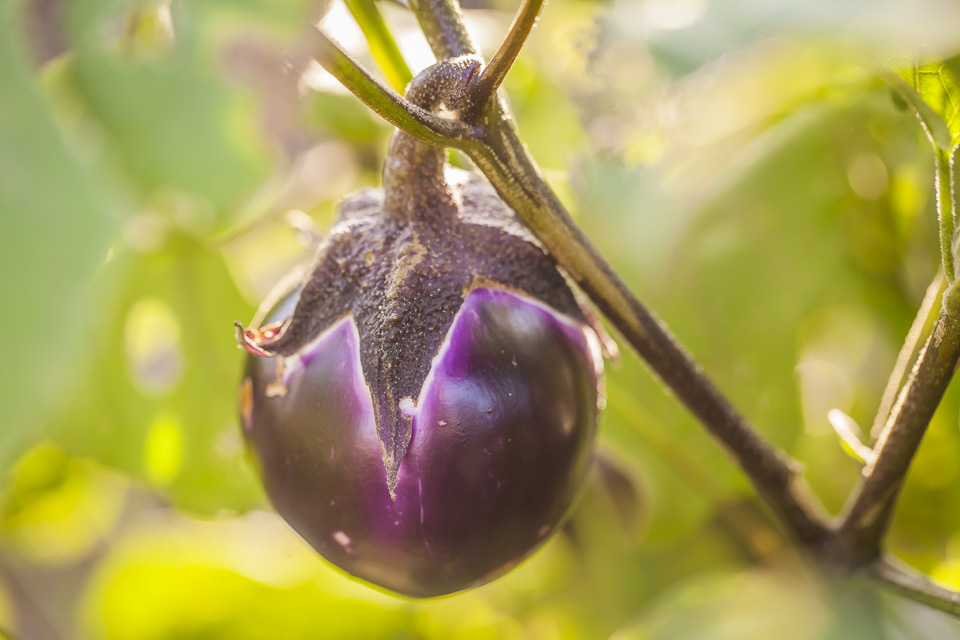 Italian variety of eggplant. Photo by Scott David Gordon.
Italian variety of eggplant. Photo by Scott David Gordon.
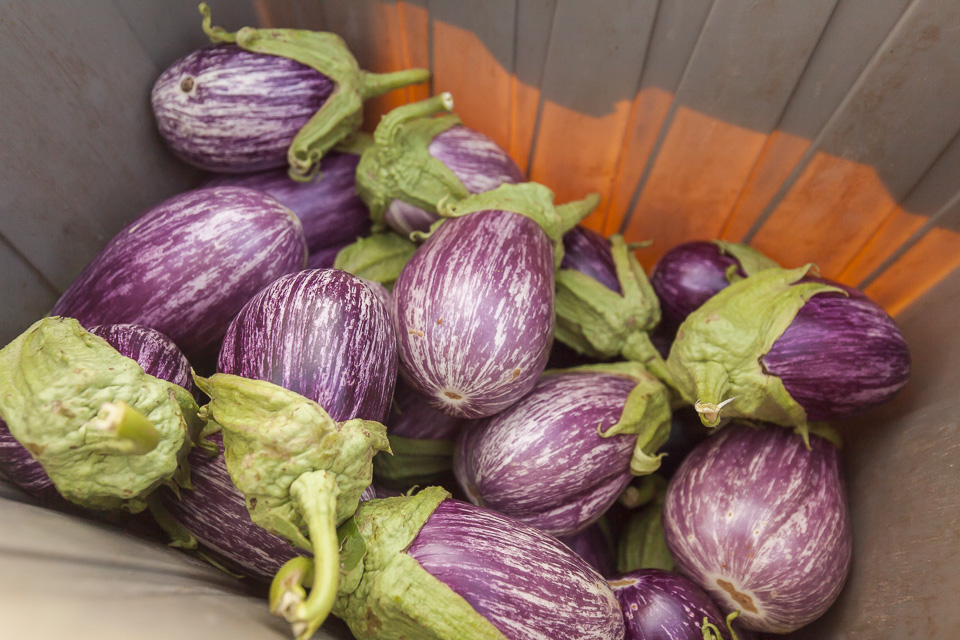 Graffiti eggplants. Photo by Scott David Gordon.
Graffiti eggplants. Photo by Scott David Gordon.
 Eggplant harvesting vehicle. Photo by Scott David Gordon.
Eggplant harvesting vehicle. Photo by Scott David Gordon.
 Farm carpool. Photo by Scott David Gordon.
Farm carpool. Photo by Scott David Gordon.
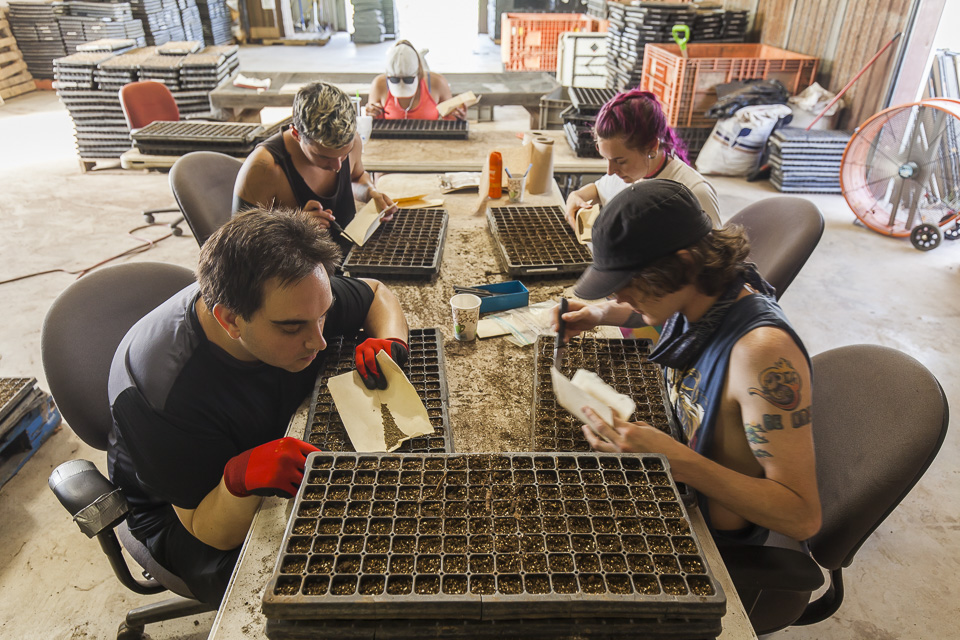 Seeding. Photo by Scott David Gordon.
Seeding. Photo by Scott David Gordon.
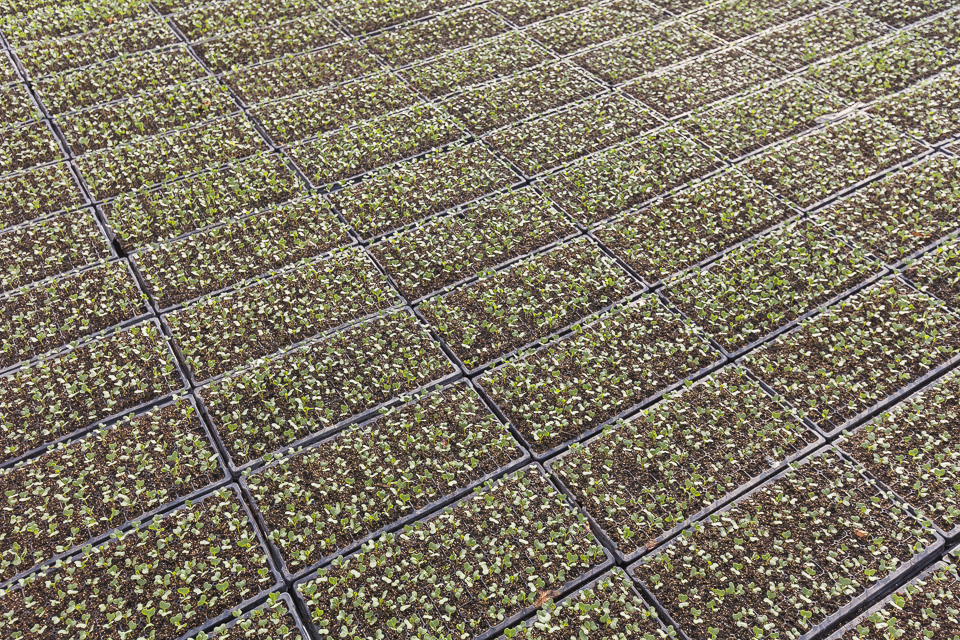 Transplant babies. Photo by Scott David Gordon.
Transplant babies. Photo by Scott David Gordon.
 Transplants. Photo by Scott David Gordon.
Transplants. Photo by Scott David Gordon.
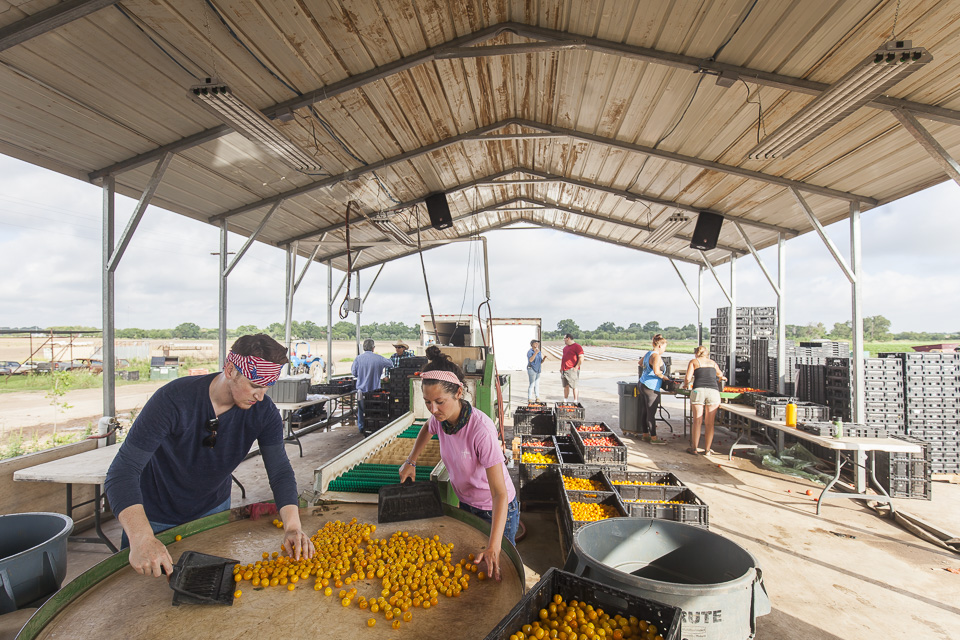 Tomato sorting area. Photo by Scott David Gordon.
Tomato sorting area. Photo by Scott David Gordon.
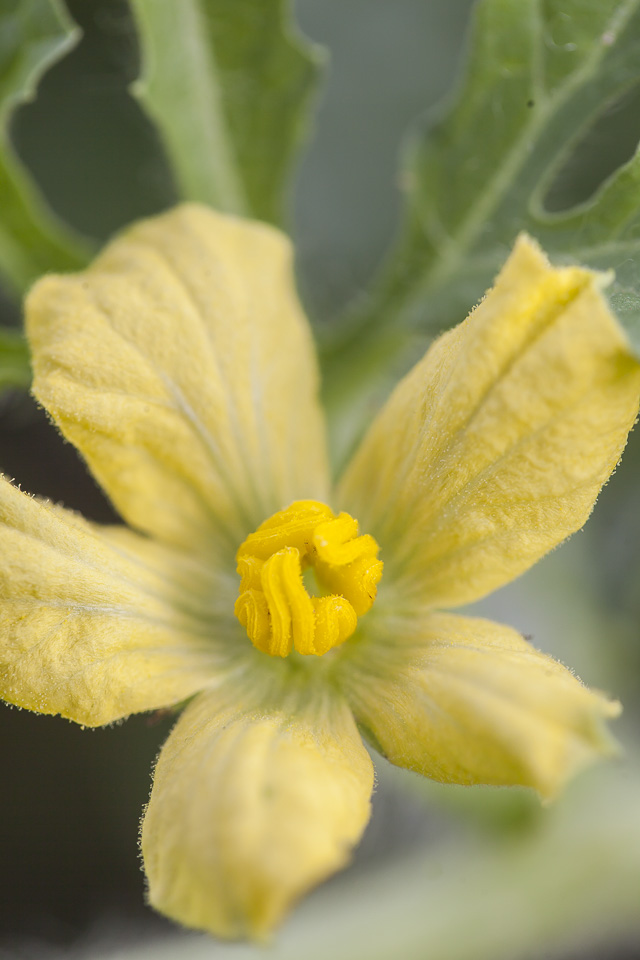 Melon flower. Photo by Scott David Gordon.
Melon flower. Photo by Scott David Gordon.
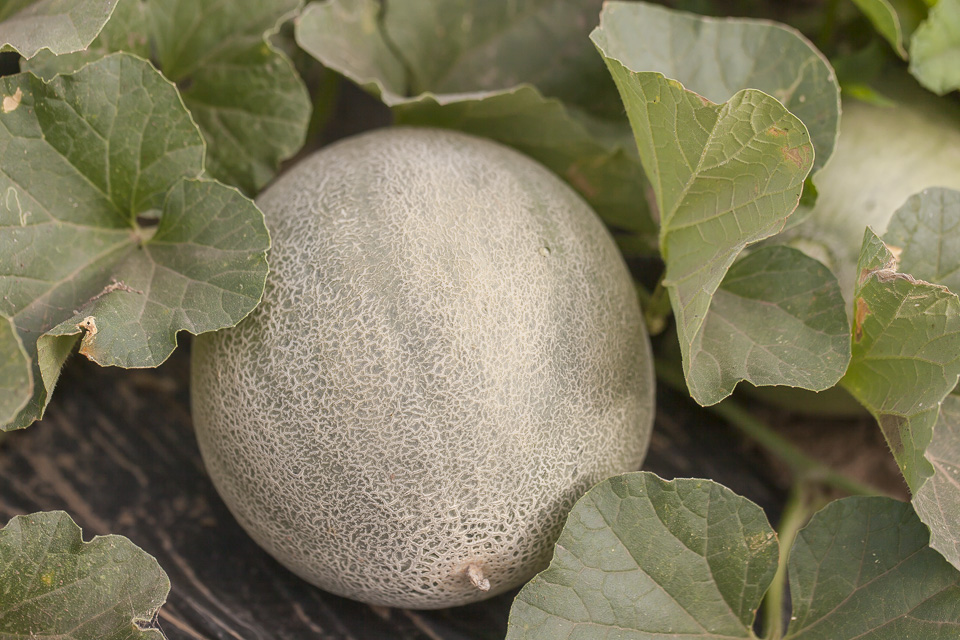 Cantaloupe. Photo by Scott David Gordon.
Cantaloupe. Photo by Scott David Gordon.
 Fields o' melon. Photo by Scott David Gordon.
Fields o' melon. Photo by Scott David Gordon.
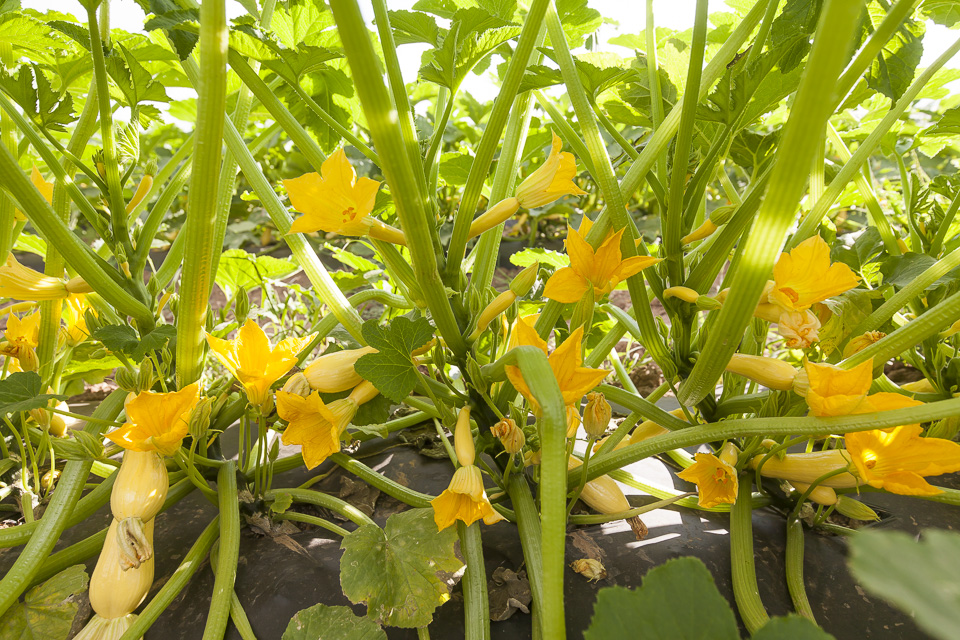 Squash. Photo by Scott David Gordon.
Squash. Photo by Scott David Gordon.
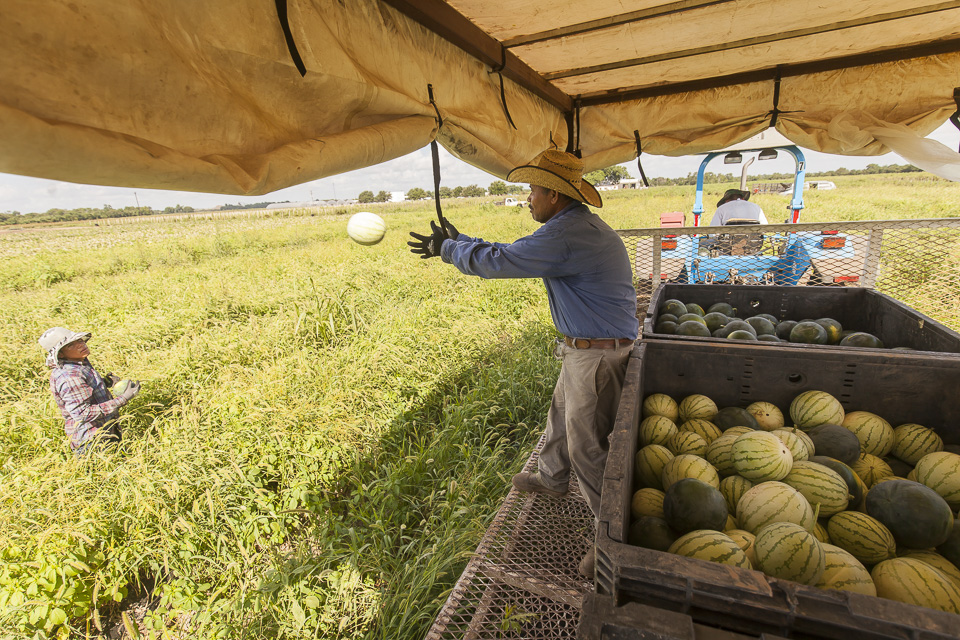 Watermelon toss. Photo by Scott David Gordon.
Watermelon toss. Photo by Scott David Gordon.
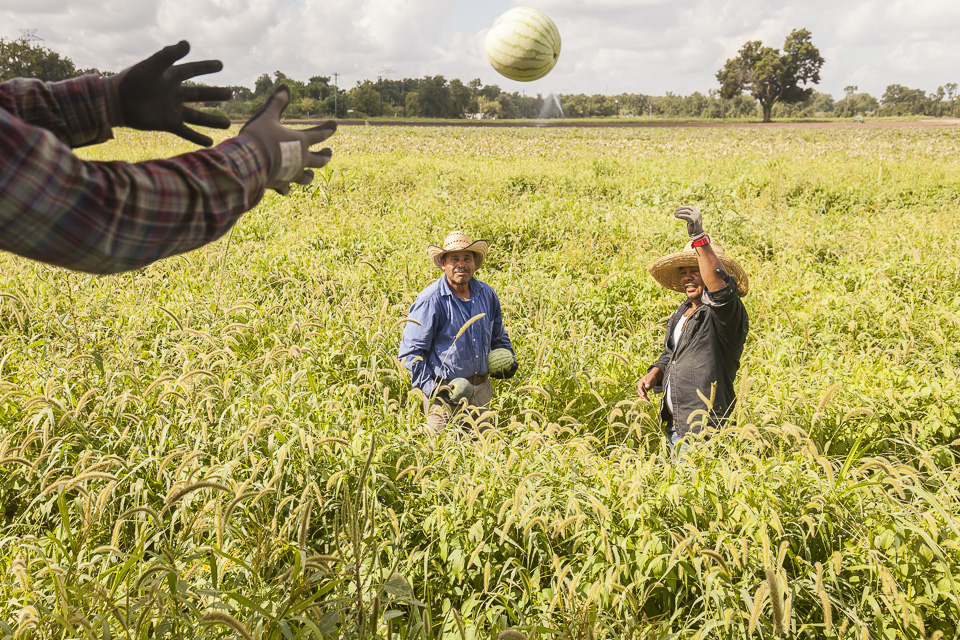 Watermelon catching some air. Photo by Scott David Gordon.
Watermelon catching some air. Photo by Scott David Gordon.MELON MANIA!
07/07/17 — Heydon Hatcher
A happy belated 4th of July to our farm community! We hope everyone rang in America’s day of birth with all the delectable grilled fares, all the wonderful family and friends, and all the ice cold beverages. You might have noticed from the scorching hot and unrelenting heat that summertime has arrived in her bright and sunshiney dress. This mean oodles of sweat, all the Topo Chico you can possibly imbibe, immersing yourself in local watering holes as much as possible, but also and more importantly, MELONS! The darlings of our summertime crops have arrived, and they will be here to stay for quite a while as we have five successions of all our varied melon varieties. The southern United States is “melon country,” as our head farmer would say, because we have these blistering summers that this crop prefers. If ever you find yourself driving in rural Alabama, you can even spot wild melons growing on the side of the road… that’s how much this crop loves the heat! We have a huge assortment of melons this year from all over the world. Check out our guide below!
![Photo by Scott David Gordon.]() Photo by Scott David Gordon.
Photo by Scott David Gordon.
French Charentais Melon - Originating in west-central France, this variety is one of the smaller French varieties. Proclaimed to have a better more succulent taste than that of the North American Cantaloupe, this variety is the sweetest of all the French melons, too.
![French Chartenais. Photo by Scott David Gordon.]() French Charentais. Photo by Scott David Gordon.
French Charentais. Photo by Scott David Gordon.
Korean Melon - We have been growing these incredibly sweet melons for about three or four years now. This year, we have tried out a new variety that looks like a cucumber with yellow skin and white flesh on the inside. Also called chamoe, this sweet and crispy taste is a cross between a honeydew and a cucumber. You can eat it whole, even the skin. Grown primarily in Korea now, they originated in East India, and are thought to have been introduced to China via the Silk Road.
![Korean Melon. Photo by Scott David Gordon.]() Korean Melon. Photo by Scott David Gordon.
Korean Melon. Photo by Scott David Gordon.
Galia Melon - Hailing from Israel, the word “galia” means “born in waves” in Hebrew. This is one of the first melons that we harvest from the fields during the summer season! When you bite into this beauty, you experience quite a tropical taste.
![Galia. Photo by Scott David Gordon.]() Galia. Photo by Scott David Gordon.
Galia. Photo by Scott David Gordon.
Canary Melon - Aptly named as its bright rind mirrors the color of a canary bird. This melon is elongated with white flesh. It has a taste similar to that of a honeydew - a touch tangier, but still very sweet.
![Canary. Photo by Scott David Gordon.]() Canary. Photo by Scott David Gordon.
Canary. Photo by Scott David Gordon.
Cantaloupe (Regular and Mini) - One of our sweet and juicy all time favorites, this orange-fleshed melon is perfect sliced up for breakfast, wrapped up with prosciutto as a snack, or served with ice cream as a dessert.
![Cantaloupe. Photo by Scott David Gordon.]() Cantaloupe. Photo by Scott David Gordon.
Cantaloupe. Photo by Scott David Gordon.
Crenshaw Melon - Pink-fleshed with a taste and texture that is unbelievable... one of our farmers’ favorites. A hybrid melon that boasts a sweet but slightly spicy taste. (This crop is still growing, not ready for markets yet!)
Honeydew Melon - This melon has a very sweet taste with greenish flesh. The perfect treat to cool down on a summer scorcher, plus it lends itself very well as a dessert.
![Honeydew. Photo by Scott David Gordon.]() Honeydew. Photo by Scott David Gordon.
Honeydew. Photo by Scott David Gordon.
Icebox Watermelon (Yellow Watermelon, Black Rind Watermelon, Green-Striped Watermelon) - The most popular of all the melons, our icebox watermelons are the belles of the market. Since we don’t grow the traditional larger watermelons (they are too big and heavy to haul around, plus, they don’t fit in the CSA box!), we have quite the array of smaller personal sized watermelons. The yellow-fleshed watermelon is unusually sweet, and quite a sight when you cut into it. Our Black Rind Watermelon has a very crisp and sweet flesh when you bite into it, and lastly, our famous and probably most recognizable green-striped watermelon has the familiar green stripes with the pinkish-red insides. It’s dense and sweet, and tastes just like summertime.
![Watermelons! Photo by Scott David Gordon.]() Watermelons! Photo by Scott David Gordon.
Watermelons! Photo by Scott David Gordon.
Grab these summertime treats at the markets! CSA members - tell us what you like the best! We love feedback!
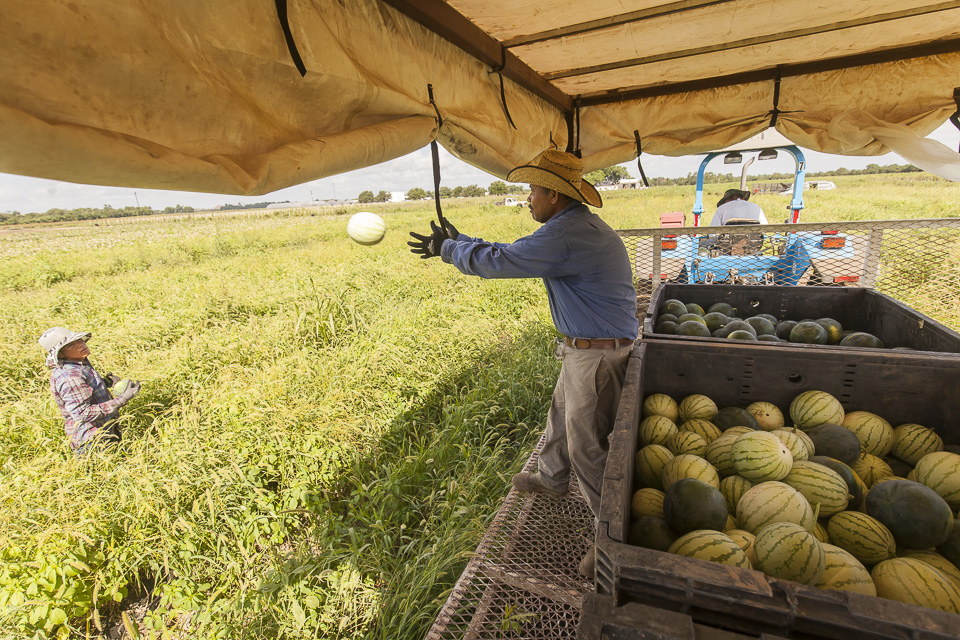 Photo by Scott David Gordon.
Photo by Scott David Gordon.
French Charentais Melon - Originating in west-central France, this variety is one of the smaller French varieties. Proclaimed to have a better more succulent taste than that of the North American Cantaloupe, this variety is the sweetest of all the French melons, too.
 French Charentais. Photo by Scott David Gordon.
French Charentais. Photo by Scott David Gordon.
Korean Melon - We have been growing these incredibly sweet melons for about three or four years now. This year, we have tried out a new variety that looks like a cucumber with yellow skin and white flesh on the inside. Also called chamoe, this sweet and crispy taste is a cross between a honeydew and a cucumber. You can eat it whole, even the skin. Grown primarily in Korea now, they originated in East India, and are thought to have been introduced to China via the Silk Road.
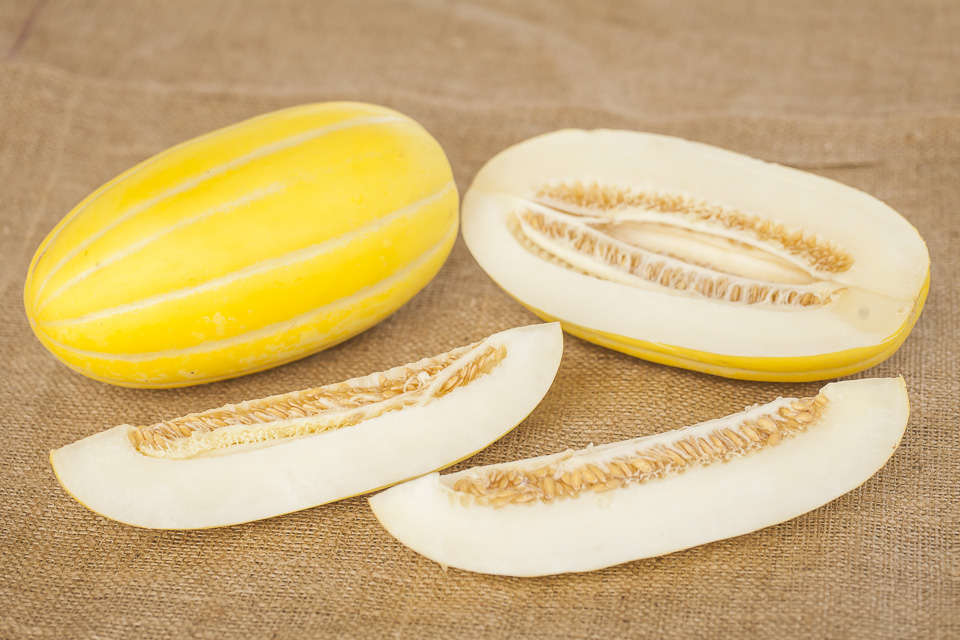 Korean Melon. Photo by Scott David Gordon.
Korean Melon. Photo by Scott David Gordon.
Galia Melon - Hailing from Israel, the word “galia” means “born in waves” in Hebrew. This is one of the first melons that we harvest from the fields during the summer season! When you bite into this beauty, you experience quite a tropical taste.
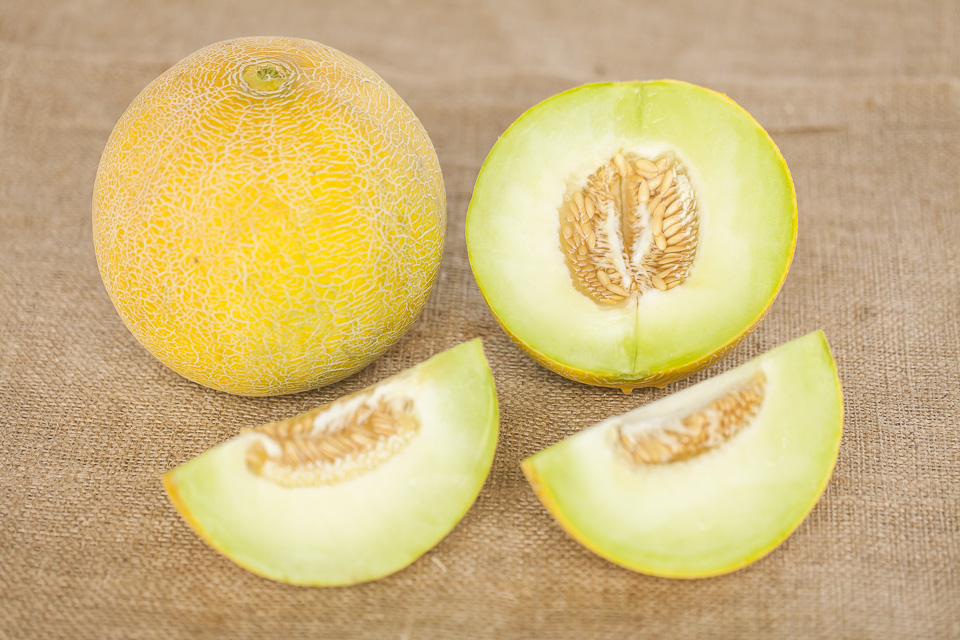 Galia. Photo by Scott David Gordon.
Galia. Photo by Scott David Gordon.
Canary Melon - Aptly named as its bright rind mirrors the color of a canary bird. This melon is elongated with white flesh. It has a taste similar to that of a honeydew - a touch tangier, but still very sweet.
 Canary. Photo by Scott David Gordon.
Canary. Photo by Scott David Gordon.
Cantaloupe (Regular and Mini) - One of our sweet and juicy all time favorites, this orange-fleshed melon is perfect sliced up for breakfast, wrapped up with prosciutto as a snack, or served with ice cream as a dessert.
 Cantaloupe. Photo by Scott David Gordon.
Cantaloupe. Photo by Scott David Gordon.
Crenshaw Melon - Pink-fleshed with a taste and texture that is unbelievable... one of our farmers’ favorites. A hybrid melon that boasts a sweet but slightly spicy taste. (This crop is still growing, not ready for markets yet!)
Honeydew Melon - This melon has a very sweet taste with greenish flesh. The perfect treat to cool down on a summer scorcher, plus it lends itself very well as a dessert.
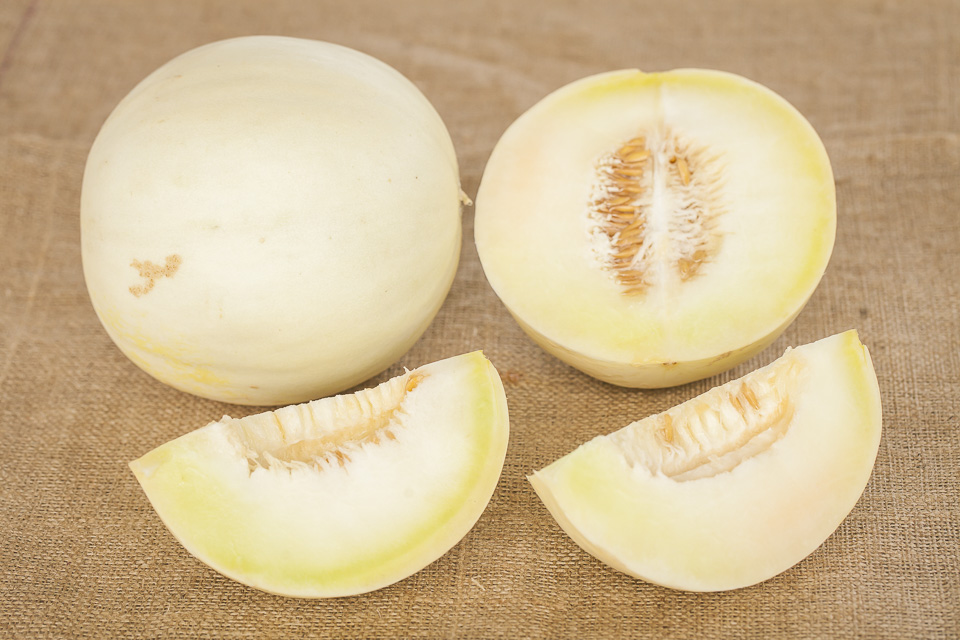 Honeydew. Photo by Scott David Gordon.
Honeydew. Photo by Scott David Gordon.
Icebox Watermelon (Yellow Watermelon, Black Rind Watermelon, Green-Striped Watermelon) - The most popular of all the melons, our icebox watermelons are the belles of the market. Since we don’t grow the traditional larger watermelons (they are too big and heavy to haul around, plus, they don’t fit in the CSA box!), we have quite the array of smaller personal sized watermelons. The yellow-fleshed watermelon is unusually sweet, and quite a sight when you cut into it. Our Black Rind Watermelon has a very crisp and sweet flesh when you bite into it, and lastly, our famous and probably most recognizable green-striped watermelon has the familiar green stripes with the pinkish-red insides. It’s dense and sweet, and tastes just like summertime.
 Watermelons! Photo by Scott David Gordon.
Watermelons! Photo by Scott David Gordon.
Grab these summertime treats at the markets! CSA members - tell us what you like the best! We love feedback!
FIRST FRIDAY STAFF PICKS - JULY '17 EDITION
07/07/17 — Heydon Hatcher
The arrival of a new month means another marvelous edition of our First Friday Staff Picks! We think that our staff is the best in the business (okay, okay, we are a little biased), but the JBG family hails from all over the place and covers the gamut in talents and interests. We love sharing events, adventures, and side projects that inspire and excite our JBG-ers (food-related or not) with the community. Check out the staff-curated list of favorites below!
![Photo by Scott David Gordon.]() Photo by Scott David Gordon.
Photo by Scott David Gordon.
Ada (Marketing and CSA Manager) - Summertime, in general. Sure, it's sweltering, but Texas summers aren't so bad when you're plopped in water. When I first moved to Texas 10 or so years ago, I was enchanted by Texas's spring-fed rivers and creeks, and these readily-flowing or barely-trickling water sources still have my attention. Where I grew up, swimming holes are muddy brown and sprinkled with the occasional alligator (a different kind of charm). Went kayaking a couple weeks ago on the South Llano with pup, and finished off the trip with a fried catfish plate from Segovia Truck Stop near Junction. Highly recommended day trip!
Really excited to see what the women at Ft. Lonesome have stitched up for their first-ever art show happening this Saturday. Open to the public, and sure to wow.
Mike Mo (Wholesale Manager) - Watermelons, lightly salted, because it's summertime and those melons sure are delicious.
![Photo by Scott David Gordon.]() Photo by Scott David Gordon.
Photo by Scott David Gordon.
Lena (Wholesale Team) - This is a month of nostalgia for me, I’m going to Dallas next week to see Third Eye Blind for the first time, 20 years after their first album was released. As a kid, I listened to that CD so many times that the liner notes were in tatters. I’m also going to Michelle Branch’s show at Emo’s at the end of the month, the last time I saw her play was 14 years ago! She has a new album out that I’ve been listening to a lot.
As for TV, I inhaled all of GLOW on Netflix last weekend and really enjoyed it. I’m also in the middle of a full-series rewatch of Veep and it has reminded me that there is nothing on television that delights me more than Sam Richardson’s brilliant work as the clueless Richard Splett.
Sarah (Volunteer Coordinator) - Barton Springs in the wee hours of the morning, look at how beautiful and quiet it is!
![Barton Springs.]() Barton Springs.
Barton Springs.
And the shower rooms, such a quiet and pleasant place to shave your legs after your early morning swim if you feel like it.
Also look at this little frog I found in a bin of veggies! Actually, would like to dedicate the rest of my post to all of the wildlife I've found among the vegetables:
![sarah bugs]()
Hector (Social Media Extraordinaire) - I got an Excalibur dehydrator on sale and I've been making chips out of EVERY veggie we have at the farm. I've only put salt on these first batches but next ones might include some marination beforehand as well as possible vegetable leather for snacking.
I'm also submitting a piñata to the Farmer as an Artist show, just for fun. I'm between an anatomically correct one or a veggie inspired.
Heydon (Farm Blogger) - I've probably watched Mac DeMarco's Blogotheque performance 100 times. Love him. Check it out here.
I went on a long hiatus from shooting film, and have just recently re-opened the floodgates. I'm obsessed. Here's a fave from the recent Tomato U-Pick at the Garfield farm.
And another of one of a dear friend catchin' some serious air.
Farm, in general - Today marks the 5th anniversary that Krishna has joined our team as our fearless Operations Manager. Krishna is a beloved leader here at the farm, and has helped foster tremendous growth and innovation over the past 5 years... he's the perfect balance to Brenton, and helps make things happen. Krishna's work ethic is only surpassed by his genuine love and care for our JBG Family. For his secret stash of cookies, his calm and kind resolve, and for his supreme intellect... we are very thankful! Don't know where we would be without you, Krishna!
![Krishna RULES!]() Krishna RULES! Beautiful portrait by Lucas Rager.
Krishna RULES! Beautiful portrait by Lucas Rager.
Missoula (Farm Dog) - Mike Mo. I embellished this photo of him because I love him.
![Photo by Scott David Gordon. Embellishments by Missoula Broussard.]() Photo by Scott David Gordon. Embellishments by Missoula Broussard.
Photo by Scott David Gordon. Embellishments by Missoula Broussard.
Roxy and Chucha (Farm Dogs) - Air Conditioned offices, and the UPS delivery driver who knows where our treats are stored in said office.
 Photo by Scott David Gordon.
Photo by Scott David Gordon.
Ada (Marketing and CSA Manager) - Summertime, in general. Sure, it's sweltering, but Texas summers aren't so bad when you're plopped in water. When I first moved to Texas 10 or so years ago, I was enchanted by Texas's spring-fed rivers and creeks, and these readily-flowing or barely-trickling water sources still have my attention. Where I grew up, swimming holes are muddy brown and sprinkled with the occasional alligator (a different kind of charm). Went kayaking a couple weeks ago on the South Llano with pup, and finished off the trip with a fried catfish plate from Segovia Truck Stop near Junction. Highly recommended day trip!
Really excited to see what the women at Ft. Lonesome have stitched up for their first-ever art show happening this Saturday. Open to the public, and sure to wow.
Mike Mo (Wholesale Manager) - Watermelons, lightly salted, because it's summertime and those melons sure are delicious.
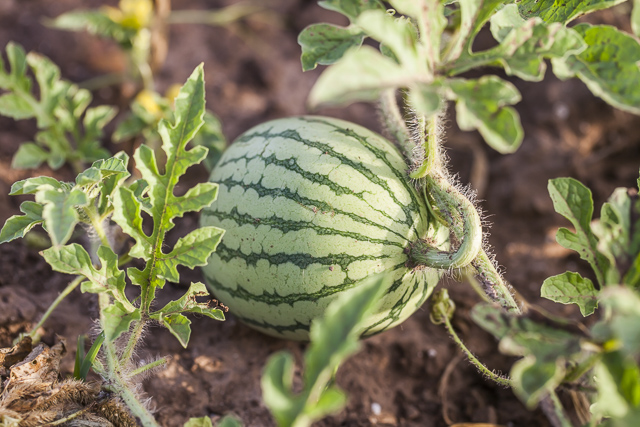 Photo by Scott David Gordon.
Photo by Scott David Gordon.
Lena (Wholesale Team) - This is a month of nostalgia for me, I’m going to Dallas next week to see Third Eye Blind for the first time, 20 years after their first album was released. As a kid, I listened to that CD so many times that the liner notes were in tatters. I’m also going to Michelle Branch’s show at Emo’s at the end of the month, the last time I saw her play was 14 years ago! She has a new album out that I’ve been listening to a lot.
As for TV, I inhaled all of GLOW on Netflix last weekend and really enjoyed it. I’m also in the middle of a full-series rewatch of Veep and it has reminded me that there is nothing on television that delights me more than Sam Richardson’s brilliant work as the clueless Richard Splett.
Sarah (Volunteer Coordinator) - Barton Springs in the wee hours of the morning, look at how beautiful and quiet it is!
 Barton Springs.
Barton Springs.
And the shower rooms, such a quiet and pleasant place to shave your legs after your early morning swim if you feel like it.
Also look at this little frog I found in a bin of veggies! Actually, would like to dedicate the rest of my post to all of the wildlife I've found among the vegetables:

Hector (Social Media Extraordinaire) - I got an Excalibur dehydrator on sale and I've been making chips out of EVERY veggie we have at the farm. I've only put salt on these first batches but next ones might include some marination beforehand as well as possible vegetable leather for snacking.
I'm also submitting a piñata to the Farmer as an Artist show, just for fun. I'm between an anatomically correct one or a veggie inspired.
Heydon (Farm Blogger) - I've probably watched Mac DeMarco's Blogotheque performance 100 times. Love him. Check it out here.
I went on a long hiatus from shooting film, and have just recently re-opened the floodgates. I'm obsessed. Here's a fave from the recent Tomato U-Pick at the Garfield farm.
And another of one of a dear friend catchin' some serious air.
Farm, in general - Today marks the 5th anniversary that Krishna has joined our team as our fearless Operations Manager. Krishna is a beloved leader here at the farm, and has helped foster tremendous growth and innovation over the past 5 years... he's the perfect balance to Brenton, and helps make things happen. Krishna's work ethic is only surpassed by his genuine love and care for our JBG Family. For his secret stash of cookies, his calm and kind resolve, and for his supreme intellect... we are very thankful! Don't know where we would be without you, Krishna!
 Krishna RULES! Beautiful portrait by Lucas Rager.
Krishna RULES! Beautiful portrait by Lucas Rager.
Missoula (Farm Dog) - Mike Mo. I embellished this photo of him because I love him.
 Photo by Scott David Gordon. Embellishments by Missoula Broussard.
Photo by Scott David Gordon. Embellishments by Missoula Broussard.
Roxy and Chucha (Farm Dogs) - Air Conditioned offices, and the UPS delivery driver who knows where our treats are stored in said office.
CSA BOX CONTENTS WEEK OF JULY 10TH
07/11/17 — Scott
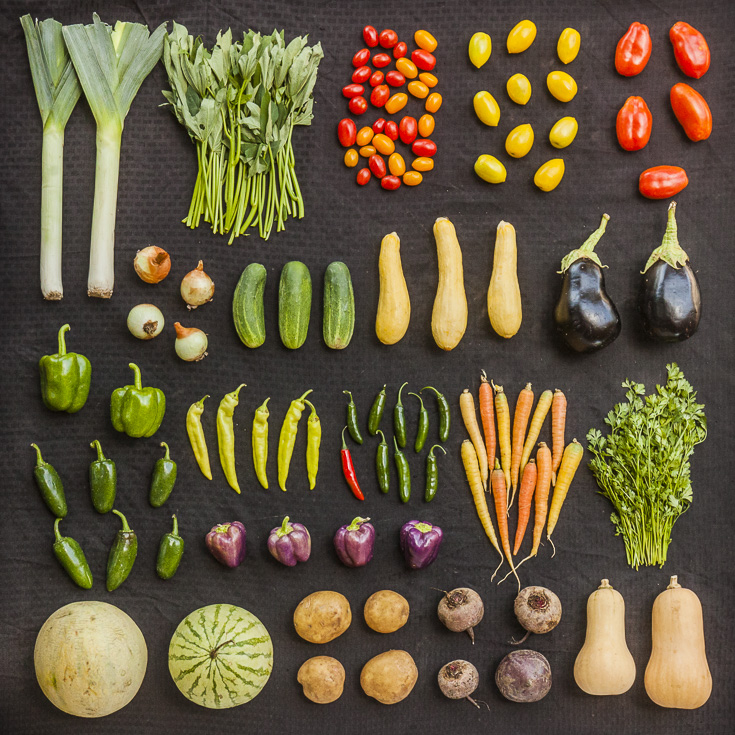 CSA Box Contents Week of July 10th
CSA Box Contents Week of July 10th
Large Box
Carrot, Orange
Eggplant, Black
Greens, Sweet Potato
Leek
Melon, Farmers Choice
Okra
Onion, White
Pepper, Jalapeno
Pepper, Sweet Medley
Potato, Red
Squash, Butternut
Squash, Zucchini
Tomato
Carrot, Orange
Eggplant, Black
Greens, Sweet Potato
Leek
Melon, Farmers Choice
Okra
Onion, White
Pepper, Jalapeno
Pepper, Sweet Medley
Potato, Red
Squash, Butternut
Squash, Zucchini
Tomato
Medium Box
Eggplant, Black
Greens, Sweet Potato
Leek
Melon, Farmers Choice
Pepper, Jalapeno
Pepper, Sweet Medley
Potato, Red
Squash, Butternut
Squash, Zucchini
Tomato
Eggplant, Black
Greens, Sweet Potato
Leek
Melon, Farmers Choice
Pepper, Jalapeno
Pepper, Sweet Medley
Potato, Red
Squash, Butternut
Squash, Zucchini
Tomato
Small Box
Carrot, Orange
Cucumber, Pickling
Greens, Sweet Potato
Melon, Farmers Choice
Pepper, Sweet Medley
Squash, Butternut
Squash, Zucchini
Tomato
Carrot, Orange
Cucumber, Pickling
Greens, Sweet Potato
Melon, Farmers Choice
Pepper, Sweet Medley
Squash, Butternut
Squash, Zucchini
Tomato
Individual Box
Cucumber, Pickling
Eggplant, Black
Melon, Farmers Choice
Okra
Pepper, Sweet Medley
Tomato
Cucumber, Pickling
Eggplant, Black
Melon, Farmers Choice
Okra
Pepper, Sweet Medley
Tomato
CSA BOX CONTENTS WEEK OF JULY 10TH
07/11/17 — Scott
 CSA Box Contents Week of July 10th
CSA Box Contents Week of July 10th
Medium Box
Carrot, Rainbow
Cucumber
Eggplant , Black
Herb, Parsley, Flat
Melon, Farmers Choice
Onion, Yellow
Pepper, Sweet Medley
Potato, Yukon Gold
Squash, Yellow
Tomato
SPICE BRAISED LENTILS AND TOMATOES WITH TOASTED COCONUT
07/13/17 — Heydon Hatcher
Recipe by Mackenzie Smith
This recipe is originally from Melissa Clark’s book Cook This Now, but it has made its way around the internet and into Kristin Miglore’s first cookbook, Genius Recipes. The crunch of the toasted mustard seed and coconut is the perfect match for the flavorful blend of lentils braised with spices and tomatoes.
![Photo by Rick Cortez.]() Photo by Rick Cortez.
Photo by Rick Cortez.
“Toast the lentils first in a melange of seasonings, then in a modest amount of flavorful sauce, so that they have no choice but to plump up with the aggressive flavors all around them.” -Kristin Miglore in Genius Recipes![Photo by Rick Cortez.]() Photo by Rick Cortez.
Photo by Rick Cortez.
1 . Melt the unsalted butter in a large saucepan over medium-high heat. Add the scallions, garlic and curry powder. Cook until the mixture is golden and soft, about 4 minutes. Stir in the tomato paste and lentils and cook until slightly caramelized, 1 to 2 minutes. Add the tomatoes and 1¾ teaspoons salt. Add enough water to cover the mixture by ½ inch. Bring the liquid to a boil over high-heat, reduce the heat to medium-low and simmer until the lentils are tender, 25 to 40 minutes. If the lentils begin to look dry while cooking, add more water as needed.
2. In a small, dry skillet over medium heat, toast the coconut flakes, mustard seeds, and a large pink of salt until the coconut is golden, about 3 minutes.
3. To serve, spoon the lentils into individual bowls. Drop about 2 teaspoons salted butter into each dish. Top with Yogurt, cilantro, and the coconut mixture. Serve immediately.
![Photo by Rick Cortez.]() Photo by Rick Cortez.
Photo by Rick Cortez.
This recipe is originally from Melissa Clark’s book Cook This Now, but it has made its way around the internet and into Kristin Miglore’s first cookbook, Genius Recipes. The crunch of the toasted mustard seed and coconut is the perfect match for the flavorful blend of lentils braised with spices and tomatoes.
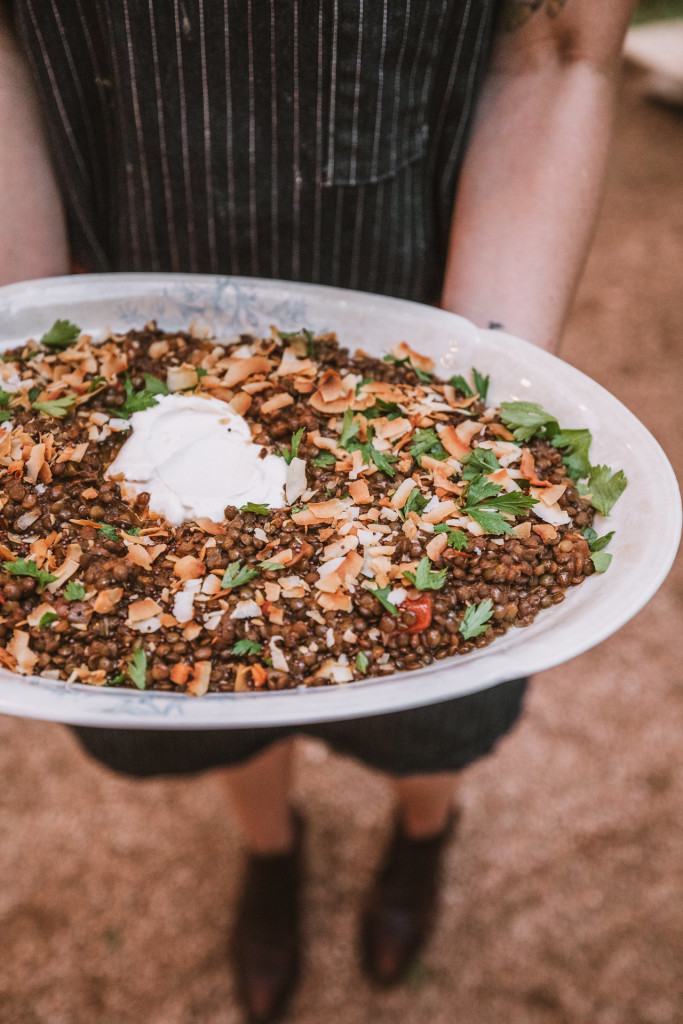 Photo by Rick Cortez.
Photo by Rick Cortez.
“Toast the lentils first in a melange of seasonings, then in a modest amount of flavorful sauce, so that they have no choice but to plump up with the aggressive flavors all around them.” -Kristin Miglore in Genius Recipes
- 3 tablespoons unsalted butter
- 1 bunch scallions, white and light green parts, thinly sliced
- 2 cloves garlic, finely chopped
- 1 tablespoon good-quality Madras curry powder
- 1 tablespoon tomato paste
- 2 cups green or brown lentils
- 12 ounces ripe, juicy tomatoes, chopped (2 medium, or 2 cups canned plum tomatoes)
- 1 ¼ teaspoon kosher salt, plus additional to taste
- 1 cup dried, unsweetened coconut flakes
- 1 ½ tablespoons black or brown mustard seeds
- Salty butter, for serving
- Plain whole milk yogurt, or serving (optional)
- Chopped fresh cilantro, for serving
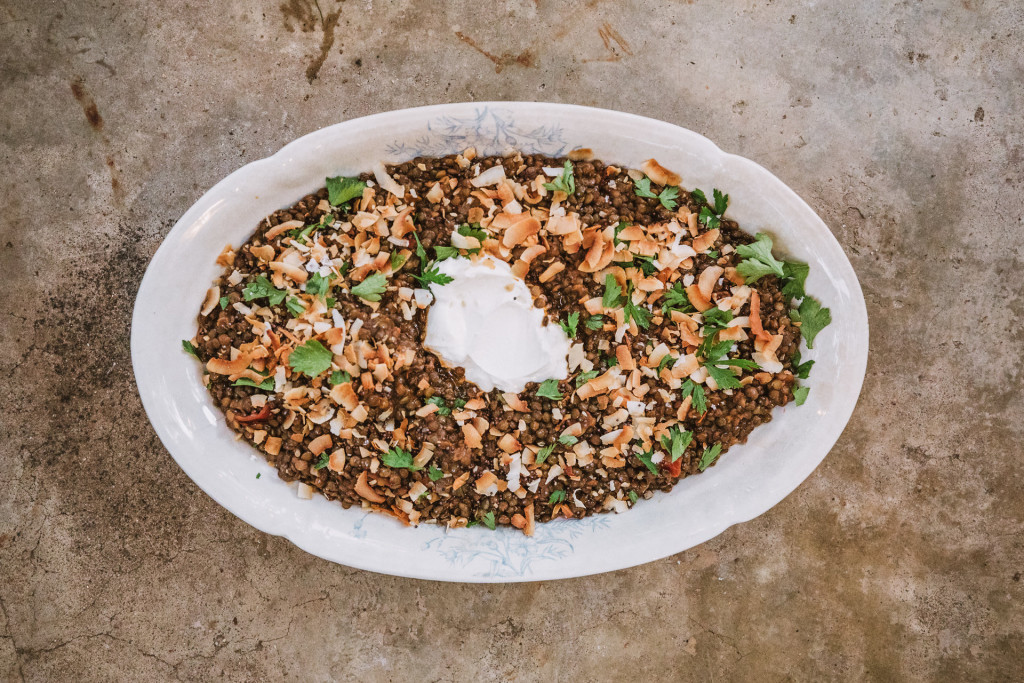 Photo by Rick Cortez.
Photo by Rick Cortez.
1 . Melt the unsalted butter in a large saucepan over medium-high heat. Add the scallions, garlic and curry powder. Cook until the mixture is golden and soft, about 4 minutes. Stir in the tomato paste and lentils and cook until slightly caramelized, 1 to 2 minutes. Add the tomatoes and 1¾ teaspoons salt. Add enough water to cover the mixture by ½ inch. Bring the liquid to a boil over high-heat, reduce the heat to medium-low and simmer until the lentils are tender, 25 to 40 minutes. If the lentils begin to look dry while cooking, add more water as needed.
2. In a small, dry skillet over medium heat, toast the coconut flakes, mustard seeds, and a large pink of salt until the coconut is golden, about 3 minutes.
3. To serve, spoon the lentils into individual bowls. Drop about 2 teaspoons salted butter into each dish. Top with Yogurt, cilantro, and the coconut mixture. Serve immediately.
 Photo by Rick Cortez.
Photo by Rick Cortez.WEEK 28 IN PHOTOS
07/14/17 — Heydon Hatcher
 Photo by Scott David Gordon.
Photo by Scott David Gordon.
For the past couple of weeks, it’s been raining peppers and eggplants on the farm… this past Monday we harvested 11 pallets of eggplants! Can you believe it? These crops are loving this scorching hot heat. Looking for a good recipe to utilize all this eggplant? Our farm manager, Becky, who grew up in China, imparted some Chinese cuisine intel with this recipe. YUM.
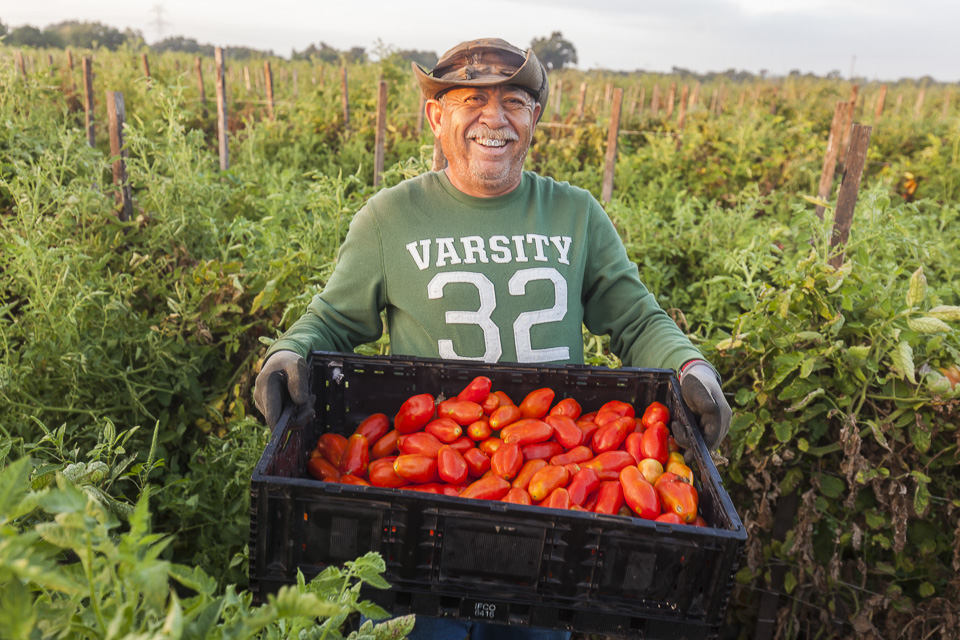 Photo by Scott David Gordon.
Photo by Scott David Gordon.
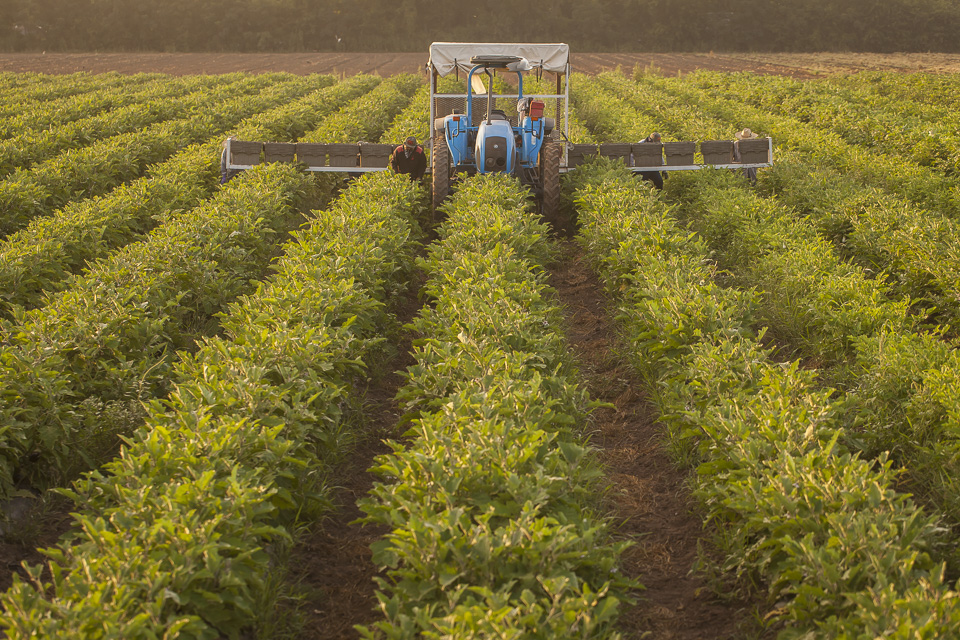 Photo by Scott David Gordon.
Photo by Scott David Gordon.
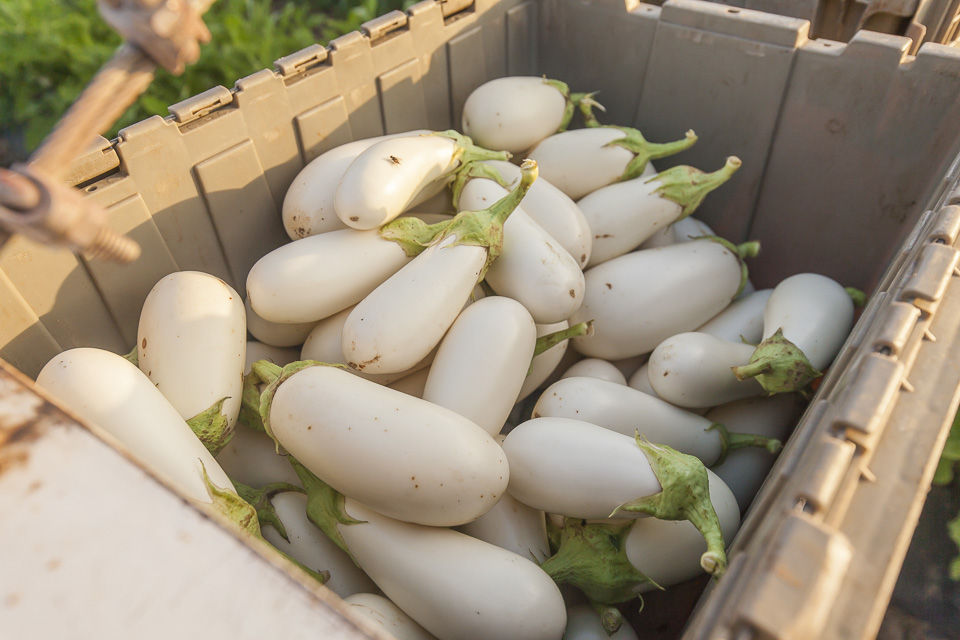 Photo by Scott David Gordon.
Photo by Scott David Gordon.
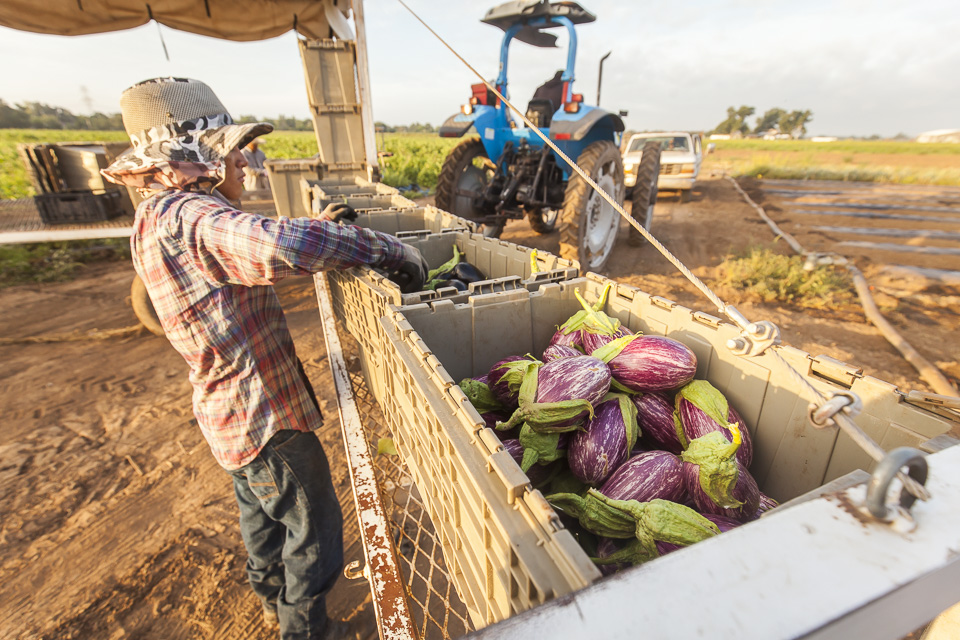 Photo by Scott David Gordon.
Photo by Scott David Gordon.
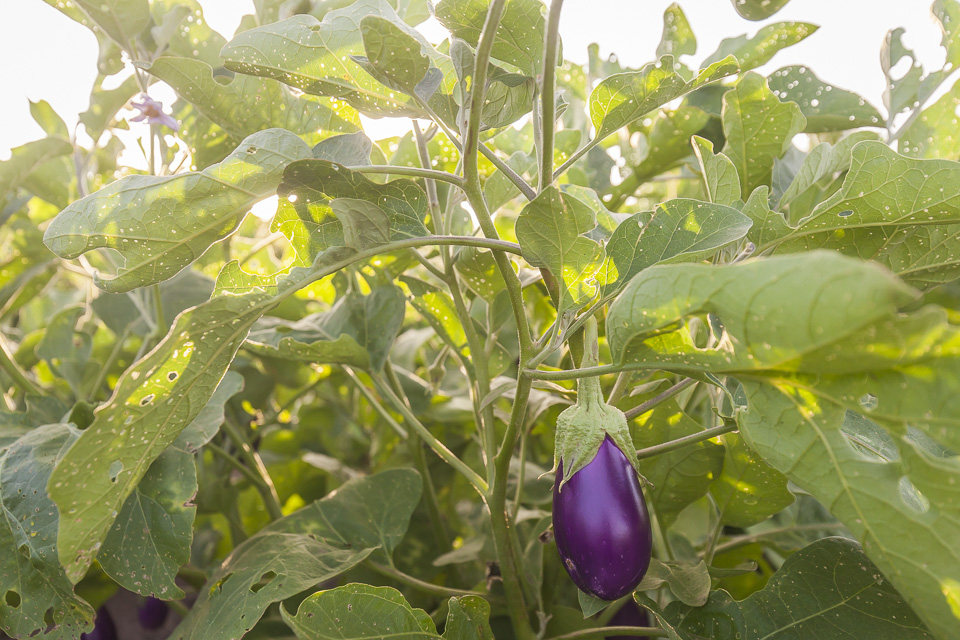 Photo by Scott David Gordon.
Photo by Scott David Gordon.
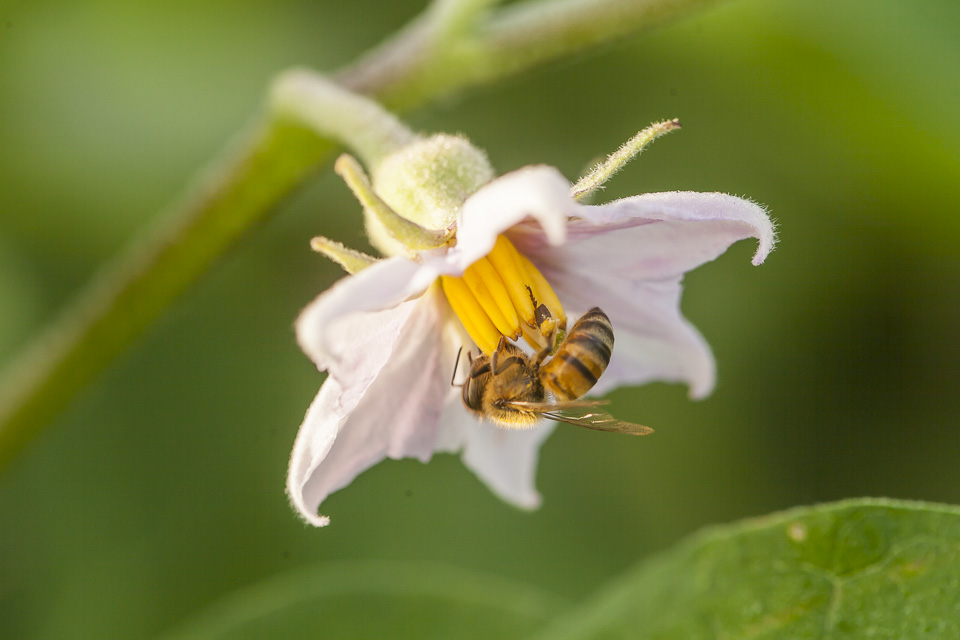 Photo by Scott David Gordon.
Photo by Scott David Gordon.
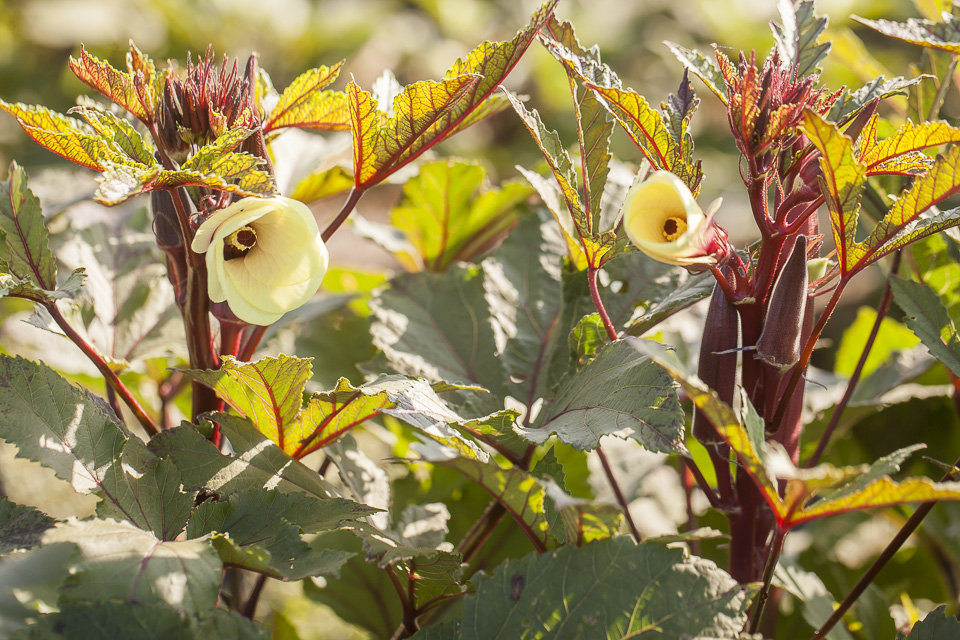 Photo by Scott David Gordon.
Photo by Scott David Gordon.
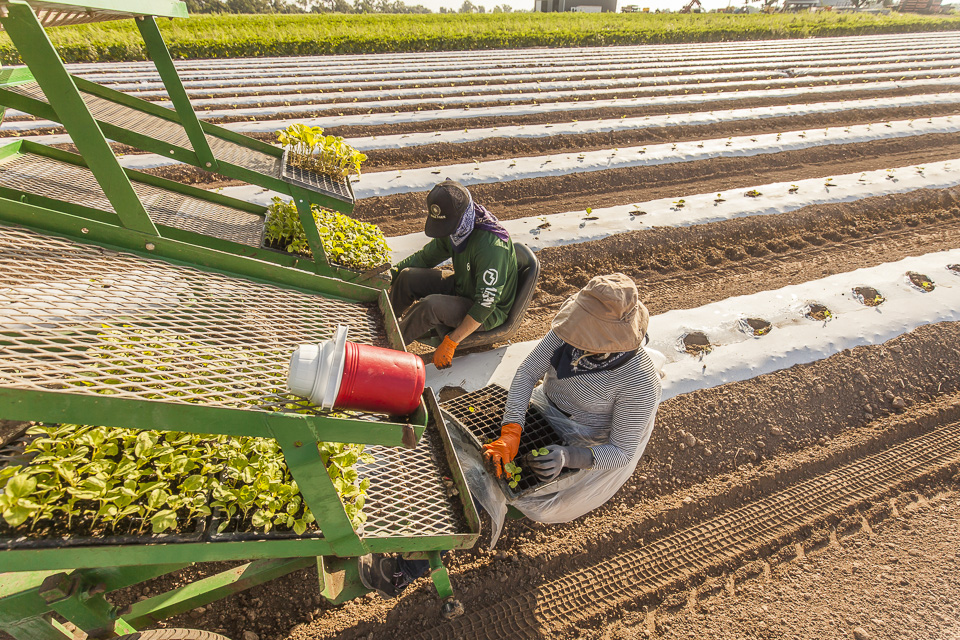 Photo by Scott David Gordon.
Photo by Scott David Gordon.
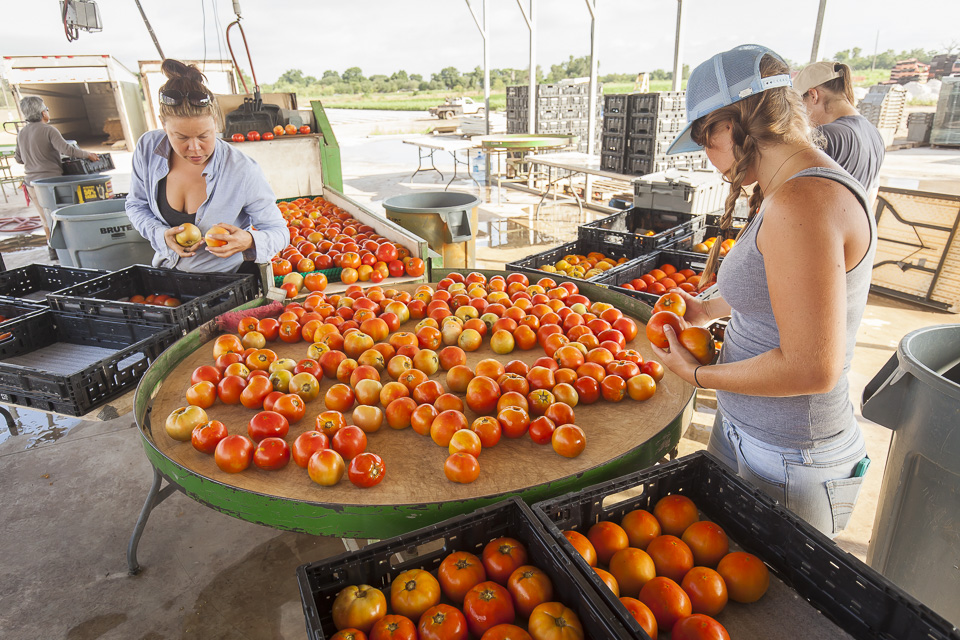 Photo by Scott David Gordon.
Photo by Scott David Gordon.
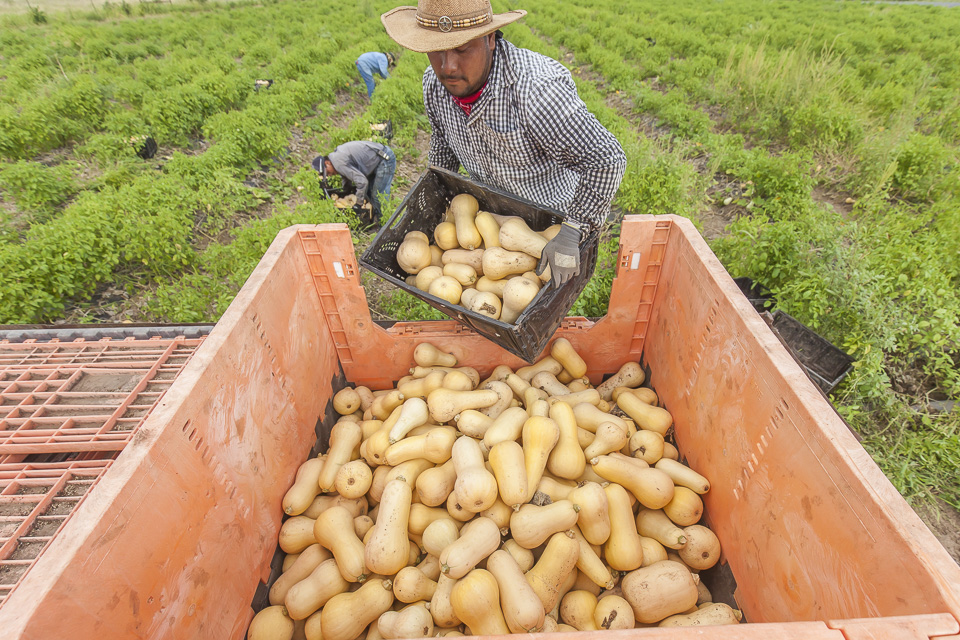 Photo by Scott David Gordon.
Photo by Scott David Gordon.A PLETHORA OF PEPPERS
07/14/17 — Heydon Hatcher
Peppers, peppers, peppers. With an endless string of nearly 100 degree days under our belt, marinating in our own sweat has become commonplace. While we are struggling to keep from going heat-crazy, our pepper crops are basking in the sunshine, and thriving in the brutal heat. Plentiful peppers abound on the farm currently! Peppers here, peppers there - we got ‘em everywhere! We pride ourselves on constantly innovating here at JBG, and just like the melons, we have had a good ole time testing the waters on a wide range of new varieties of this sweet and spicy crop. Here’s to the Capsicum genus, ranging from flaming hot to sweet as sugar, you make the dog days of summer worthwhile!
![Photo by Scott David Gordon.]() Photo by Scott David Gordon.
Photo by Scott David Gordon.
![Peppers! Photo by Scott David Gordon.]() Peppers! Photo by Scott David Gordon.
Peppers! Photo by Scott David Gordon.
![Photo by Scott David Gordon.]() Photo by Scott David Gordon.
Photo by Scott David Gordon.
Bell Pepper - Looking at the bell pepper harvest is always mesmerizing. These peppers have the most stunning spectrum of colors (this year we have green, red, white, orange, chocolate, yellow, purple bells!), and are the darling of the sweet pepper category. The taste changes with the color… red being the ripest and sweetest. A JBG favorite recipe is the culturally ubiquitous stuffed bell pepper.
![Photo by Scott David Gordon.]() Bell pepper gradient. Photo by Scott David Gordon.
Bell pepper gradient. Photo by Scott David Gordon.
Banana - A mild pepper known for its banana-like aesthetics. This pepper is perfect for pickling, a yummy addition to sandwiches.
![Shishitos. Photo by Scott David Gordon.]() Shishitos. Photo by Scott David Gordon.
Shishitos. Photo by Scott David Gordon.
Padron - Hailing from Padron, Spain, these small peppers are perfect for frying as well. In Spain they usually blister with oil and salt to serve as a tapas dish. Ranging from a deep green to yellowish green (sometimes red!), these Spanish are mild as bell peppers with one in ten packing a very spicy punch, just like the shishitos.
![Jalapeno business. Photo by Scott David Gordon.]() Jalapeno business. Photo by Scott David Gordon.
Jalapeno business. Photo by Scott David Gordon.
Serrano - Originating from the mountains in Mexico, these green, (turning red as they ripen like the jalapeño) spindly little peppers can pack a punch! Hotter when they are smaller, serranos are used frequently in a lot of salsas and sauces.
![Photo by Scott David Gordon.]() Hot pepper medley - Habaneros are the bright orange, and serranos are the green/red pepper baskets. Photo by Scott David Gordon.
Hot pepper medley - Habaneros are the bright orange, and serranos are the green/red pepper baskets. Photo by Scott David Gordon.
Habanero - This vibrant orange and wrinkly pepper, although small, packs SO. MUCH. HEAT. It is known as one of the spiciest peppers, and as such, makes for the perfect hot sauce ingredient. Dr. Stadnyk’s uses our habaneros to make their delectable hot sauce infused with carrots to subdue the amount of heat. This is our head farmer’s favorite to cook with - it adds such a distinct taste to any recipe, and that spice sure does have an intoxicating effect.
Cherry Bomb - When our head farmer, Brenton, went to Italy, he saw these everywhere! These hot peppers are tiny (about 2 inches in length), bright red, and look just like a cherry tomato. They are moderately spicy and perfect for stuffing or pickling!
![Photo by Scott David Gordon.]() Cherry Bomb peppers. Photo by Scott David Gordon.
Cherry Bomb peppers. Photo by Scott David Gordon.
![Photo by Scott David Gordon.]() Sheepnose Pimento. Photo by Scott David Gordon.
Sheepnose Pimento. Photo by Scott David Gordon.
Hinkelhatz - Another Ark of Taste variety, deemed Hinkelhatz because of it’s resemblance to a chicken heart (Hinkelhatz means “chicken heart” in German). Preserved by the Pennsylvania Dutch Mennonite community since the late 1800s and thought to originate in Mexico, this spicy pepper is great for vinegar and pickling.
Wenk’s Yellow Hots - Waxy with a thick skin, these moderately hot yellow peppers are great for pickles!
Beaver Dam - Mildly hot, crunchy, and slightly sweet, these peppers were brought to Beaver Dam, Wisconsin by Hungarian immigrants in the early 1900s. They are long and wedge-shaped, great for pickling, stuffing, salsas or goulash.
Pequin - Hailing from Mexico, this variety is a very small pepper that is usually used as a spice. This little guy really brings the heat, throw a pinch of this into whatever dish you really want add a little sizzle to, or sprinkle it on fruit!
![Photo by Scott David Gordon.]() Pequins. Photo by Scott David Gordon.
Pequins. Photo by Scott David Gordon.
Tabasco - Sound familiar? That’s right, this is the pepper they use to make the ubiquitous Tabasco hot sauce. It has a delicious smoky flavor, turns red when it matures, and originates from Mexico.
Jimmy Nardello - Anaheim - Living in Southern Italy, Jimmy Nardello’s mother, Angella, loved peppers to no bounds. When the Nardello’s decided to pursue a life in America in the late 1800s, Angella brought a handful of her most favorite sweet frying pepper seeds to America with her. Jimmy (their fourth child and the pepper’s namesake) inherited his mother’s love of this veggie, and cultivated this beloved frying pepper in his garden until he died. Before he passed, he shared some of his heirloom seeds with the Seeds Savers Exchange, and since they have been spreading this seed the world around! With a thin skin and a deep red hue, these peppers are perfect for frying and also for drying!
![Photo by Scott David Gordon.]() Jimmy Nardellos. Photo by Scott David Gordon.
Jimmy Nardellos. Photo by Scott David Gordon.
In the mood for some peppers yet? Visit us at markets this weekend and grab a handful! 'Til next time!
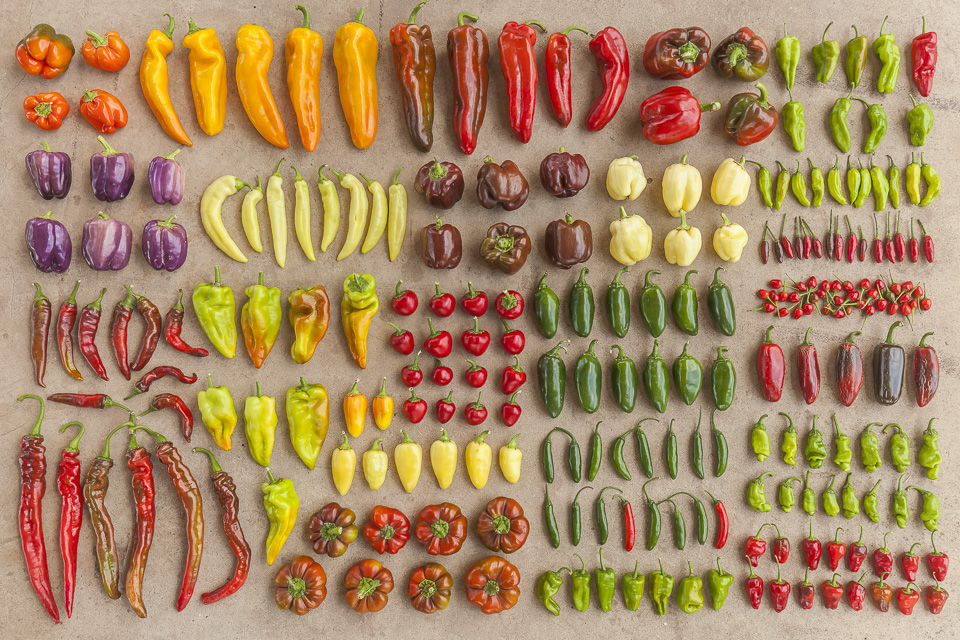 Photo by Scott David Gordon.
Photo by Scott David Gordon.
A Brief History
Originating in South America thousands of years ago, these members of the nightshade family’s cultivation spread to Central America soon after, and ultimately, through the Columbian Exchange (wherein Christopher Columbus kindled a massive exchange of goods between the Eastern and Western hemispheres during the 15th and 16th centuries) to Europe. Currently, peppers are utilized worldwide, enriching a plethora of different culinary traditions, from Spanish chorizo and Indian capsicum curry to the Congolese pili-pili sauce.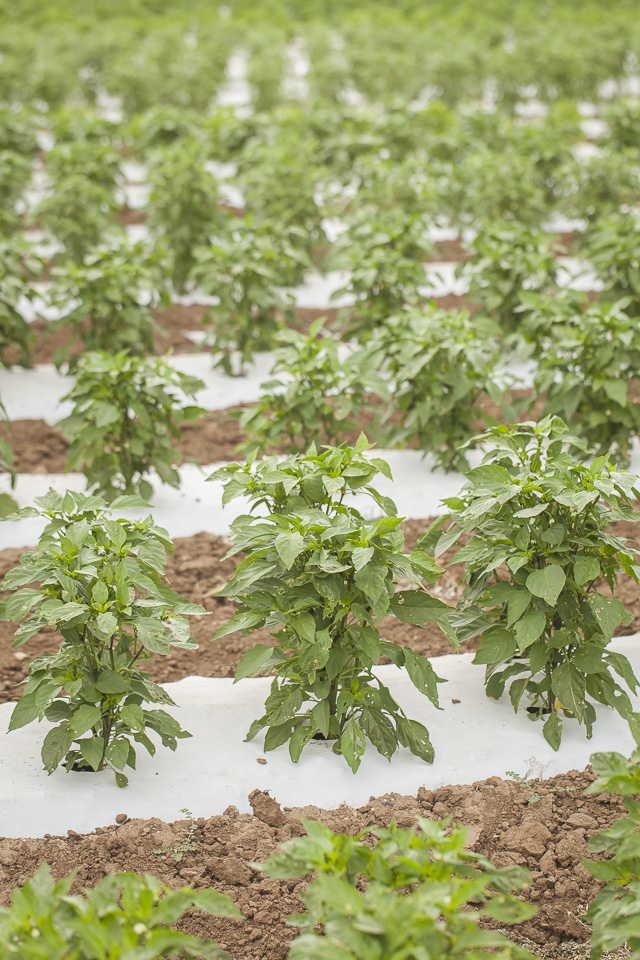 Peppers! Photo by Scott David Gordon.
Peppers! Photo by Scott David Gordon.
Nutritional Fun Facts
- All peppers have differing levels of capsaicin, a chemical compound that dissolves in fats and oils, in them. Bell peppers have little to none, and habaneros have some of the highest levels. This chemical causes a burning sensation on whatever tissue with which it comes into contact. This keeps mammals from eating the hotter peppers, because of the undesirable and sometimes painful side effects; whereas birds, whose receptors are largely unaffected by it, indulge in peppers and spread the seeds.
- No wonder it burns! Capsaicin is known to aid in burning fat and boost metabolism!
- A red, yellow, or green bell pepper has more Vitamin C than an orange, and are good sources of carotenoids, which act as antioxidants in the body as well as support ocular and epidermal health. The more they ripen, the more nutrition you get!
- Hot or sweet, peppers have a ton of B vitamins as well, namely B6, which higher consumption of is known to quell heart disease and stroke.
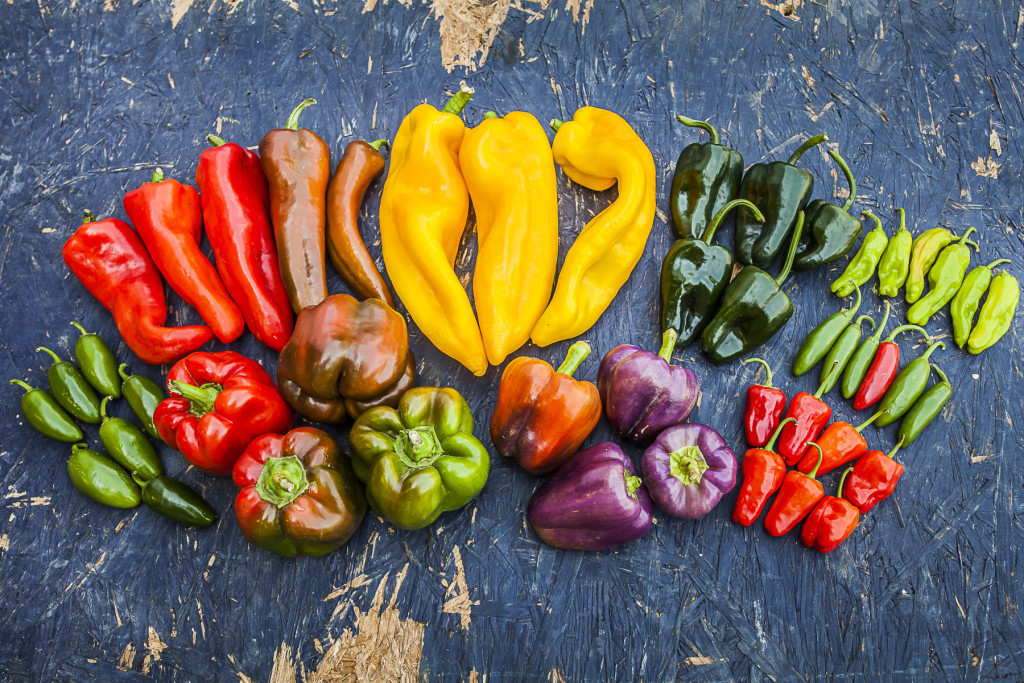 Photo by Scott David Gordon.
Photo by Scott David Gordon.
Sweet Peppers
Yellow/Red Italian - These Italian varieties are the sweetest peppers on the farm… ‘sweet as sugar’ as our farm manager, Becky, says. When the harvest reaches the barn, folks cannot resist grabbing a handful and taking a big juicy bite. These are perfect for snacking (kids love them!) or delicious roasted, whether as a side dish or on an antipasto plate!Bell Pepper - Looking at the bell pepper harvest is always mesmerizing. These peppers have the most stunning spectrum of colors (this year we have green, red, white, orange, chocolate, yellow, purple bells!), and are the darling of the sweet pepper category. The taste changes with the color… red being the ripest and sweetest. A JBG favorite recipe is the culturally ubiquitous stuffed bell pepper.
 Bell pepper gradient. Photo by Scott David Gordon.
Bell pepper gradient. Photo by Scott David Gordon.
Banana - A mild pepper known for its banana-like aesthetics. This pepper is perfect for pickling, a yummy addition to sandwiches.
Frying Peppers
Shishito - A Central Texas favorite, this mild little pepper hailing from East Asia is great for tempura, or a quick saute. Take a peek at one of our resident recipe blogger’s escapade into a blissful blistering of these green beauties. Brenton, our head farmer, loves hand-frying these peppers with some oil, garlic, and kosher salt! Watch out though, most of these peppers are on the milder side, but once in a blue moon you’ll get a kick of spicy shishito! BAM!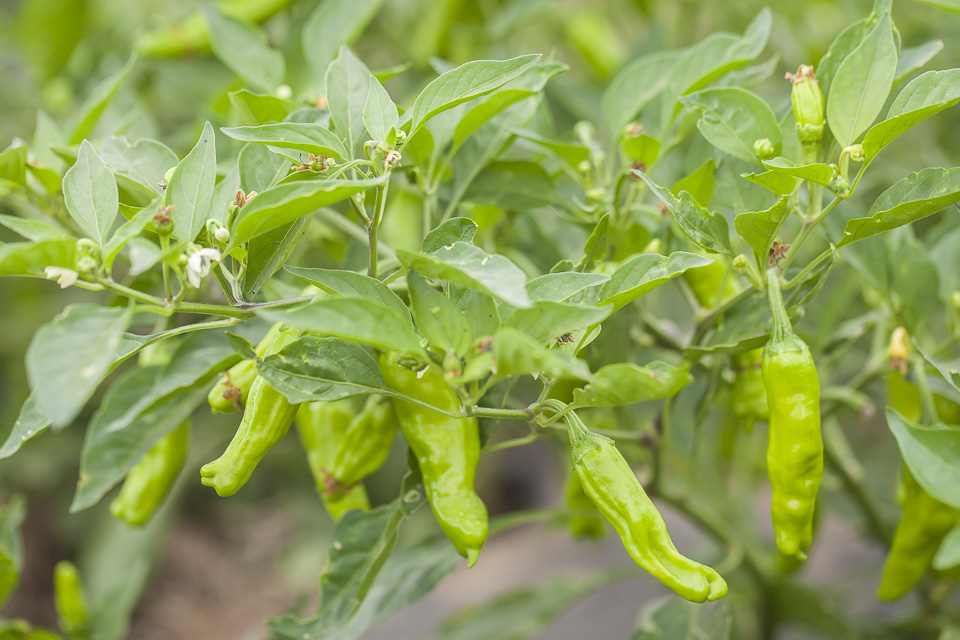 Shishitos. Photo by Scott David Gordon.
Shishitos. Photo by Scott David Gordon.
Padron - Hailing from Padron, Spain, these small peppers are perfect for frying as well. In Spain they usually blister with oil and salt to serve as a tapas dish. Ranging from a deep green to yellowish green (sometimes red!), these Spanish are mild as bell peppers with one in ten packing a very spicy punch, just like the shishitos.
Hot Peppers
Jalapeño - Smooth and green (turning red as they ripen), these peppers are milder and wider than serranos. These are sublime stuffed with cheese and wrapped with bacon or as a sauce... we’re thinking specifically of Tacodeli’s dreamy Doña sauce!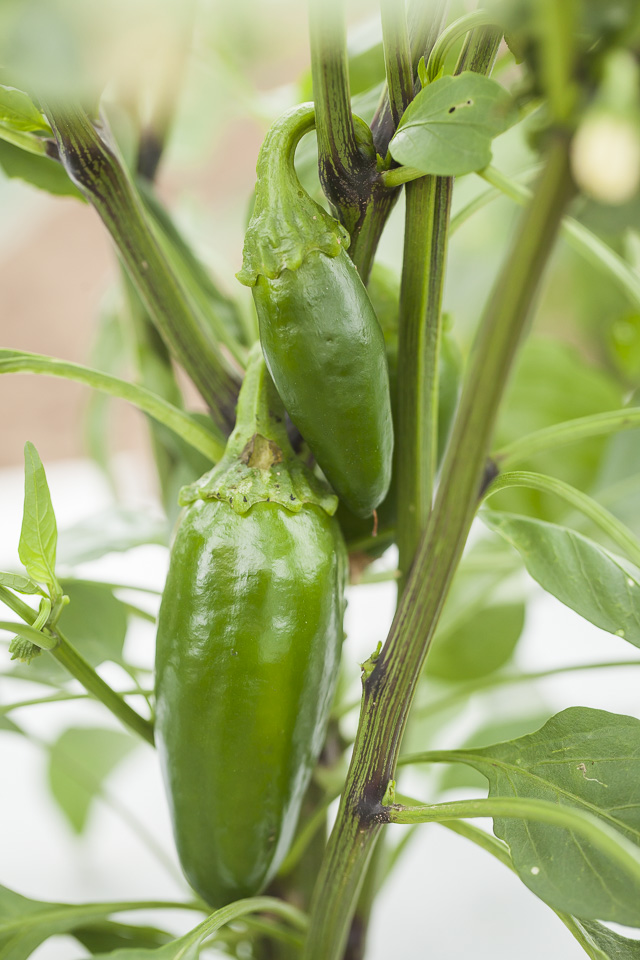 Jalapeno business. Photo by Scott David Gordon.
Jalapeno business. Photo by Scott David Gordon.
Serrano - Originating from the mountains in Mexico, these green, (turning red as they ripen like the jalapeño) spindly little peppers can pack a punch! Hotter when they are smaller, serranos are used frequently in a lot of salsas and sauces.
 Hot pepper medley - Habaneros are the bright orange, and serranos are the green/red pepper baskets. Photo by Scott David Gordon.
Hot pepper medley - Habaneros are the bright orange, and serranos are the green/red pepper baskets. Photo by Scott David Gordon.
Habanero - This vibrant orange and wrinkly pepper, although small, packs SO. MUCH. HEAT. It is known as one of the spiciest peppers, and as such, makes for the perfect hot sauce ingredient. Dr. Stadnyk’s uses our habaneros to make their delectable hot sauce infused with carrots to subdue the amount of heat. This is our head farmer’s favorite to cook with - it adds such a distinct taste to any recipe, and that spice sure does have an intoxicating effect.
Cherry Bomb - When our head farmer, Brenton, went to Italy, he saw these everywhere! These hot peppers are tiny (about 2 inches in length), bright red, and look just like a cherry tomato. They are moderately spicy and perfect for stuffing or pickling!
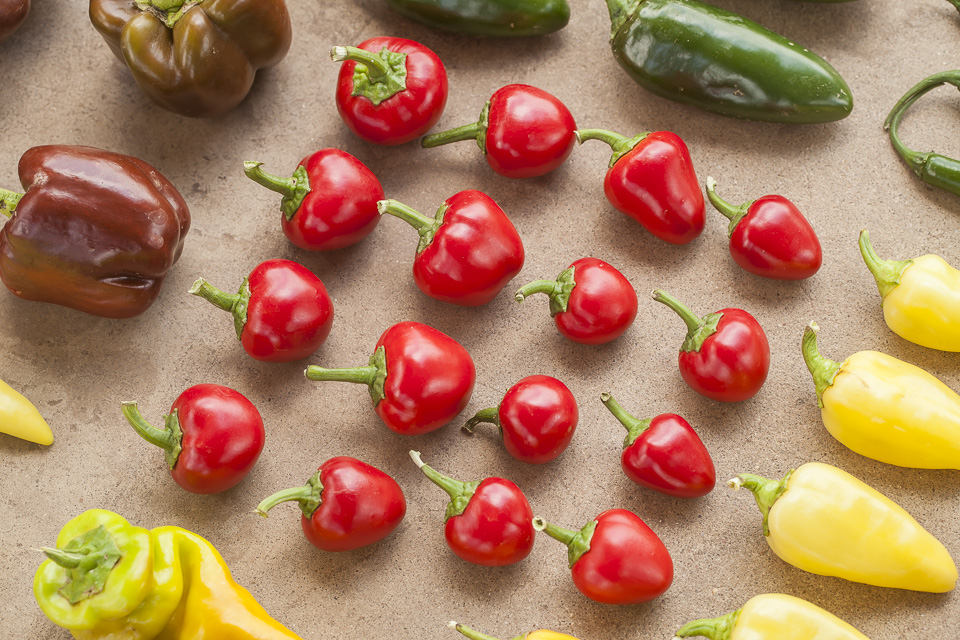 Cherry Bomb peppers. Photo by Scott David Gordon.
Cherry Bomb peppers. Photo by Scott David Gordon.
Heirloom Peppers
Sheepnose Pimento - This sweet pepper is an Ark of Taste variety and is quite a delectable, juicy snacking pepper. It has a thick flesh and is prime for canning, or throw 'em in the oven to bake!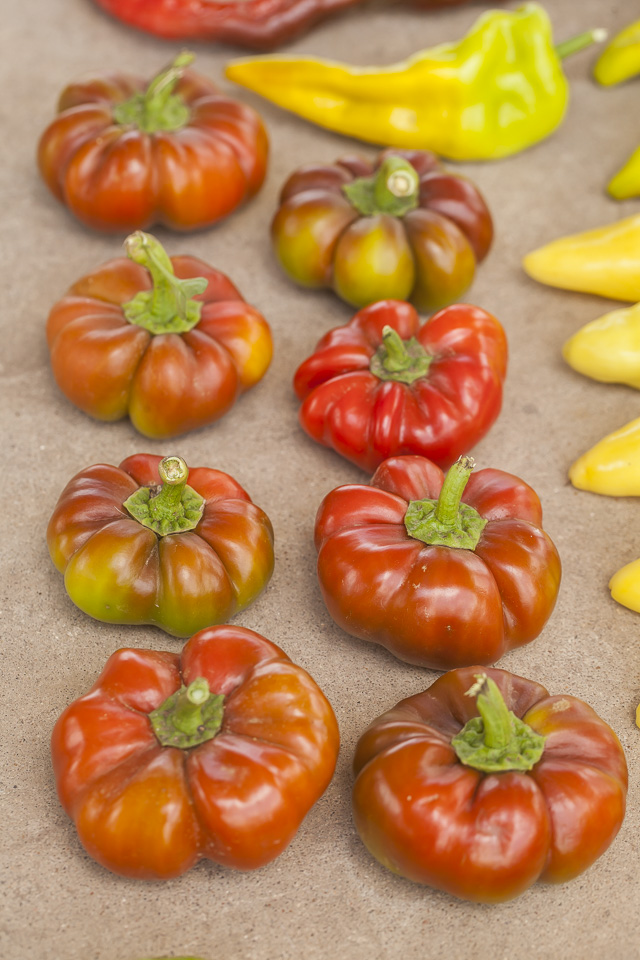 Sheepnose Pimento. Photo by Scott David Gordon.
Sheepnose Pimento. Photo by Scott David Gordon.
Hinkelhatz - Another Ark of Taste variety, deemed Hinkelhatz because of it’s resemblance to a chicken heart (Hinkelhatz means “chicken heart” in German). Preserved by the Pennsylvania Dutch Mennonite community since the late 1800s and thought to originate in Mexico, this spicy pepper is great for vinegar and pickling.
Wenk’s Yellow Hots - Waxy with a thick skin, these moderately hot yellow peppers are great for pickles!
Beaver Dam - Mildly hot, crunchy, and slightly sweet, these peppers were brought to Beaver Dam, Wisconsin by Hungarian immigrants in the early 1900s. They are long and wedge-shaped, great for pickling, stuffing, salsas or goulash.
Pequin - Hailing from Mexico, this variety is a very small pepper that is usually used as a spice. This little guy really brings the heat, throw a pinch of this into whatever dish you really want add a little sizzle to, or sprinkle it on fruit!
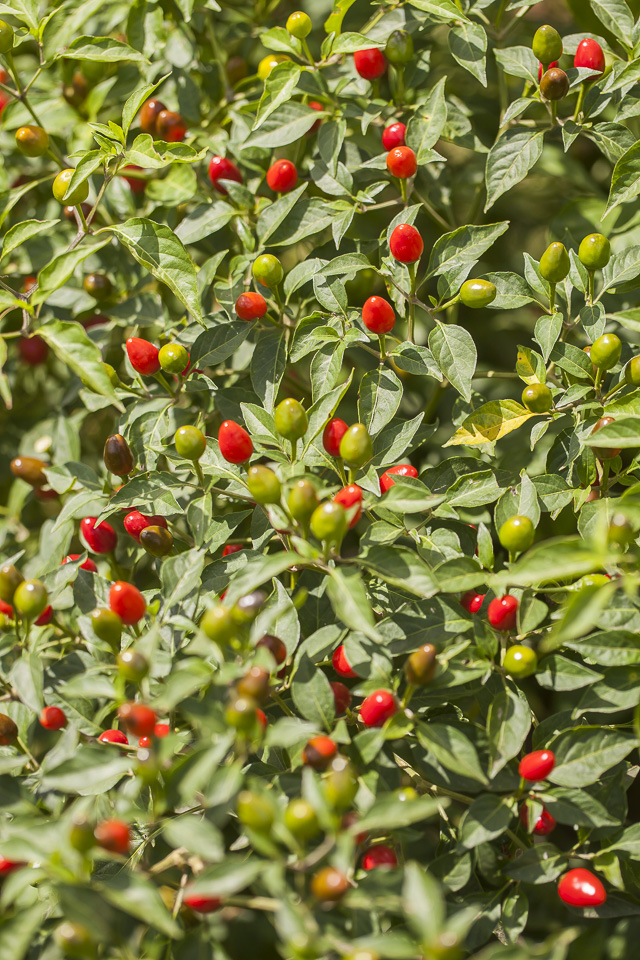 Pequins. Photo by Scott David Gordon.
Pequins. Photo by Scott David Gordon.
Tabasco - Sound familiar? That’s right, this is the pepper they use to make the ubiquitous Tabasco hot sauce. It has a delicious smoky flavor, turns red when it matures, and originates from Mexico.
Jimmy Nardello - Anaheim - Living in Southern Italy, Jimmy Nardello’s mother, Angella, loved peppers to no bounds. When the Nardello’s decided to pursue a life in America in the late 1800s, Angella brought a handful of her most favorite sweet frying pepper seeds to America with her. Jimmy (their fourth child and the pepper’s namesake) inherited his mother’s love of this veggie, and cultivated this beloved frying pepper in his garden until he died. Before he passed, he shared some of his heirloom seeds with the Seeds Savers Exchange, and since they have been spreading this seed the world around! With a thin skin and a deep red hue, these peppers are perfect for frying and also for drying!
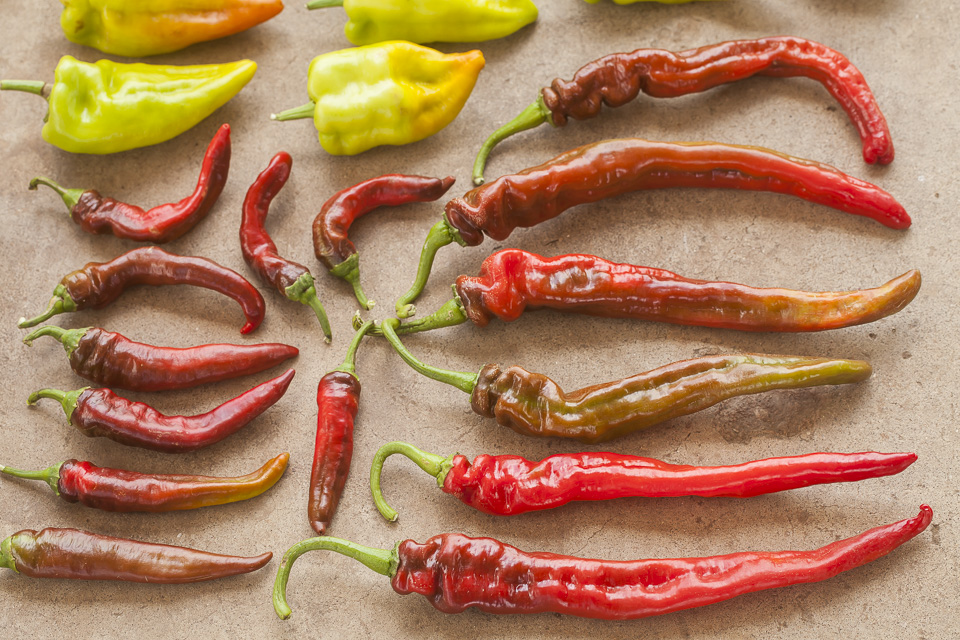 Jimmy Nardellos. Photo by Scott David Gordon.
Jimmy Nardellos. Photo by Scott David Gordon.
In the mood for some peppers yet? Visit us at markets this weekend and grab a handful! 'Til next time!
CSA BOX CONTENTS WEEK OF JULY 17TH
07/18/17 — Scott
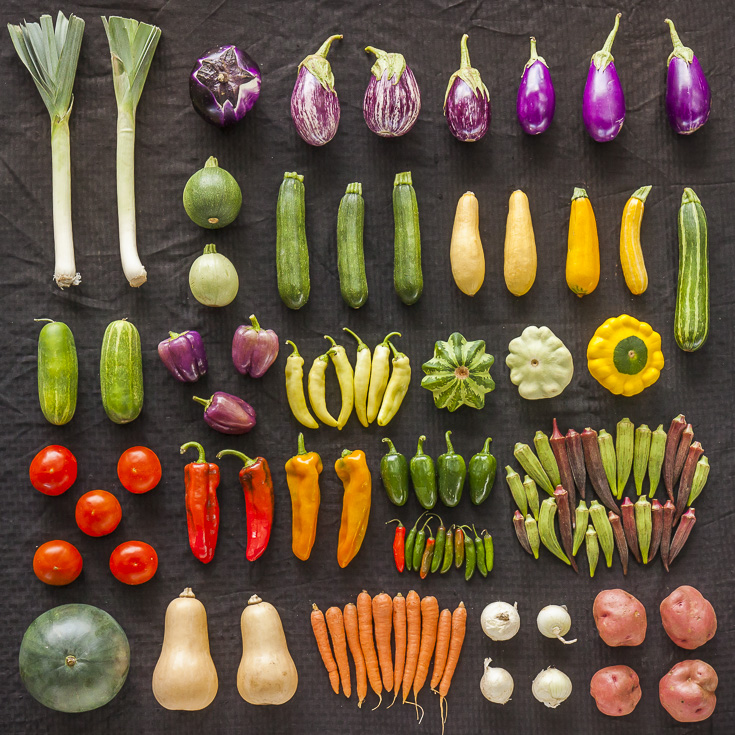 CSA Box Contents Week of July 17th
CSA Box Contents Week of July 17th
Large Box
Beet, Red
Carrot, Orange
Celery Root / Celeriac
Eggplant, Medley
Greens, Spinach, Malabar
Leek
Melon, Farmers Choice
Okra
Onion, White
Pepper, Sweet Medley
Potato, Red
Squash, Butternut
Squash, Yellow
Beet, Red
Carrot, Orange
Celery Root / Celeriac
Eggplant, Medley
Greens, Spinach, Malabar
Leek
Melon, Farmers Choice
Okra
Onion, White
Pepper, Sweet Medley
Potato, Red
Squash, Butternut
Squash, Yellow
Medium Box
Beet, Red
Carrot, Orange
Eggplant, Medley
Melon, Farmers Choice
Okra
Onion, White
Pepper, Sweet Medley
Potato, Red
Squash, Butternut
Squash, Yellow
Beet, Red
Carrot, Orange
Eggplant, Medley
Melon, Farmers Choice
Okra
Onion, White
Pepper, Sweet Medley
Potato, Red
Squash, Butternut
Squash, Yellow
Small Box
Beet, Red
Eggplant, Medley
Leek
Melon, Farmers Choice
Okra
Onion, White
Pepper, Sweet Medley
Potato, Red
Beet, Red
Eggplant, Medley
Leek
Melon, Farmers Choice
Okra
Onion, White
Pepper, Sweet Medley
Potato, Red
Individual Box
Beet, Red
Carrot, Orange
Melon, Farmers Choice
Pepper, Sweet Medley
Squash, Butternut
Squash, Yellow
Beet, Red
Carrot, Orange
Melon, Farmers Choice
Pepper, Sweet Medley
Squash, Butternut
Squash, Yellow
CSA BOX CONTENTS WEEK OF JULY 17TH
07/18/17 — Scott
 CSA Box Contents Week of July 17th
CSA Box Contents Week of July 17th
Medium Box
Eggplant, Medley
Greens, Sweet Potato
Leek
Melon, Farmers Choice
Pepper, Jalapeno
Pepper, Sweet Medley
Potato, Red
Squash, Butternut
Squash, Zucchini
Squash. Summer Medley
Tomato
GIN AND TOMATO JAM
07/20/17 — Heydon Hatcher
Recipe by Nadia Tamby
This is a uniquely spiced version of a classic "gin and jam." This cocktail gets a double hit of ginger - the fresh bite from the infused spirit and a more mellow, sweet ginger from the jam. It's a fun drink to make because you can customize it for your friends and family by adjusting the ratios and stirring the jam completely in their drink or not. After you've made the jam, it's a surprisingly simple drink to assemble. Since the simple syrup and jam will keep for a while and you'll already have infused gin on hand, you can recreate this drink pretty easily for a couple weeks afterward, too.
![Photo by Rick Cortez.]() Photo by Rick Cortez.
Photo by Rick Cortez.
Ingredients:
Combine all ingredients in a saucepan and bring to a boil
Reduce heat and simmer until reduced and thick - it will continue to thicken a bit as it cools
![Photo by Rick Cortez.]() Photo by Rick Cortez.
Photo by Rick Cortez.
Instructions:
Stir together gin, lemon juice, and agave syrup.
Fill glasses with ice and pour vodka mixture over ice.
Spoon jam into glasses and place on top of ice so you can stir in as much jam as you like. Enjoy!
![Photo by Rick Cortez.]() Photo by Rick Cortez.
Photo by Rick Cortez.
This is a uniquely spiced version of a classic "gin and jam." This cocktail gets a double hit of ginger - the fresh bite from the infused spirit and a more mellow, sweet ginger from the jam. It's a fun drink to make because you can customize it for your friends and family by adjusting the ratios and stirring the jam completely in their drink or not. After you've made the jam, it's a surprisingly simple drink to assemble. Since the simple syrup and jam will keep for a while and you'll already have infused gin on hand, you can recreate this drink pretty easily for a couple weeks afterward, too.
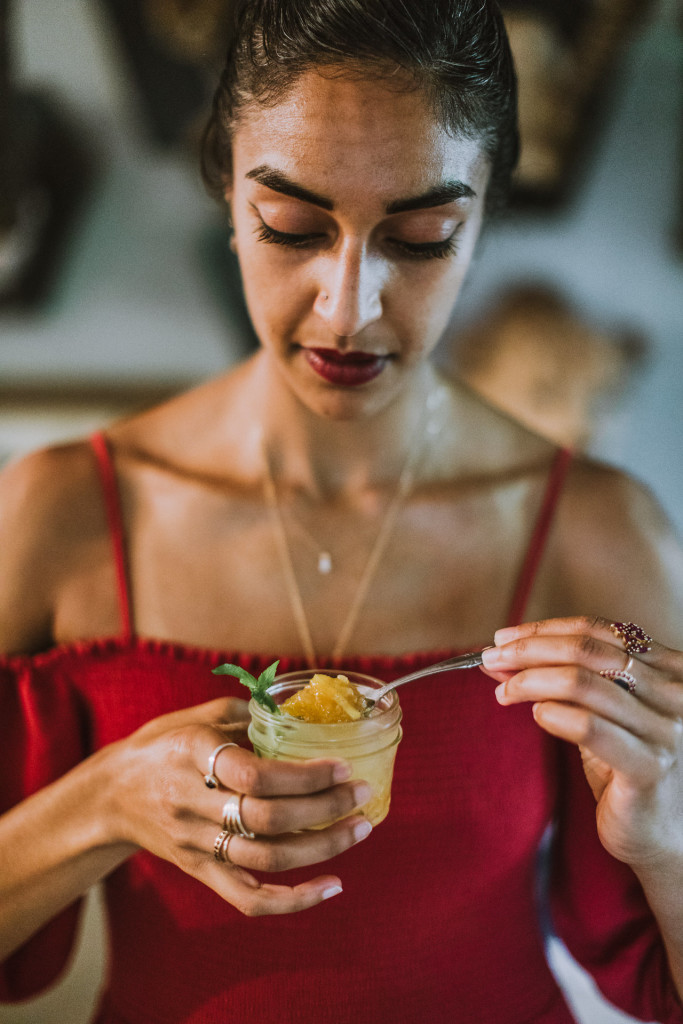 Photo by Rick Cortez.
Photo by Rick Cortez.
Ingredients:
- 3 oz ginger and lemongrass-infused gin (slice about 1/4 cup each of ginger root - scrubbed with skin on is fine - and white part of lemongrass stalks and place into gin bottle (1.75L), shake daily until infused to your liking)
- 1 oz fresh lemon juice
- 0.5 -1 oz agave syrup
- 1 teaspoon yellow tomato jam*
- Tiny spoons to serve in drinks
- 1 lb yellow tomatoes, cut into 8 pieces or small chunks
- 1 inch ginger root, peeled and cut into very thin strips
- 1 cinnamon stick
- 1 vanilla bean, split, seeds scraped in. (Save vanilla bean for another use or throw it in the pot too!)
- 10 whole black peppercorns
- 1 tablespoon apple cider vinegar
- 1 cup sugar
- 1/2 teaspoon salt
Combine all ingredients in a saucepan and bring to a boil
Reduce heat and simmer until reduced and thick - it will continue to thicken a bit as it cools
 Photo by Rick Cortez.
Photo by Rick Cortez.
Instructions:
Stir together gin, lemon juice, and agave syrup.
Fill glasses with ice and pour vodka mixture over ice.
Spoon jam into glasses and place on top of ice so you can stir in as much jam as you like. Enjoy!
 Photo by Rick Cortez.
Photo by Rick Cortez.WEEK 29 IN PHOTOS
07/21/17 — Heydon Hatcher
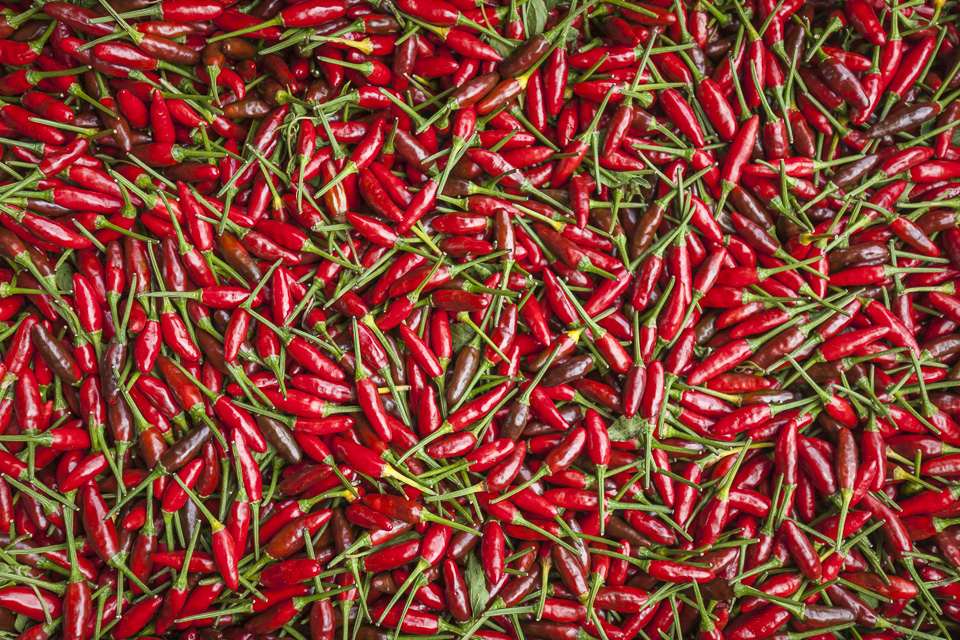 Photo by Scott David Gordon.
Photo by Scott David Gordon.
We are in the thick of summer, and despite the stifling heat, we've been planting collards, kale, kohlrabi, bok choy, and dandelion greens. You have to plant the transplants early in the morning so that they don't wilt in the midday scorch, but we have them successfully in the ground and couldn't be more excited. Pigs, raccoons, and deer have been coming after our melons as of late, which has been a catalyst for us to finish the fence around the periphery of the farm. We harvested our first sweet potatoes this week, thanks to our Farm Manager, Becky! This is the earliest we have ever had this crop ready to harvest!
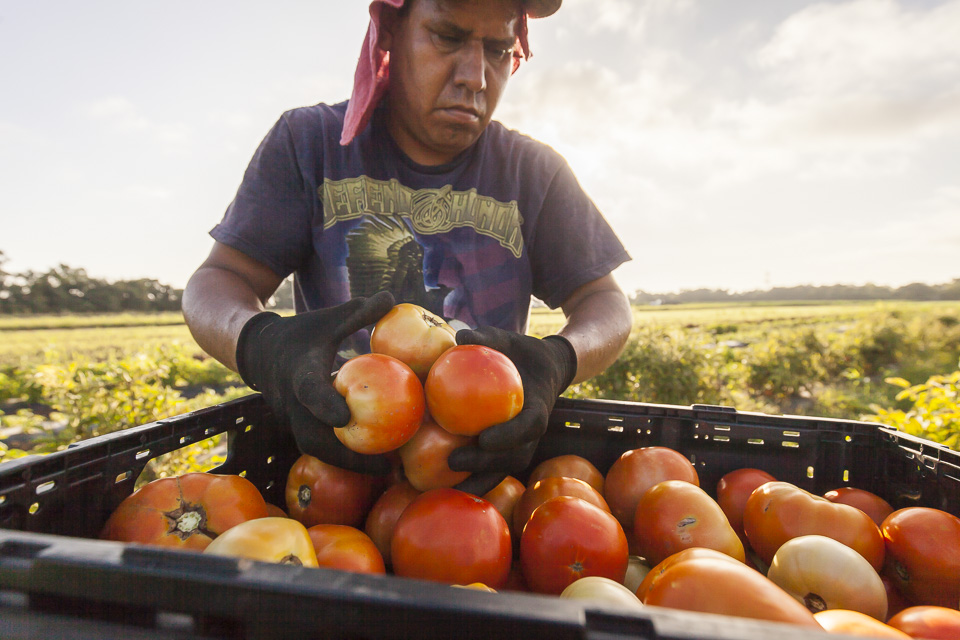 Photo by Scott David Gordon.
Photo by Scott David Gordon.
 Photo by Scott David Gordon.
Photo by Scott David Gordon.
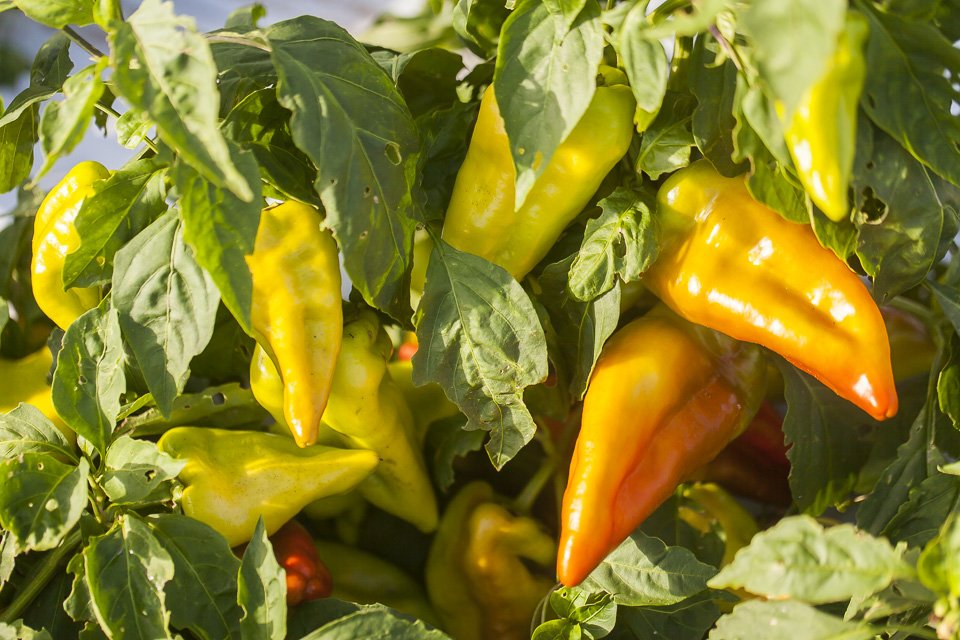 Photo by Scott David Gordon.
Photo by Scott David Gordon.
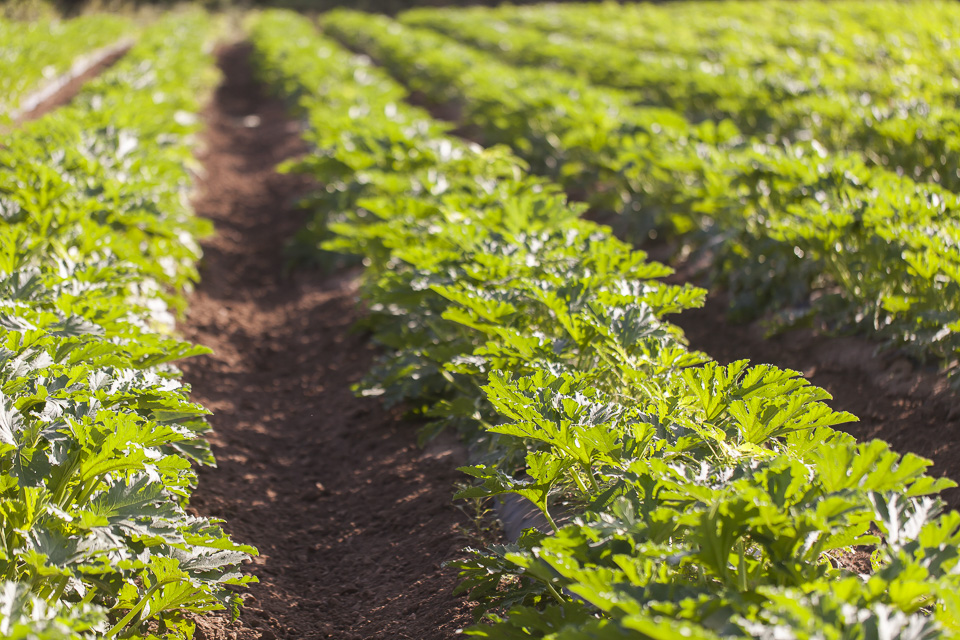 Photo by Scott David Gordon.
Photo by Scott David Gordon.
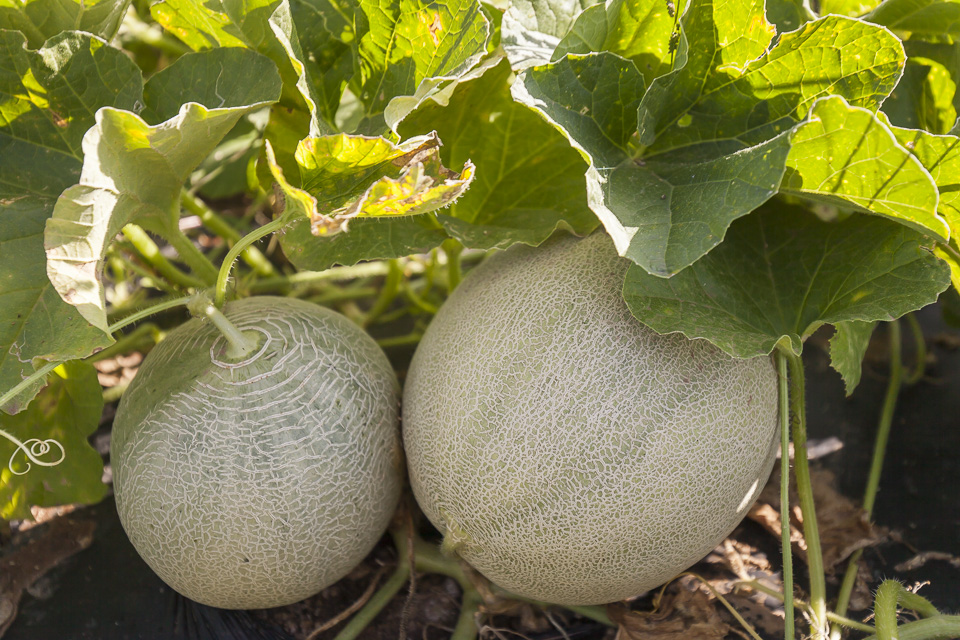 Photo by Scott David Gordon.
Photo by Scott David Gordon.
 Photo by Scott David Gordon.
Photo by Scott David Gordon.
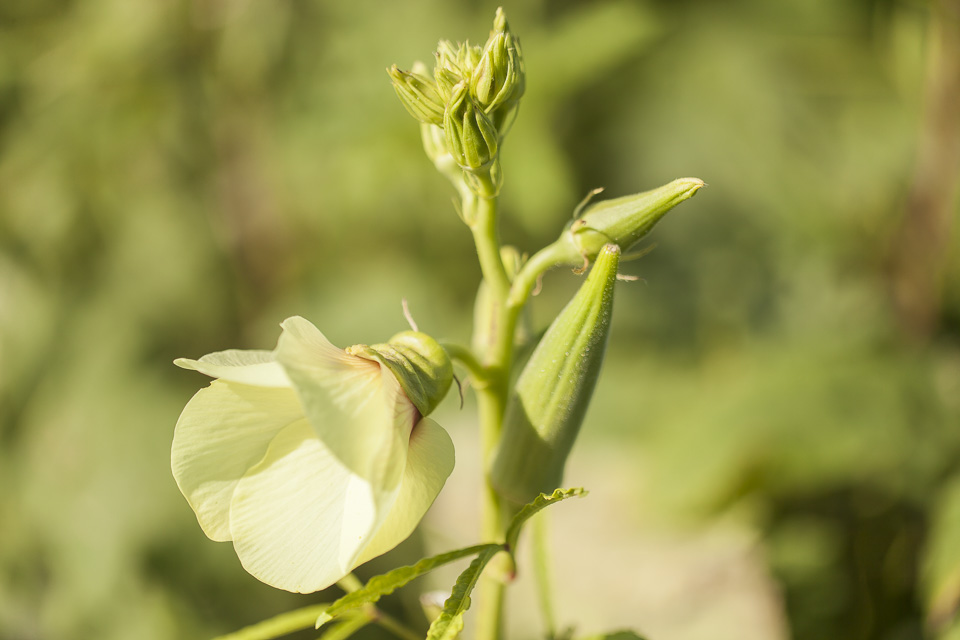 Photo by Scott David Gordon.
Photo by Scott David Gordon.
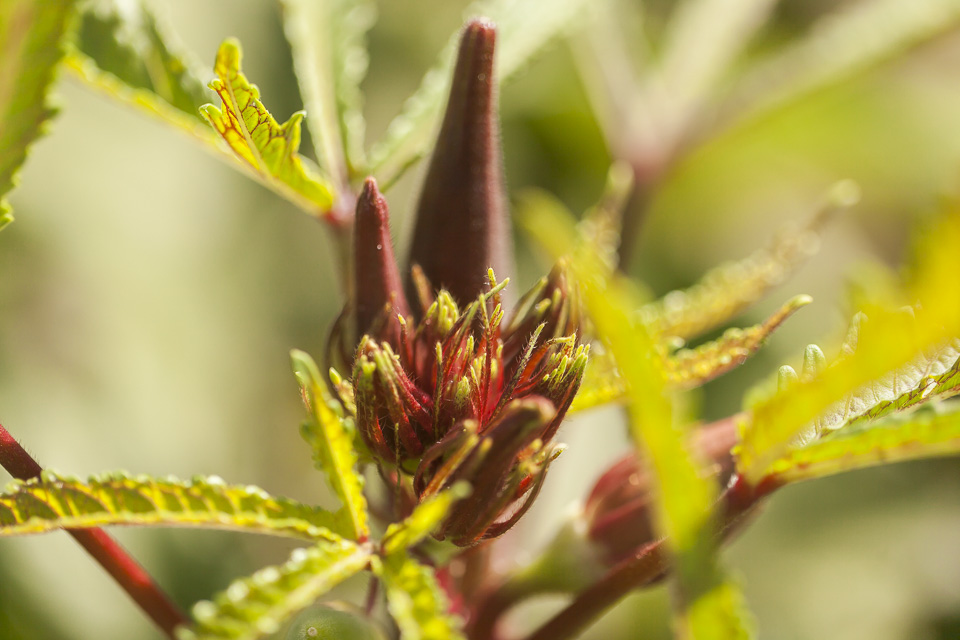 Photo by Scott David Gordon.
Photo by Scott David Gordon.
 Photo by Scott David Gordon.
Photo by Scott David Gordon.
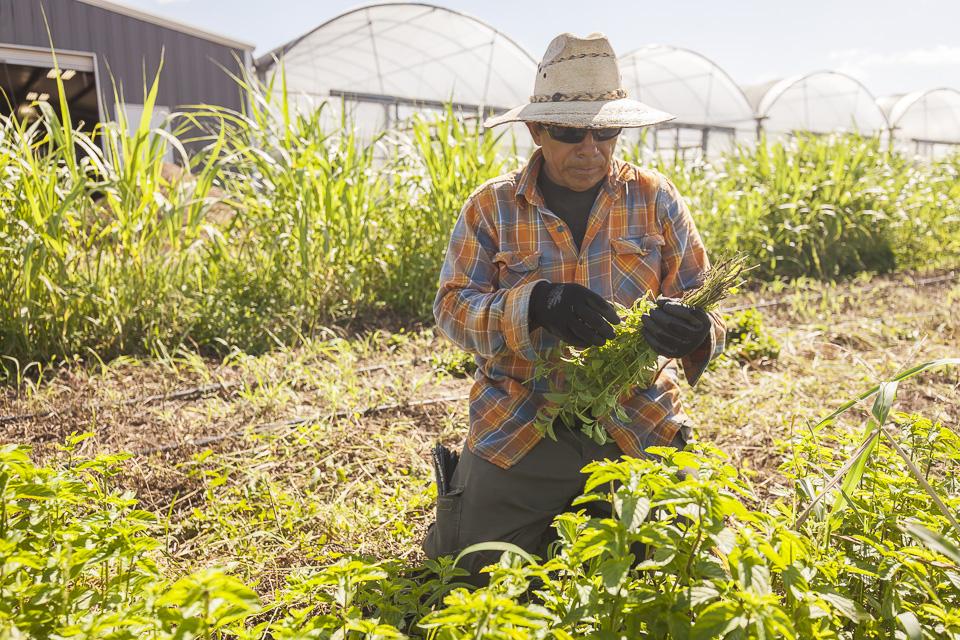 Photo by Scott David Gordon.
Photo by Scott David Gordon.
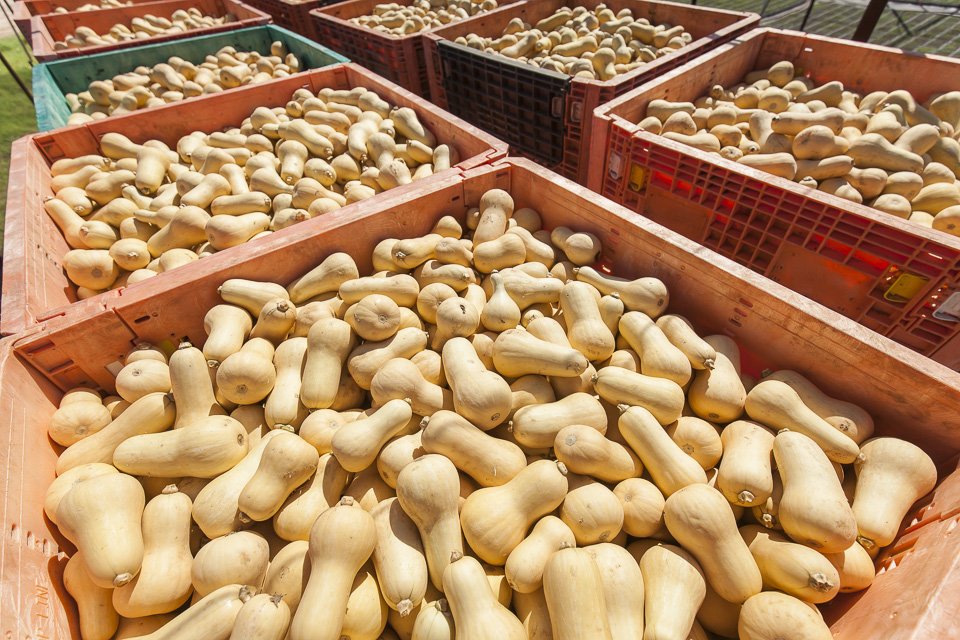 Photo by Scott David Gordon.
Photo by Scott David Gordon.
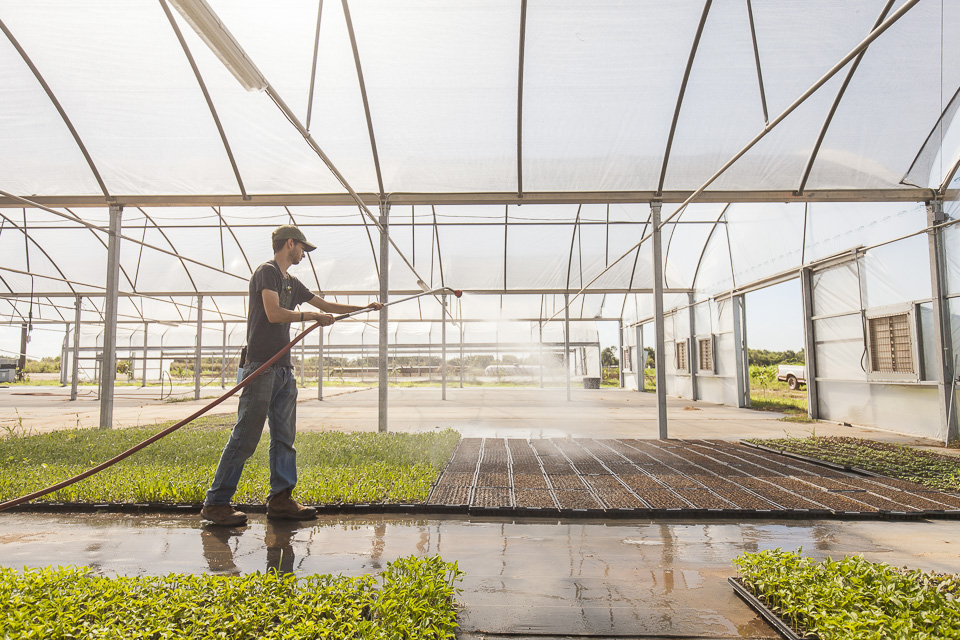 Photo by Scott David Gordon.
Photo by Scott David Gordon.
 Photo by Scott David Gordon.
Photo by Scott David Gordon.
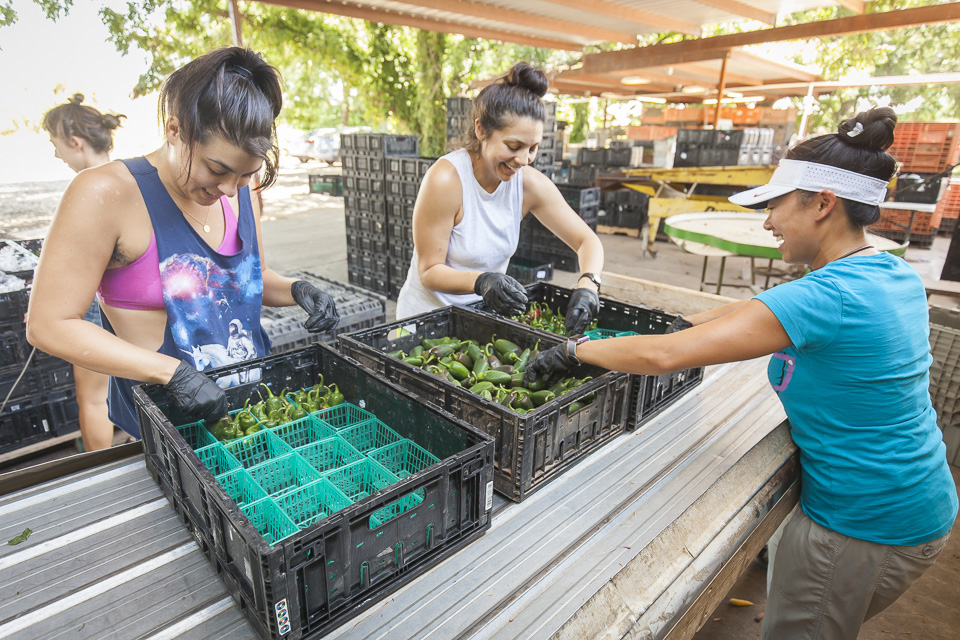 Photo by Scott David Gordon.
Photo by Scott David Gordon.
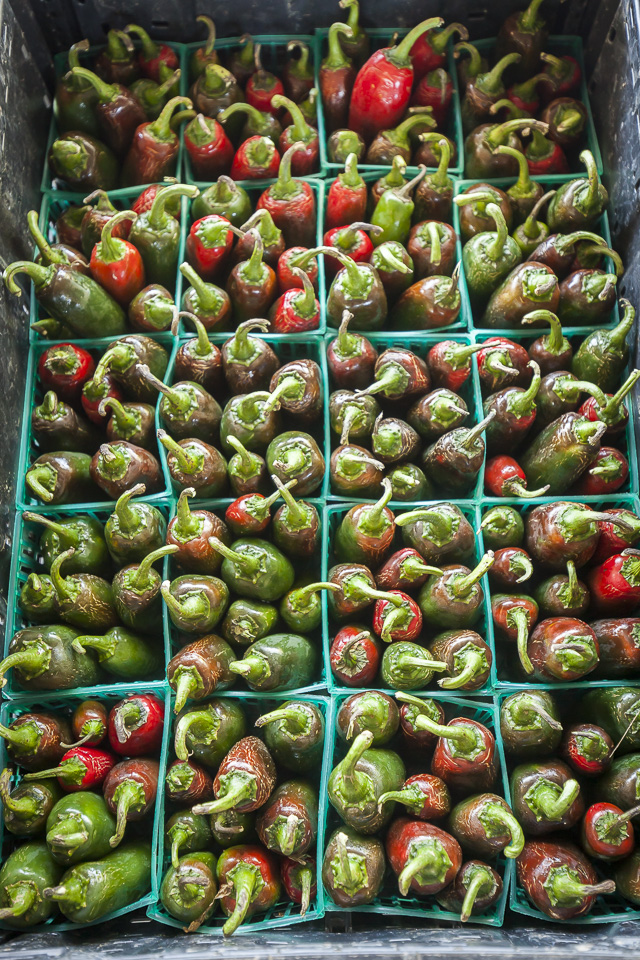 Photo by Scott David Gordon.
Photo by Scott David Gordon.
 Photo by Scott David Gordon.
Photo by Scott David Gordon.
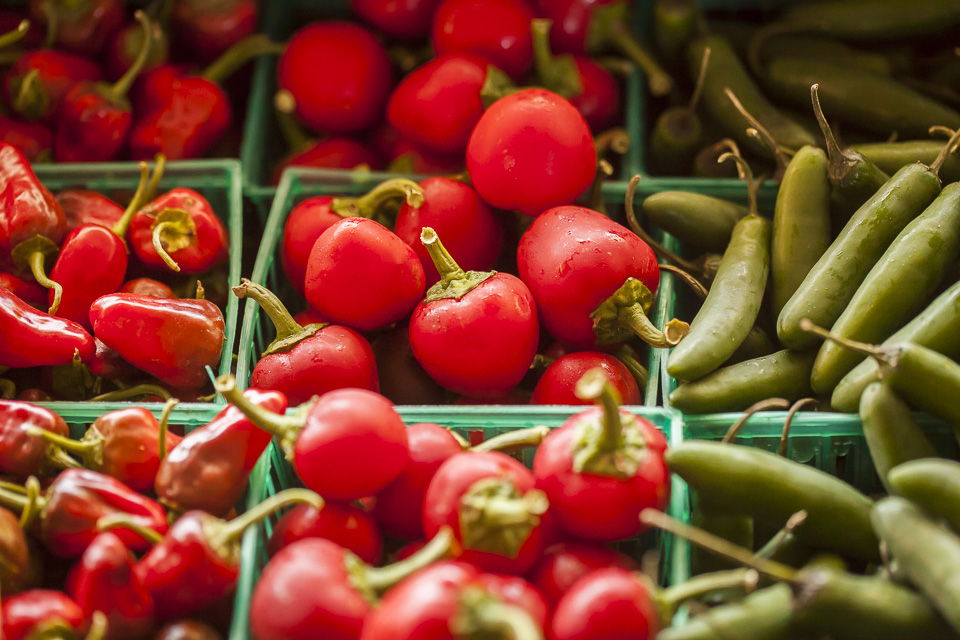 Photo by Scott David Gordon.
Photo by Scott David Gordon.
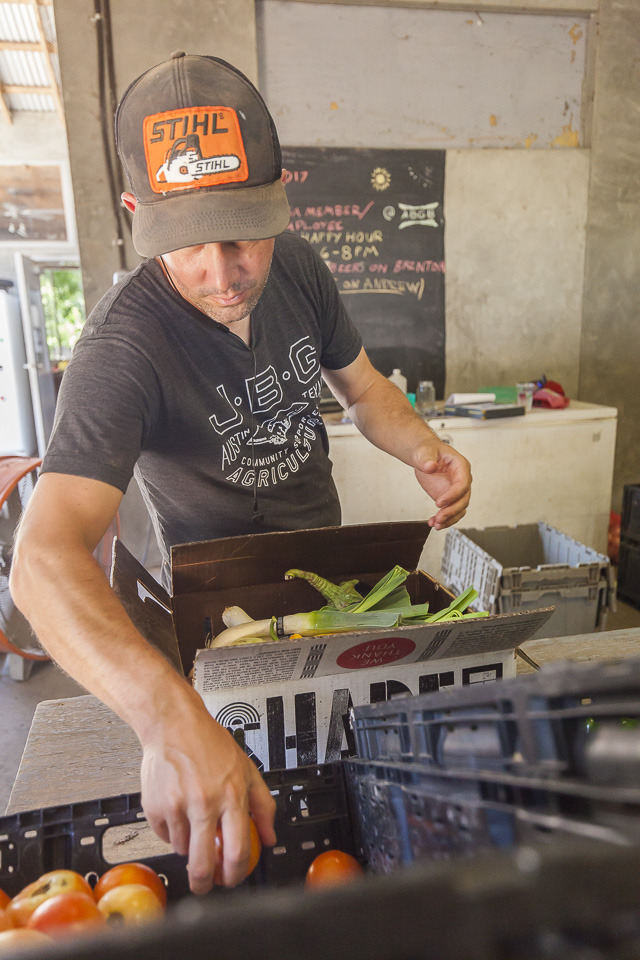 Photo by Scott David Gordon.
Photo by Scott David Gordon.NOTES FROM THE FIELD: SUMMERTIME FARMING
07/21/17 — Heydon Hatcher
You might be wondering how it's possible for us to continue our roll through these sweat-soaked, sun-laden dog days of summer... so this week, we wanted to shed some light on how we slightly alter our practices so that we can farm year-round! A lot of farms will shut down during July and August because of the extreme and scorching conditions, but here at JBG, we keep truckin’ along through the depths of summertime. Let’s just say farming is not for the faint of heart. There are a handful of procedures that we adhere to in order that our employees and veggies can stay as cool as possible.
![Sunrise. Photo by Scott David Gordon.]() Sunrise. Photo by Scott David Gordon.
Sunrise. Photo by Scott David Gordon.
![Photo by Scott David Gordon.]() Photo by Scott David Gordon.
Photo by Scott David Gordon.
One of the things that really helps is starting at daybreak. Imagine everyone rolling into the dewey and pitchblack farm, headlights on, and preparing for daily tasks in the cool morning air. We usually have the tractors running by 6 AM and are wrapping up work for the day promptly after lunch. This schedule allows us to circumvent being out in the fields during the hottest part of the day. This week alone the temperatures have been at sustained 100+! Sun protection is of utmost importance as well, lots of wide brimmed hats and long-sleeves. When rainfall is sparse, dust abounds at the farm; thus, bandanas are necessary and greatly useful. Hydration is key along with a constant supply of electrolyte packs (plus, that highly coveted ice machine at the farm to really cool things down), but what has really kept everyone going this year are the melon breaks. A Hergotz favorite is watermelon with a sprinkle of tajin. You should try it!
![Photo by Scott David Gordon.]() Photo by Scott David Gordon.
Photo by Scott David Gordon.
![Photo by Scott David Gordon.]() Photo by Scott David Gordon.
Photo by Scott David Gordon.
Everything gets trickier in terms of keeping quality at a premium during these summer months. Once the produce is harvested, the veggies retain field heat that needs to be removed quickly so that the condition remains high and the vegetables don’t start to decay. Some crops like tomatoes need to be harvested in the early mornings, as it is integral to pluck the fruits while they are still cool from the overnight reprieve; otherwise, it tends to get too hot on the fields for those veggies to continue to thrive. Our harvest trailers have been revolutionary for summertime farming, and in this specific situation, it aids in getting the produce immediately out of the sun post-harvest and underneath a canopy for some shade. It also generally reduces the backbreaking work for our field crew as they can harvest alongside the vehicle since the arms on the vehicle reach out 5 rows wide. All of our post-harvest handling during the summer is very focused on maintaining the cool chain, which simply put means removing field heat and keeping the produce cold to ensure tip-top shape for the customer. Thus, cooler organization is very important so we can get harvest bins into the cold as quickly and efficiently as possible. The coolers are packed to the brim in the summer, and we only pull out exactly what we need so that the veggies can stay cool.
![Harvest trailer. Photo by Scott David Gordon.]() Harvest trailer. Photo by Scott David Gordon.
Harvest trailer. Photo by Scott David Gordon.
![Harvest trailer. Photo by Scott David Gordon.]() Harvest trailer. Photo by Scott David Gordon.
Harvest trailer. Photo by Scott David Gordon.
Deliveries are even affected by the change in temperatures. The ceaseless heat can make the tires blow out; so, maintaining delivery vehicle wear and tear helps prevent any scheduled delivery mishaps. It goes without saying, but air conditioning unit maintenance is crucial, too. Speaking of deliveries... CSA members, did you know that if you receive home deliveries and leave a cooler on your front porch, our delivery driver will transfer your veggies directly into the cooler! Also, those who pick up, get to your site early to make sure that those veggies aren’t baking in the box.
![Photo by Scott David Gordon.]() Photo by Scott David Gordon.
Photo by Scott David Gordon.
 Sunrise. Photo by Scott David Gordon.
Sunrise. Photo by Scott David Gordon.
 Photo by Scott David Gordon.
Photo by Scott David Gordon.
One of the things that really helps is starting at daybreak. Imagine everyone rolling into the dewey and pitchblack farm, headlights on, and preparing for daily tasks in the cool morning air. We usually have the tractors running by 6 AM and are wrapping up work for the day promptly after lunch. This schedule allows us to circumvent being out in the fields during the hottest part of the day. This week alone the temperatures have been at sustained 100+! Sun protection is of utmost importance as well, lots of wide brimmed hats and long-sleeves. When rainfall is sparse, dust abounds at the farm; thus, bandanas are necessary and greatly useful. Hydration is key along with a constant supply of electrolyte packs (plus, that highly coveted ice machine at the farm to really cool things down), but what has really kept everyone going this year are the melon breaks. A Hergotz favorite is watermelon with a sprinkle of tajin. You should try it!
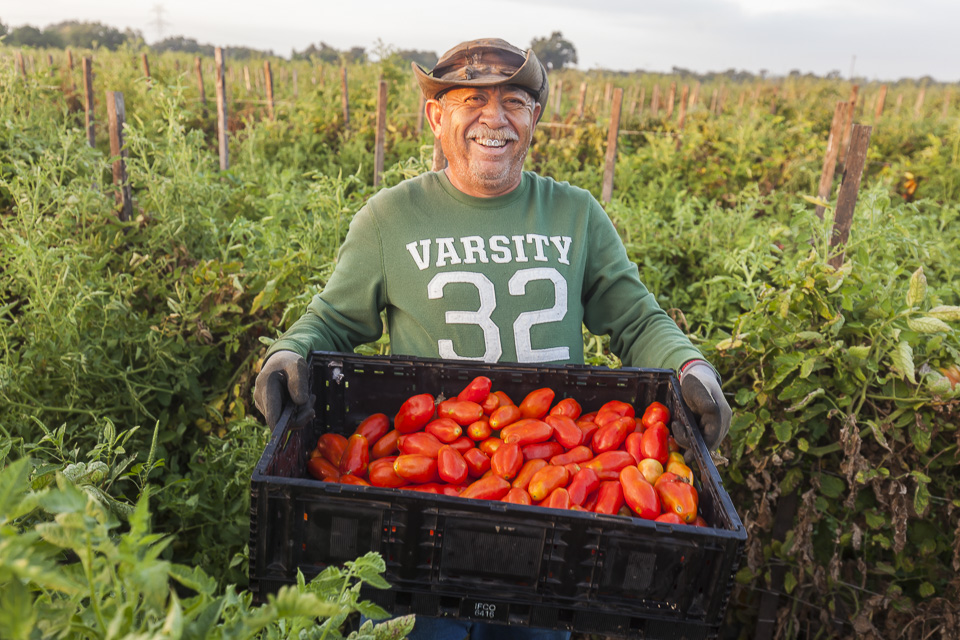 Photo by Scott David Gordon.
Photo by Scott David Gordon.
 Photo by Scott David Gordon.
Photo by Scott David Gordon.
Everything gets trickier in terms of keeping quality at a premium during these summer months. Once the produce is harvested, the veggies retain field heat that needs to be removed quickly so that the condition remains high and the vegetables don’t start to decay. Some crops like tomatoes need to be harvested in the early mornings, as it is integral to pluck the fruits while they are still cool from the overnight reprieve; otherwise, it tends to get too hot on the fields for those veggies to continue to thrive. Our harvest trailers have been revolutionary for summertime farming, and in this specific situation, it aids in getting the produce immediately out of the sun post-harvest and underneath a canopy for some shade. It also generally reduces the backbreaking work for our field crew as they can harvest alongside the vehicle since the arms on the vehicle reach out 5 rows wide. All of our post-harvest handling during the summer is very focused on maintaining the cool chain, which simply put means removing field heat and keeping the produce cold to ensure tip-top shape for the customer. Thus, cooler organization is very important so we can get harvest bins into the cold as quickly and efficiently as possible. The coolers are packed to the brim in the summer, and we only pull out exactly what we need so that the veggies can stay cool.
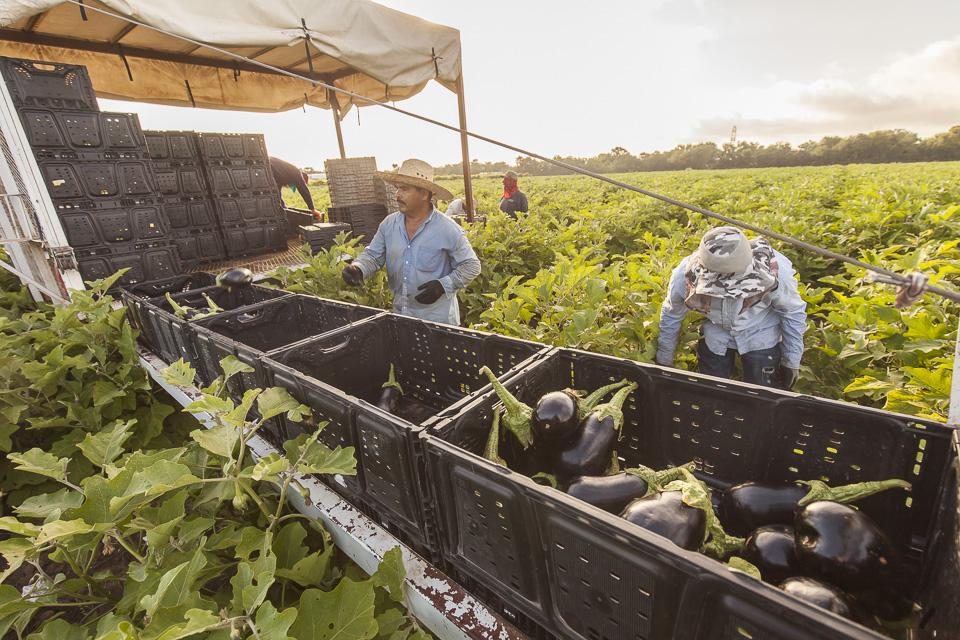 Harvest trailer. Photo by Scott David Gordon.
Harvest trailer. Photo by Scott David Gordon.
 Harvest trailer. Photo by Scott David Gordon.
Harvest trailer. Photo by Scott David Gordon.
Deliveries are even affected by the change in temperatures. The ceaseless heat can make the tires blow out; so, maintaining delivery vehicle wear and tear helps prevent any scheduled delivery mishaps. It goes without saying, but air conditioning unit maintenance is crucial, too. Speaking of deliveries... CSA members, did you know that if you receive home deliveries and leave a cooler on your front porch, our delivery driver will transfer your veggies directly into the cooler! Also, those who pick up, get to your site early to make sure that those veggies aren’t baking in the box.
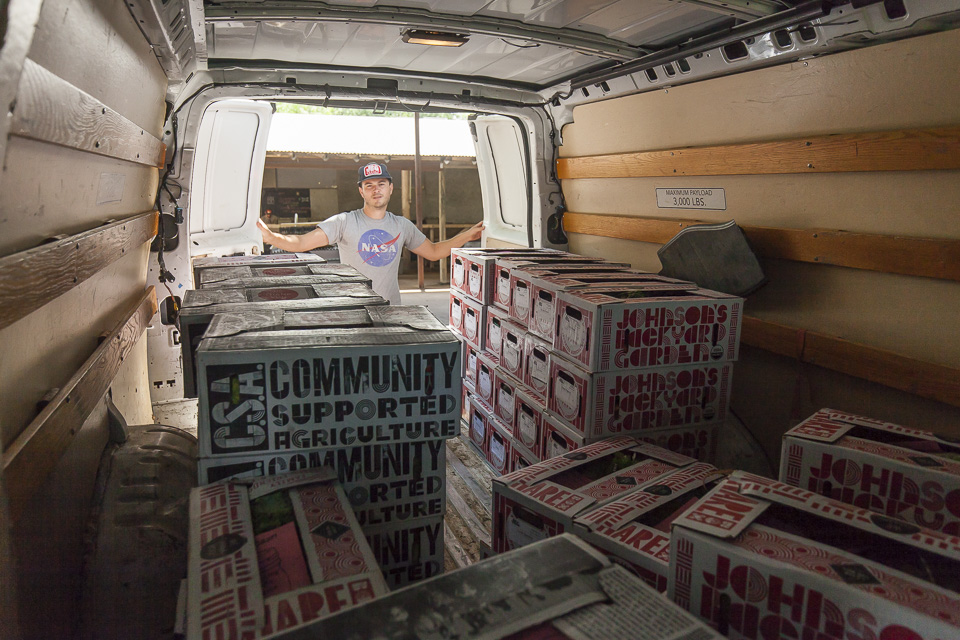 Photo by Scott David Gordon.
Photo by Scott David Gordon.CSA BOX CONTENTS WEEK OF JULY 24TH
07/25/17 — Scott
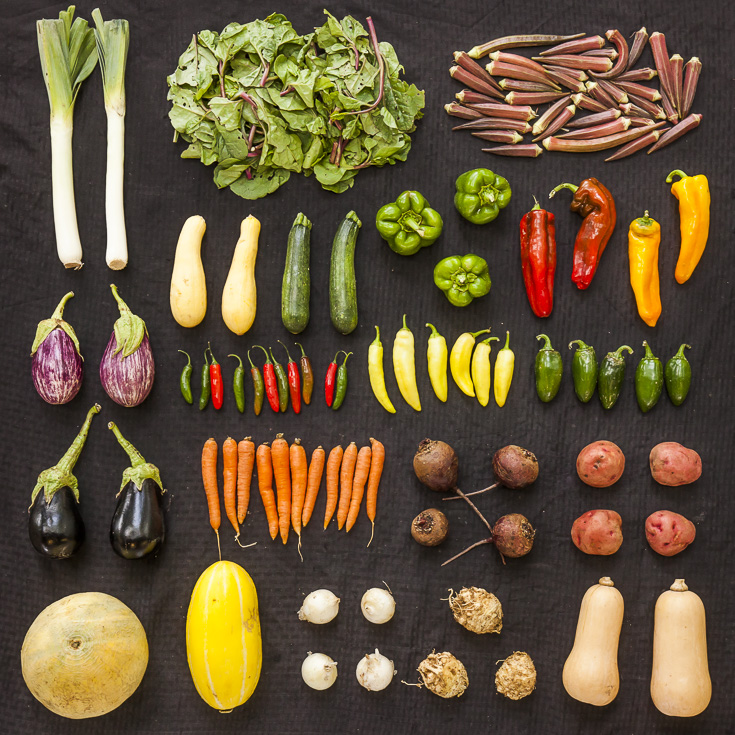 CSA Box Contents Week of July 24th
CSA Box Contents Week of July 24th
Large Box
Beet, Red
Carrot, Red
Eggplant, Medley
Greens, Sweet Potato
Herb, Peppermint
Melon, Farmers Choice
Okra
Onion, Yellow
Pepper, Jalapeno
Pepper, Sweet Medley
Potato, Red
Squash, Butternut
Squash, Yellow
Beet, Red
Carrot, Red
Eggplant, Medley
Greens, Sweet Potato
Herb, Peppermint
Melon, Farmers Choice
Okra
Onion, Yellow
Pepper, Jalapeno
Pepper, Sweet Medley
Potato, Red
Squash, Butternut
Squash, Yellow
Medium Box
Carrot, Red
Eggplant, Medley
Greens, Sweet Potato
Melon, Farmers Choice
Okra
Onion, Yellow
Pepper, Sweet Medley
Potato, Red
Squash, Butternut
Squash, Yellow
Carrot, Red
Eggplant, Medley
Greens, Sweet Potato
Melon, Farmers Choice
Okra
Onion, Yellow
Pepper, Sweet Medley
Potato, Red
Squash, Butternut
Squash, Yellow
Small Box
Carrot, Red
Greens, Sweet Potato
Herb, Peppermint
Melon, Farmers Choice
Pepper, Sweet Medley
Potato, Red
Squash, Butternut
Squash, Yellow
Carrot, Red
Greens, Sweet Potato
Herb, Peppermint
Melon, Farmers Choice
Pepper, Sweet Medley
Potato, Red
Squash, Butternut
Squash, Yellow
Individual Box
Eggplant, Medley
Greens, Sweet Potato
Melon, Farmers Choice
Okra
Pepper, Sweet Medley
Potato, Red
Eggplant, Medley
Greens, Sweet Potato
Melon, Farmers Choice
Okra
Pepper, Sweet Medley
Potato, Red
CSA BOX CONTENTS WEEK OF JULY 24TH
07/25/17 — Scott
 CSA Box Contents Week of July 24th
CSA Box Contents Week of July 24th
Medium Box
Beet, Red
Carrot, Orange
Eggplant, Medley
Melon, Farmers Choice
Okra
Onion, White
Pepper, Sweet Medley
Potato, Red
Squash, Butternut
Squash, Yellow
TOMATO & PEACH SALAD WITH LABNE & TOMATO VINAIGRETTE
07/25/17 — Heydon Hatcher
Recipe by Mackenzie Smith
The plan was to make some fourteen dishes to feature in our tomato supper with JBG a few months ago, but my pup got sick and had to be taken to the ER the day of, all while I was supposed to be prepping for the meal. Hours of prep time were lost as I was thinking more about my dog than I was about dinner. Those fourteen dishes quickly turned into about 8. Frazzled, I showed up to Van’s house with plenty of the ingredients for the dishes I opted not to make, and set out to finish the dishes that I knew I could pull off in time. On the “cutting room floor” of the larger list was a tomato, avocado and cucumber salad served atop a swoosh of labne, a riff on Cheryl Sternman Rule’s delicious recipe from her book, Yogurt Culture. I had the labne, but the cucumbers were sitting pretty in my refrigerator back home.
![Photo by Rick Cortez.]() Photo by Rick Cortez.
Photo by Rick Cortez.
I had made Short Stack Editions' tomato vinaigrette the night before, so when Ada asked what she could do to help, I told her to cut up the tomato and peaches and put them in a bowl together (7 other dishes on the backburner, Nadia’s cocktails flowing freely and dear friends showing up every 10 minutes). I tossed them in the vinaigrette, schmeared one of Van’s beautiful old platters with a giant serving-spoonful of labne, and covered it with the tomato peach mixture before sprinkling with a handful of basil, parsley and mint.
My plan for this dish was to use Short Stack’s recipe for tomato & peach salad with tomato vinaigrette in their big book, but that recipe says to “arrange the tomatoes and peaches in a single, interspersed layer. Drizzle the vinaigrette over the fruit.” Ha, single layer? Drizzle? I guess I lost those instructions somewhere on that cutting room floor. This was a pile of summer’s most precious gems, macerated in a perfect dressing and swooshed around with tangy labne and a hunk of sourdough from Easy Tiger. Both takes on this salad will taste like Summer on a plate, so long as you buy the ingredients at their peak.
![Photo by Rick Cortez.]() Photo by Rick Cortez.
Photo by Rick Cortez.
Short Stack Editions Tomato Vinaigrette (double this recipe and use in on your summer produce all week! It is so good!)
In a bowl, combine all the ingredients and let them sit for an hour. Transfer the mixture to a blender or food processor and process until smooth.
Mix tomatoes, peaches and vinaigrette together. On a large platter, spread the labne with the back of a big spoon so the middle of the platter is empty, leaving a tiny wall of labne to receive the salad. Spoon the salad on the platter and top with herbs. Serve with crusty sourdough.
![Photo by Rick Cortez.]() Photo by Rick Cortez.
Photo by Rick Cortez.
The plan was to make some fourteen dishes to feature in our tomato supper with JBG a few months ago, but my pup got sick and had to be taken to the ER the day of, all while I was supposed to be prepping for the meal. Hours of prep time were lost as I was thinking more about my dog than I was about dinner. Those fourteen dishes quickly turned into about 8. Frazzled, I showed up to Van’s house with plenty of the ingredients for the dishes I opted not to make, and set out to finish the dishes that I knew I could pull off in time. On the “cutting room floor” of the larger list was a tomato, avocado and cucumber salad served atop a swoosh of labne, a riff on Cheryl Sternman Rule’s delicious recipe from her book, Yogurt Culture. I had the labne, but the cucumbers were sitting pretty in my refrigerator back home.
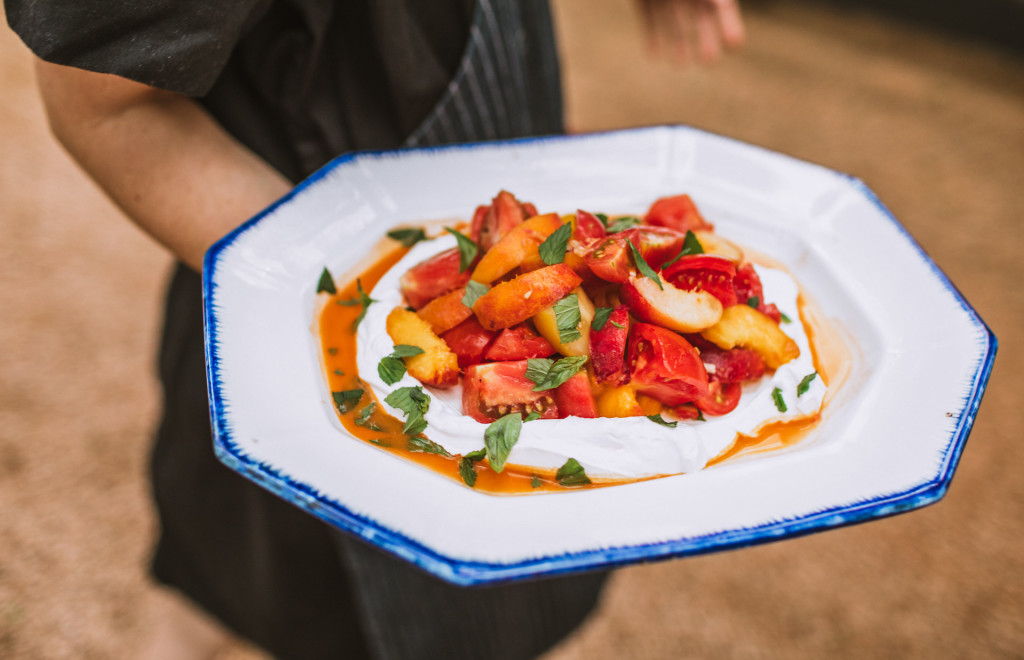 Photo by Rick Cortez.
Photo by Rick Cortez.
I had made Short Stack Editions' tomato vinaigrette the night before, so when Ada asked what she could do to help, I told her to cut up the tomato and peaches and put them in a bowl together (7 other dishes on the backburner, Nadia’s cocktails flowing freely and dear friends showing up every 10 minutes). I tossed them in the vinaigrette, schmeared one of Van’s beautiful old platters with a giant serving-spoonful of labne, and covered it with the tomato peach mixture before sprinkling with a handful of basil, parsley and mint.
My plan for this dish was to use Short Stack’s recipe for tomato & peach salad with tomato vinaigrette in their big book, but that recipe says to “arrange the tomatoes and peaches in a single, interspersed layer. Drizzle the vinaigrette over the fruit.” Ha, single layer? Drizzle? I guess I lost those instructions somewhere on that cutting room floor. This was a pile of summer’s most precious gems, macerated in a perfect dressing and swooshed around with tangy labne and a hunk of sourdough from Easy Tiger. Both takes on this salad will taste like Summer on a plate, so long as you buy the ingredients at their peak.
- 2 pounds of mixed heirloom tomatoes, slices crosswise, ½ inch thick
- 3 ripe peaches, pitted and sliced into ¼-inch-thick wedges
- ½ cup Tomato Vinaigrette
- 12 medium basil leaves, torn
- 1-2 tablespoons chopped parsley
- 1 tablespoon chopped mint
- Course sea salt and freshly ground black pepper
- 3/4 cup of labne (plain greek yogurt works just as well here)
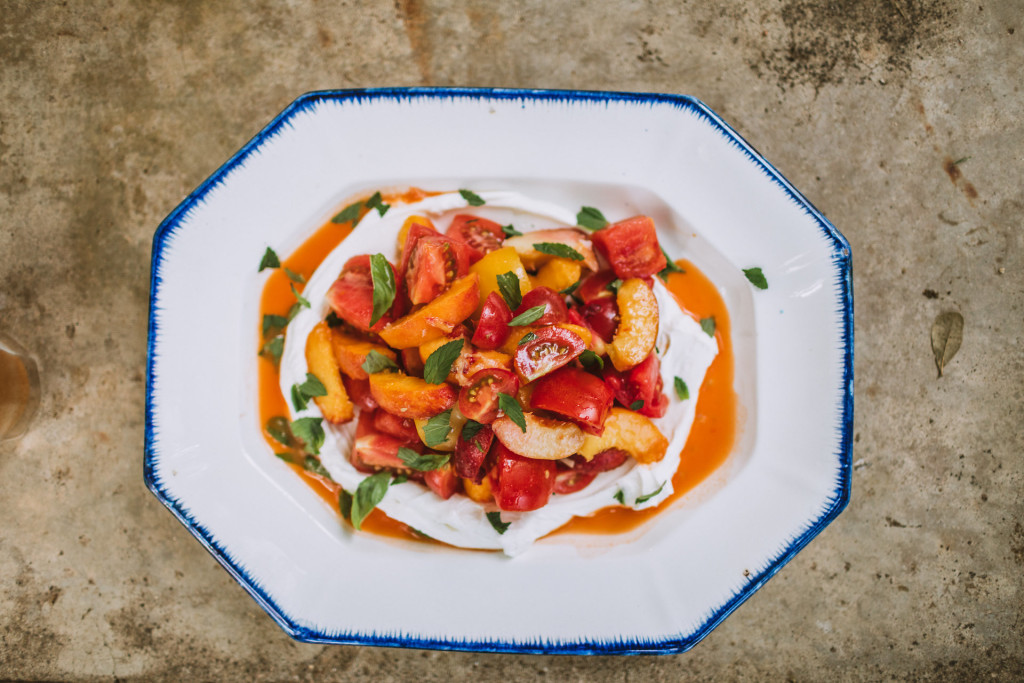 Photo by Rick Cortez.
Photo by Rick Cortez.
Short Stack Editions Tomato Vinaigrette (double this recipe and use in on your summer produce all week! It is so good!)
- ½ cup diced ripe tomatoes
- 1 teaspoon chopped garlic
- 3 tablespoons fresh lemon juice
- 3 tablespoons sherry vinegar
- Pinch red pepper flakes
- ¼ cup + 3 tablespoons extra-virgin olive oil
- Salt and freshly ground black pepper
In a bowl, combine all the ingredients and let them sit for an hour. Transfer the mixture to a blender or food processor and process until smooth.
Mix tomatoes, peaches and vinaigrette together. On a large platter, spread the labne with the back of a big spoon so the middle of the platter is empty, leaving a tiny wall of labne to receive the salad. Spoon the salad on the platter and top with herbs. Serve with crusty sourdough.
 Photo by Rick Cortez.
Photo by Rick Cortez.WEEK 30 IN PHOTOS
07/28/17 — Heydon Hatcher
 Photo by Scott David Gordon.
Photo by Scott David Gordon.
Another scorcher of a week down in the books! We planted fall peppers, cucumbers, kale, summer squash, and daikon radishes. We are readying the soil for fall, and seeded beets and carrots. See you at markets this weekend!
 Photo by Scott David Gordon.
Photo by Scott David Gordon.
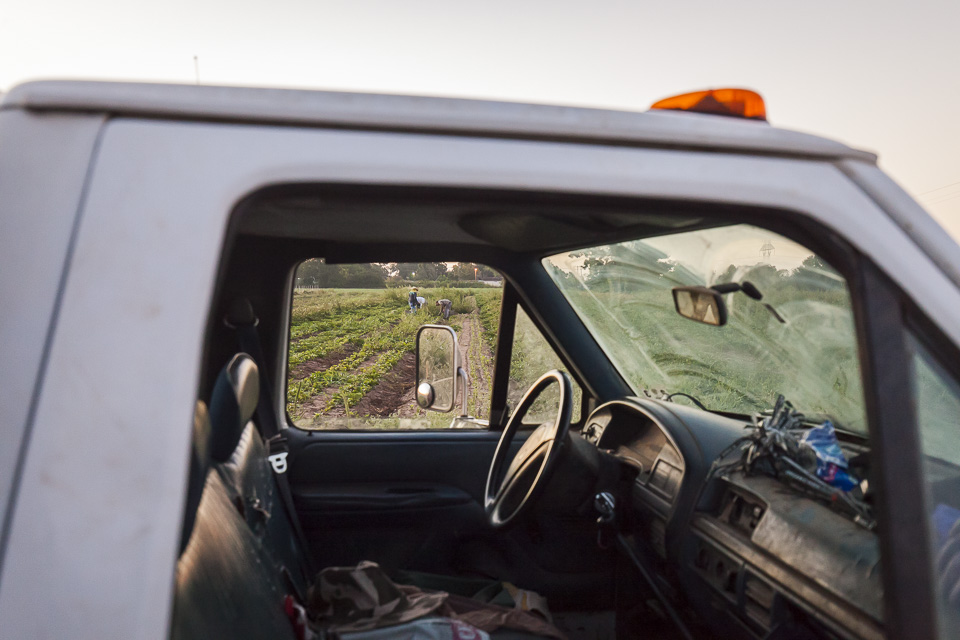 Photo by Scott David Gordon.
Photo by Scott David Gordon.
 Photo by Scott David Gordon.
Photo by Scott David Gordon.
 Photo by Scott David Gordon.
Photo by Scott David Gordon.
 Photo by Scott David Gordon.
Photo by Scott David Gordon.
 Photo by Scott David Gordon.
Photo by Scott David Gordon.
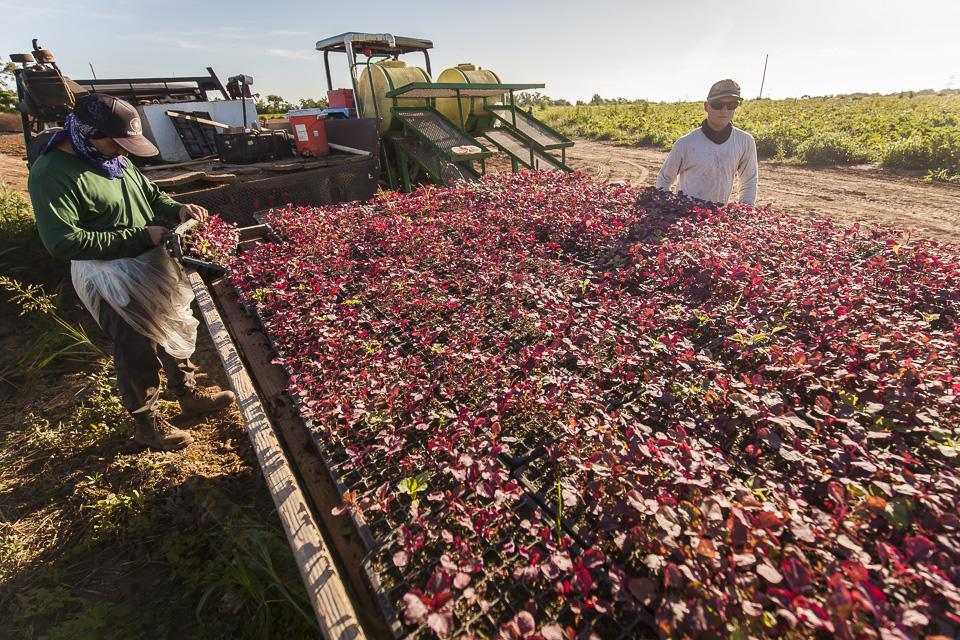 Photo by Scott David Gordon.
Photo by Scott David Gordon.
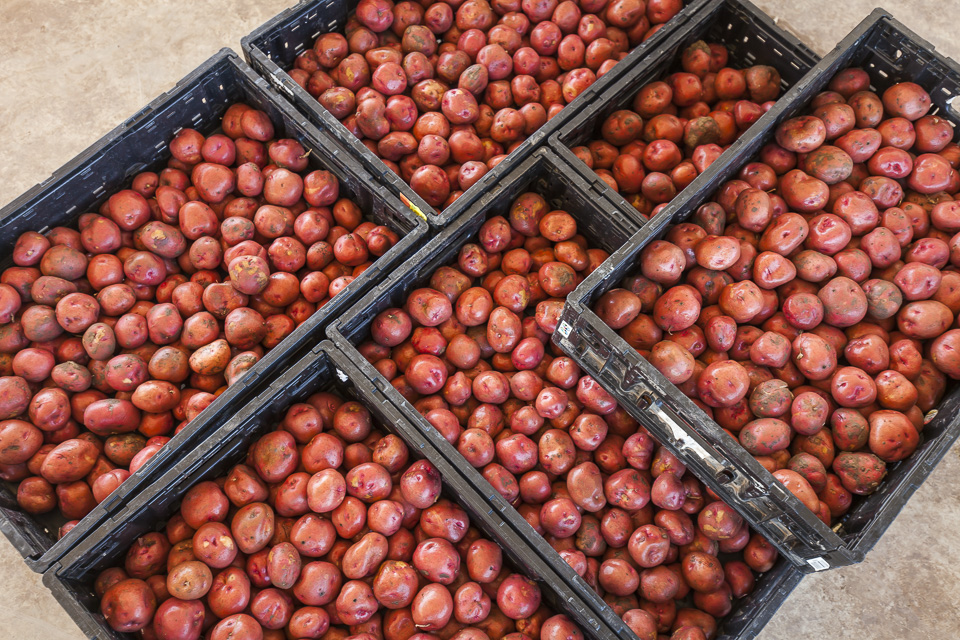 Photo by Scott David Gordon.
Photo by Scott David Gordon.
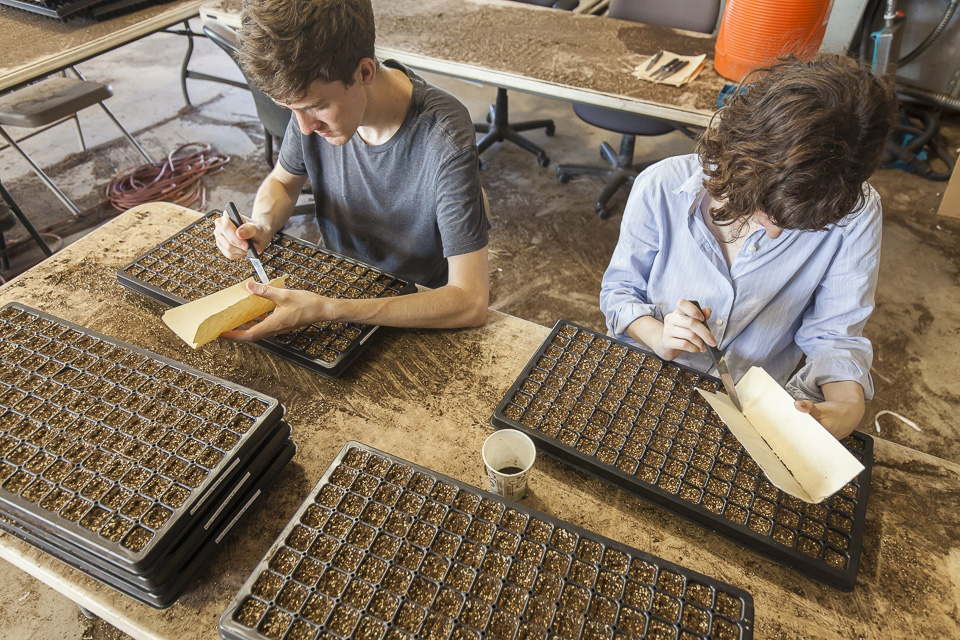 Photo by Scott David Gordon.
Photo by Scott David Gordon.
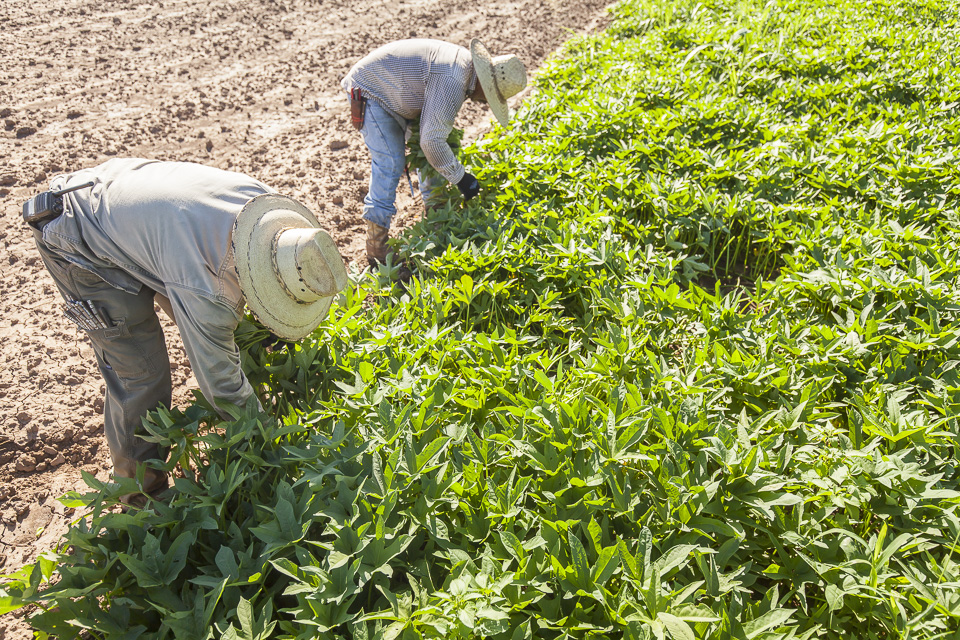 Photo by Scott David Gordon.
Photo by Scott David Gordon.THE DIRT ON JBG'S COVER CROPS
07/28/17 — Heydon Hatcher
 Photo by Scott David Gordon.
Photo by Scott David Gordon.
Have you ever heard of cover crops? If not, you’re in luck because this week we are geeking out on them and all the benefits they provide for us out at the farm. Cover crops are a crop grown for the protection and enrichment of the soil, not for profit. They are used in vegetable rotation for a multitude of reasons, one of which is perpetuating soil health, as vegetable production depletes the soil of nutrients and ultimately limits productivity. There are lots of different cover crops to choose from, especially depending on the season, but currently we are using Sorghum sudangrass, Buckwheat, and Iron and Clay Cowpeas which are all very fast growing, drought tolerant, and love the heat. Right now, we have 45 acres of the farmland planted with cover crops (that’s a fourth of our entire farm!). They protect the soil from erosion that wind and rain can wreak upon unoccupied soil. Bare soil absorbs solar radiation which dries it out, creating massive hard, cracked clods of soil. Plus, the unimpeded heat and direct sun kills the beneficial microorganisms within the soil. Cover crops make for an awesome environment for advantageous bugs, keeps the dust down, quells soilborne diseases, among a plethora of other things.
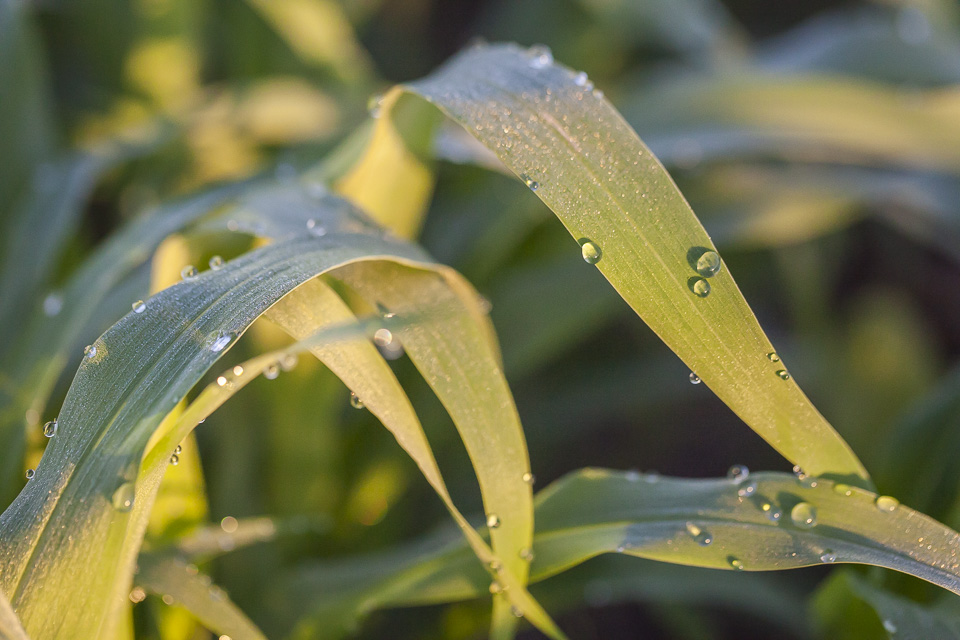 Photo by Scott David Gordon.
Photo by Scott David Gordon.
Lots of nutrients are left in the soil at the end of cropping cycles. For example, when we put down a layer of compost for a squash crop, the crop doesn’t necessarily utilize all the nutrients readily available in the soil during it’s life cycle. Nitrogen, an integral element for vegetable farming and all gardening in general, is water soluble so it’ll wash away (this is something that is especially important to note for us because our farm is situated proximal to a couple waterways); thus, the cover crop will sop up the nutrients and save them for the next crop cycle. When we go through, mow, and till the crop back into the soil, the cover crop will decompose, and the nitrogen that has been absorbed into the plant structure will stay in the soil to nourish the next installment of veggie crops.
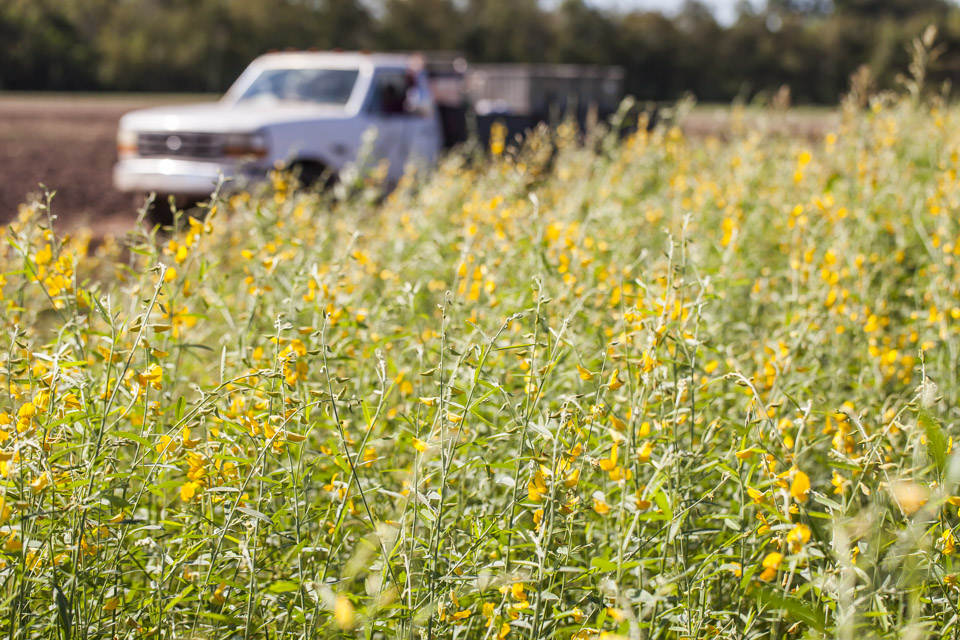 Photo by Scott David Gordon.
Photo by Scott David Gordon.
Carbon and nitrogen are in the soil, so when we till the soil, carbon is released into the environment as nitrogen is released into the soil simultaneously. When we use cover crops, we keep our carbon footprint net neutral since the plants pull carbon from the atmosphere, and absorbs it into the plant structure. When the cover crops are tilled, microorganisms within the soil feed on the raw organic matter and break it down. The composted and broken down remains of the cover crops is known as humus, which is rich in minerals essential for plant health. All of this maintains a healthy microbiome in the soil, and if you maintain this, it helps prevent diesase, and benefits the crops exponentially. Maintaining a healthy microbiome is a very important tenant in organic farming.
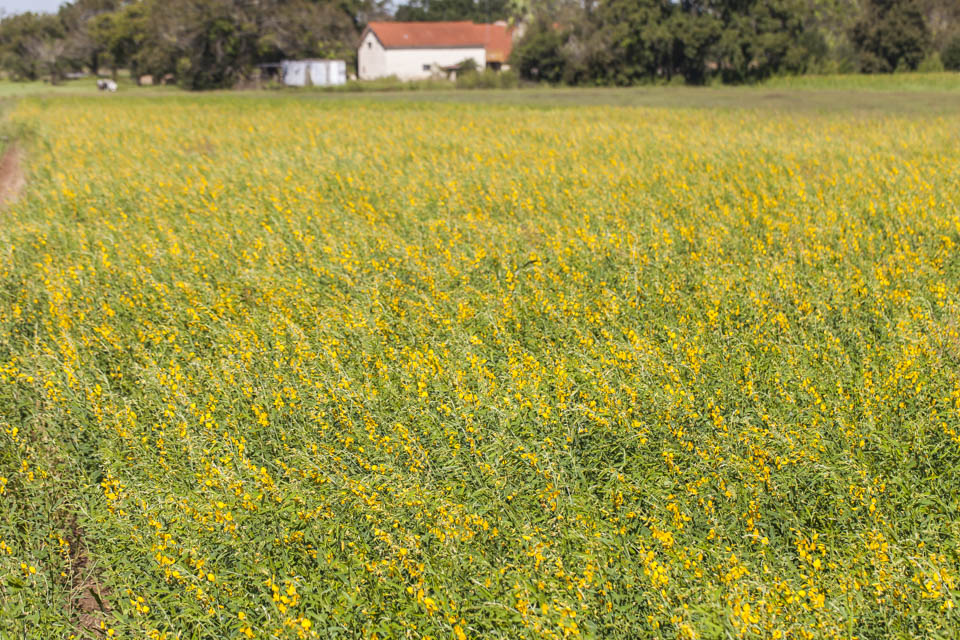 Photo by Scott David Gordon.
Photo by Scott David Gordon.
Cover crops also aids in water management. Water percolates more efficiently if there are root systems, plus the plants also trap surface water, reducing evaporation. Whereas, if you have hard, dry, cracked soil, the water oftentimes cannot easily infiltrate which can lead to flooding.
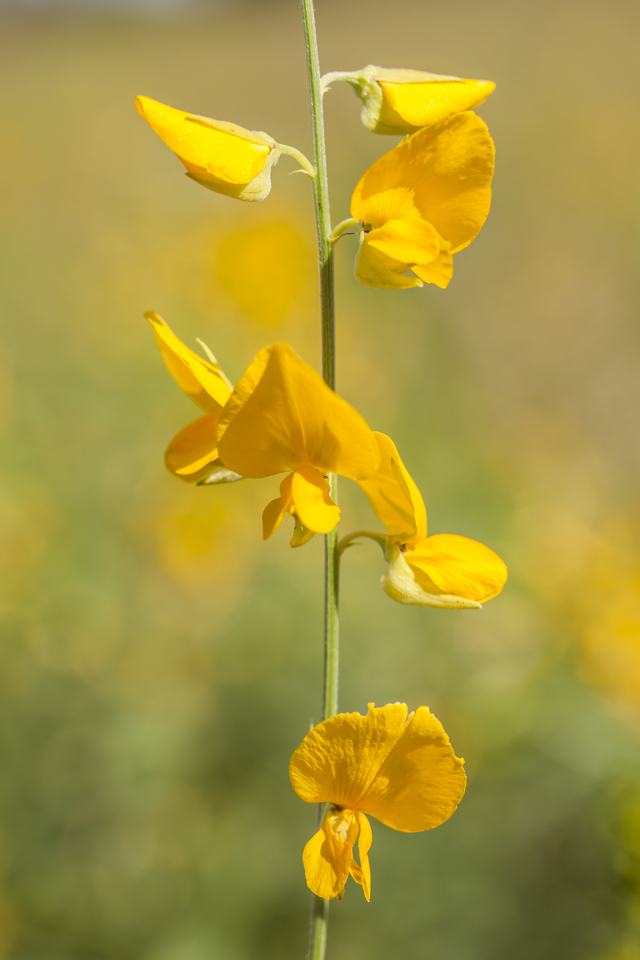 Photo by Scott David Gordon.
Photo by Scott David Gordon.
Additionally, another huge and underestimated perk of cover cropping is that they outcompete weeds to survive. Weeds cannot thrive in the shade that cover crops provide, which in turn reduces the amount of weeding that we have to do in the long run. The benefits of cover cropping abound! We hope that this shed some light on one of our most useful farming practices... 'til next time!






 0 ITEMS IN CART
0 ITEMS IN CART 

